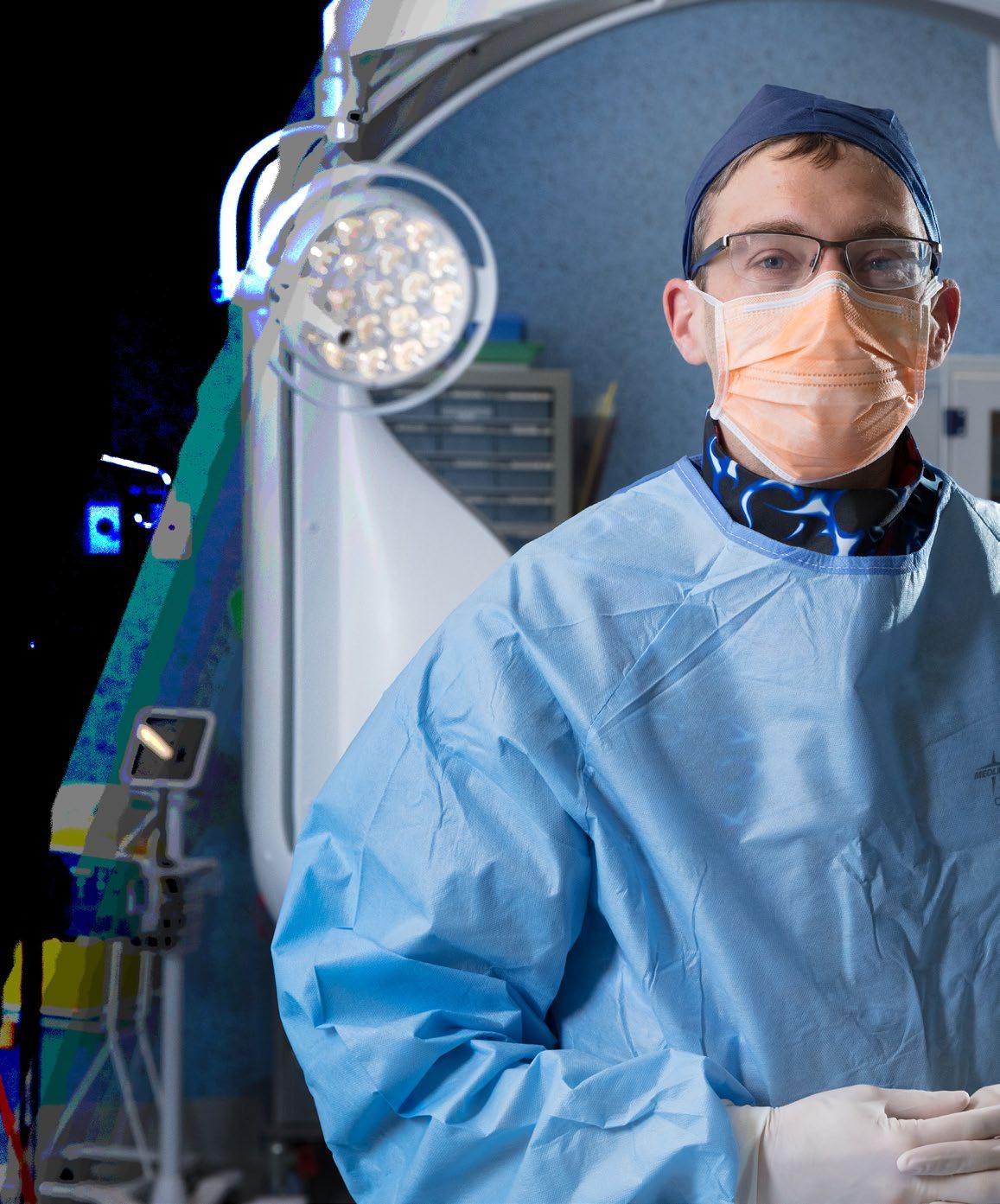




• Mark Wednesday 16 October in your diaries.
• Book your hospital foyer space.
National Anaesthesia Day is held each year to raise awareness of the crucial role anaesthetists play in healthcare. An ANZCA initiative, National Anaesthesia Day is usually held each year on 16 October to mark the anniversary of the day in 1846 that ether anaesthesia was first publicly demonstrated. This year our theme is fasting.
ANZCA will send posters and other material to hospitals in September. Please contact communications@anzca.edu.au for more information.


ANZCA Bulletin
The Australian and New Zealand College of Anaesthetists (ANZCA) is the professional medical body in Australia and New Zealand that conducts education, training and continuing professional development of anaesthetists and specialist pain medicine physicians. ANZCA and FPM comprise about 8900 fellows and 1950 trainees. mainly in Australia and New Zealand. It serves the community by upholding the highest standards of patient safety.
Medical editor: Dr Tanya Selak
Editor: Clea Hincks
Production editor: Liane Reynolds
Feature writer: Carolyn Jones
Advertising manager: Vivienne Forbes
Designer: Michelle Nightingale
We encourage the submission of letters, news and feature stories. Please contact Bulletin editor Clea Hincks at chincks@anzca.edu.au if you would like to contribute. Letters should be no more than 300 words and must contain your full name, address and telephone number. They may be edited for clarity and length. To advertise please contact communications@anzca.edu.au.
Copyright Copyright © 2024 by the Australian and New Zealand College of Anaesthetists, all rights reserved. None of the contents of this publication may be reproduced, stored in a retrieval system or transmitted in any form, by any means without the prior written permission of the publisher. Please note that any views or opinions expressed in this publication are solely those of the author and do not necessarily represent those of ANZCA. ISSN: 1038-0981 (print) 2206-5423 (online).
ANZCA may promote articles that appear in the Bulletin in other forums such as the ANZCA website and ANZCA social media platforms. Contact us
ANZCA, 630 St Kilda Road, Melbourne Victoria 3004, Australia +61 3 9510 6299 communications@anzca.edu.au www.anzca.edu.au
Faculty of Pain Medicine +61 3 8517 5337 fpm@anzca.edu.au
The ANZCA Bulletin has been printed on FSC certified paper using vegetable-based inks by Southern Impact under ISO14001environmental certification. It is fully recyclable.
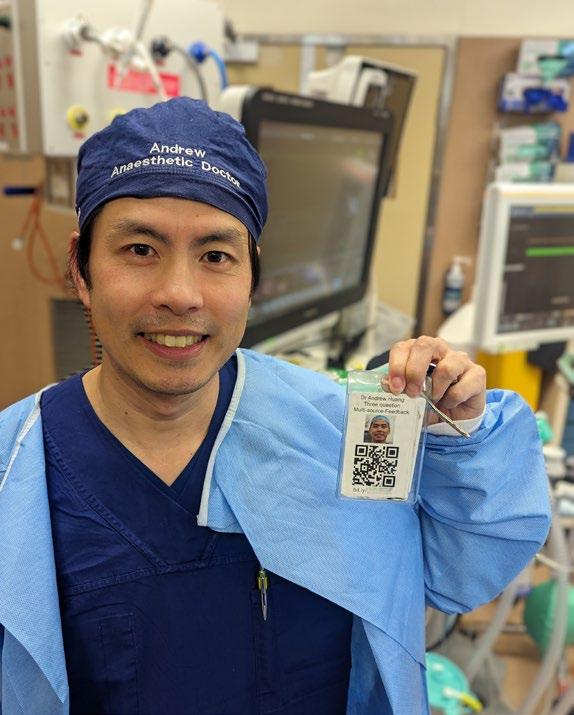

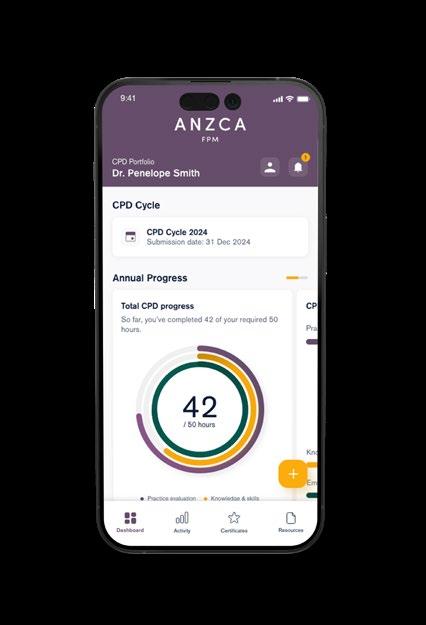


This is my last Bulletin article as president. After our May ANZCA Annual Scientific Meeting (ASM) in Brisbane I will be stepping down and returning to my relatively normal life. Writing these words marks the end of a two-year journey, and brings a mixed sense of emotions.
My role as president has been an incredible experience and I am grateful to the fellows, trainees, specialist international medical graduates (SIMGs) and ANZCA Council for giving me this opportunity and privilege.
In the months before stepping up I remember well my feelings of apprehension, wondering whether I could cope with the rigour and commitment the position demands. Living in Perth the distances and time differences across Australia and New Zealand are daunting but I needn’t have worried. The support I have received from the college, my work colleagues and council has been phenomenal. What are the highlights of my tenure? Here are just a few.
In-person engagement
I was lucky to begin my role in a post-COVID-19 world where the possibilities of travel, engagement and face-toface meetings were a reality again. Though we had become accustomed to Zoom, the benefits of meeting in person were immediately obvious.
One of my first memorable tasks was representing the college during our successful accreditation review from the Australian Medical Council (AMC) in 2022. The busy week was spent with the AMC accreditors and I recall how impressed I was when the ANZCA staff answered the accreditors’ questions comprehensively and knowledgeably. It was a great chance for me to meet and get to know many of the hard-working staff at the office.
The 2023 ASM in Sydney with its massive convocation and launch of our perioperative medicine qualification was another highlight. Combined with the Emerging Leaders Conference the ASMs are an incredibly busy time for the president with many speeches, sessions and engagements. Hard, but rewarding work – and great fun.
It has been satisfying to cautiously re-engage with our international colleges, including those in our region and our more traditional partners in the UK and Ireland. I can see there is value in re-establishing these collaborations in a careful and deliberate way to maximise the benefits for our college.
Another enjoyable presidential experience is visiting the regions and attending the regional committee meetings. The challenges of long-distance travel prevented me from attending as many as I would have liked but I enjoyed the visits I made. I was always impressed by the dedication of the
regional committees and, while local issues occupied much of the agenda, inevitably discussions came back to workforce in various guises.
I was also lucky to be part of council when we had our first meetings outside Melbourne.
Over the past two years, Wellington has been our regular September meeting venue and the opportunity to attend a Marae, organised by our New Zealand team last year, was a delightful experience.
We also recently travelled to Hobart for our February council meeting to formally open the new office, enjoy some hospitality on the balcony and meet some of the locals, including Uncle Dougie who provided a warm Welcome to Country.
Meeting of college presidents
One of the more interesting forums I was invited to as president is the Council of Presidents of Medical Colleges (CPMC), a regular gathering of the 16 presidents of the specialty medical colleges and their chief executive officers.
This – at times quirky – group of leaders were compelling, entertaining and sometimes frustrating. I enjoyed meeting and spending time with my fellow presidents though the two-year term is over just as you begin to recognise who’s who in the room.
There was often, but not always, consensus during discussions at CPMC which confirmed for me what a wellrun and progressive college we have. I hope we can use this forum more effectively in the future to manage the common pressures gathering around the specialty medical colleges.
ANZCA Council
Another less obvious highlight was the daunting role of chairing council.
ANZCA Council will have some new faces at its May meeting being held at the 2024 Annual Scientific Meeting in Brisbane.
Associate Professor David Sturgess (Queensland) and Dr Sarah Nicholson (New Zealand) were elected to join council in our recent ballot and ANZCA President Chris Cokis is returning. He will take up the role of immediate past president from May when President-Elect Professor David Story takes up the presidency.
All 15 councillors came to meetings well prepared, passionate and up for vigorous discussion and debate. We didn’t always agree but hopefully together made sound decisions in the best interests of our anaesthesia and pain medicine communities.
I am proud of the statement made by council and the Faculty of Pain Medicine Board supporting a Voice to Parliament but accept the outcome of the referendum.
More recently, reflecting on the responsibility of the college to respond to world events has been an interesting experience.
I have enjoyed working with FPM Dean Kieran Davis, who is also stepping down from the board and council and look forward to continuing our friendship in the future.
ANZCA staff and volunteers
One of the things I’ll miss most is my regular meetings with our CEO Nigel Fidgeon and the executive directors at ANZCA. They have provided valued friendship as well as wise counsel.
As a final word I would like to remind everyone the strength of the college depends on its people and we are lucky to have some of the best.
Volunteerism is waning so I am incredibly grateful to all those fellows, trainees and SIMGs who contribute their time, resources and energy toward improving healthcare and medical education.
While I am stepping away from the presidency I hope to remain part of the wonderful community that we have created.
I look forward to seeing many of you at our Brisbane ASM.
Dr Chris Cokis ANZCA President
Our new fellow councillor is Dr Adam Levin (Vic) and Dr Dilip Kapur (SA) joins ANZCA Council in his role as FPM dean.
We farewell Dr Vanessa Beavis (NZ), Dr Michael Jones (NSW), Dr Bridget Effeney (Qld) and Dr Kieran Davis (NZ) and Dr Katherine Gough (NSW).
Look out for the feature on the new ANZCA Council in the Winter edition of the Bulletin.
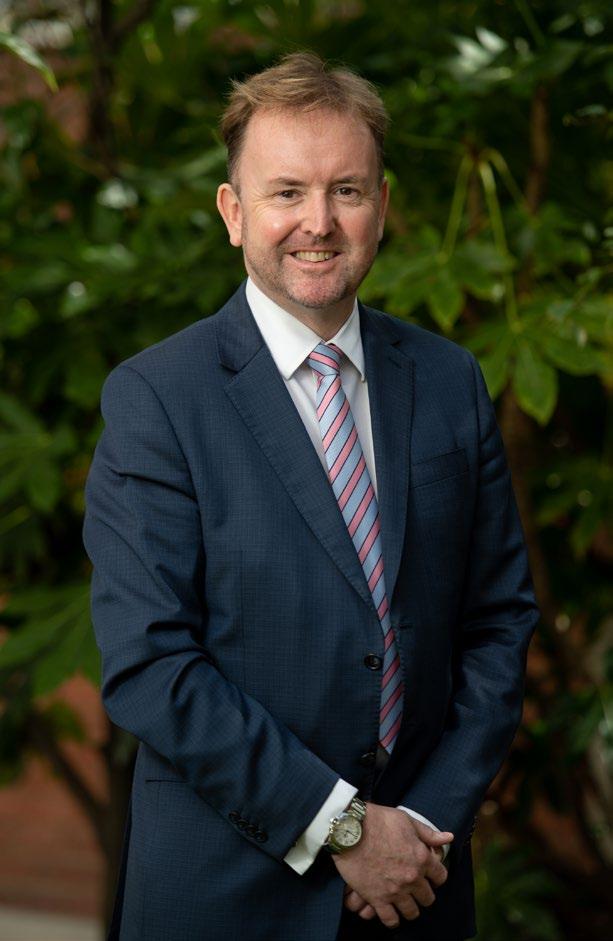
Post the pandemic the challenges for the health workforce have been significant.
Anaesthesia has not been immune to these challenges and is now singled out as one of the four specialties as being in shortage. This is becoming the focus of government as they now seek to implement reforms across the board, including bringing in more overseas trained specialists to address workforce needs.
ANZCA is actively involved in advocating and seeking to have influence in this landscape. Our focus continues to be on the safety and quality care of patients and maintaining high standards for our profession.
The work of the college continues and our staff are working hard to ensure the voice of our profession is heard and listened to. Our work in the policy arena has been a big focus.
Supporting our workers
Supporting our workforce to keep the work of the college up continues to be a priority and I am pleased to report that ANZCA’s gender pay gap (GPG) has reduced significantly in recent years and now sits at 19 per cent compared to 28.4 per cent in 2020-2021.
Addressing the gap
ANZCA has worked hard to address the gap by putting flexible working practices in place, for example, job sharing, hybrid working, offering part-time roles or compressed working weeks to support retaining our staff with primary caring responsibilities.
Other key commitments include adapting our recruitment strategy, encouraging personal development and career progression plans to promote talented women at ANZCA, changing our parental leave policy to eliminate primary and secondary carer status so men and women can access our parental leave and pay offerings.
We will continue to regularly monitor and carry out salary reviews and benchmarking across roles to ensure we pay equitable salaries irrespective of gender, engage with our staff on the issue and participate in appropriate networks and forums focussed on diversity, equity and inclusion.
See you at the Brisbane ASM
Interest in the ASM has been very high and the team at ANZCA is working hard to support our Regional Organising Committee in producing an exciting program in Brisbane from May 3-7.
The workshops are filling quickly as well as some of the other activities like the ANZCA ASM Gala Dinner.
I look forward to seeing as many of you as possible at our biggest scientific meeting on the calendar.
Nigel Fidgeon ANZCA Chief Executive Officer
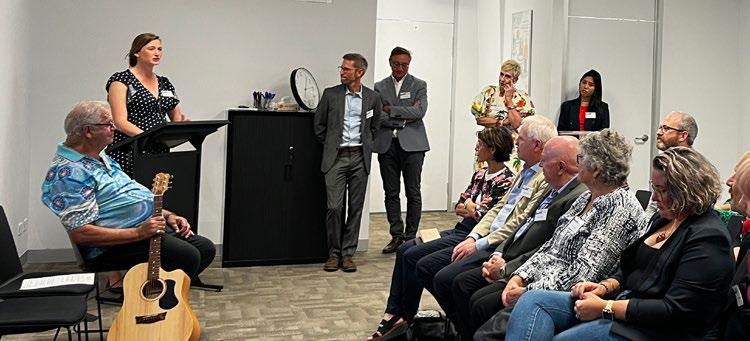
ANZCA’s Tasmanian office, located in Hobart’s hospital and university precinct, was officially opened in February.
ANZCA Council’s February meeting was held in the new office and on the Friday evening, guests gathered on the balcony of 142 Elizabeth St for a Welcome to Country by Uncle Dougie Mansell, and speeches, including from Tasmanian Regional Chair Dr Bruce Newman and ANZCA President Dr Chris Cokis.
A highlight of the evening was the presentation of the inaugural Dr Sandy Zalstein Award to the impressive Dr Lisa Allen who achieved the best result in Tasmania for the final exam in 2023.
The award was established in 2024 in memory of Dr Sandy Zundel Wolf Zalstein, an ANZCA fellow who made significant contributions to anaesthesia and the infrastructure for trauma and emergency medicine in Tasmania.
ANZCA is committed to fostering a culture of diversity, equity, and inclusion.
Embracing diverse perspectives and promoting fairness, respect, and equitable access to opportunities enhances our ability to provide high-quality care in anaesthesia, perioperative medicine and pain medicine.
Our statement on diversity, equity and inclusion
Our new statement on diversity, equity, and inclusion (DEI) reflects ANZCA’s commitment to creating and supporting a culture of inclusiveness.
Recently approved by ANZCA Council, the statement aims to help raise awareness and focus on the impact of equity, diversity and inclusion within the college community.
We advocate for an environment that ensures everyone feels safe, valued and protected from bullying, discrimination and harassment. We celebrate the broader perspectives and enriched innovation that diversity brings. We are dedicated to building a more inclusive and equitable culture for our workforce and the patients and communities we serve.
Supported by the ANZCA diversity, equity, and inclusion background paper, it aligns with the college’s statement on the role of ANZCA in “advocating for the health and wellbeing of all people”, and other college’s statements including the “Gender equity position statement” and the “Position statement on the health of people seeking asylum”.

DR VANESSA SHONA
BEAVIS CNZM FANZCA
Being appointed a Companion of the New Zealand Order of Merit (CNZM) for services to anaesthesia is just the latest in a long list of achievements for Dr Vanessa Beavis.
Dr Beavis, whose contribution to anaesthesia spans more than 30 years, is ANZCA’s Immediate Past President, having served in the role during the COVID-19 pandemic. She is one of the college leaders driving our new Chapter of Perioperative Medicine and will soon take up the role as director of professional affairs, assessor.
A member of the Court of Examiners for the final examinations from 2002 to 2014, Dr Beavis joined the New Zealand National Committee in 2004 and served as chair from 2008 to 2011.
Dr Beavis was founding chair of the Anaesthetists in Management Special Interest Group and Perioperative Medicine Special Interest Group and also drove the development of a new continuing professional development program. She has also chaired ANZCA’s Training Accreditation Committee.
She has promoted the importance of Te Tiriti o Waitangi within ANZCA, which has had benefits for the cultural inclusion of Australian First Nations people and Pacific peoples and was president when the college adopted a Māori name Te Whare Tohu o Te Hau Whakaora.
During the COVID-19 pandemic she led ANZCA to continue delivering examinations and maintain continuity and quality of training.
Outside ANZCA, Dr Beavis has held clinical leadership roles from 1997 at Auckland City Hospital and was director of Perioperative Services from 2004 to 2020. She helped establish the anaesthesia service in Auckland to provide New Zealand-based access for people requiring a liver transplant.
Dr Beavis was the inaugural Executive Committee Chair of the International Academy of Medical Colleges of Anaesthesiologists (IACA), which she helped develop and launch in 2021. She is also an honorary senior lecturer in the University of Auckland’s Faculty of Medical and Health Sciences.
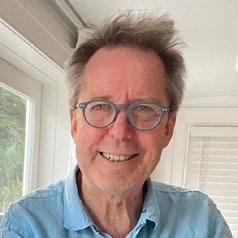
PROFESSOR BRIAN
JOSEPH ANDERSON
CNZM FANZCA
Professor Brian Anderson has been named a Companion of the New Zealand Order of Merit, for services to paediatrics and anaesthesia.
Professor Anderson, a paediatric anaesthetist and intensive care specialist, has advocated for and led the development of paediatric intensive care and anaesthesia in New Zealand for more than 30 years.
He was a founding consultant at Auckland’s Starship Hospital and is one of two doctors who co-established the hospital’s paediatric intensive care unit, which provides care for critically ill children throughout New Zealand and the Pacific.
He set up the hospital’s acute pain service, its resuscitation and trauma committee and played an important role starting Starship’s paediatric cardiac surgical unit.
He is Professor of Anaesthesiology at the University of Auckland and has taught, mentored and supervised junior doctors, nurses, students and researchers.
His research in children’s pharmacology has had a global impact. He has numerous publications in international journals and textbooks, as well as book and journal editorial contributions.
This body of work has informed clinical practice of paediatric drug use, anaesthesia, intensive care and pain medicine both in New Zealand and worldwide.
He is a member of international review and safety committees, grant assessment boards and sits on national advisory committees.
Professor Anderson has also volunteered to provide paediatric anaesthesia and intensive care assistance to surgical teams working in the Pacific.

DR RICHARD BAILEY AM FANZCA (NSW)
Dr Richard Bailey, after whom the Australian Society of Anaesthetists’ (ASA) Richard Bailey Library is named, has been appointed as a Member of the Order of Australia (AM) in the General Division, “for significant service to medicine in the field of anaesthetics and to professional societies”.
Dr Bailey spent many years as an anaesthetist in the cardiothoracic unit at St Vincent’s Hospital, Sydney and was a member of the Australian heart transplant team with the national transplant program for 30 years. He also helped with the development of a lung transplantation program.
Other professional milestones include working as part of the team that established a children’s airway surgical program at the Royal Alexandra Hospital for Children (now The Children’s Hospital at Westmead), a medical advisor for the Commonwealth Department of Veterans’ Affairs and an open-heart surgery anaesthetist at St Margaret’s Children’s Hospital in Sydney.
The ASA library was named in his honour in 1994 in recognition of more than four decades of honorary roles as the ASA librarian and archivist.
Dr Bailey was co-recipient of the David Zuck Memorial prize from the History of Anaesthesia Society in the UK in 2019 and is a life member of the NSW branch of the Australian and New Zealand Society of the History of Medicine.
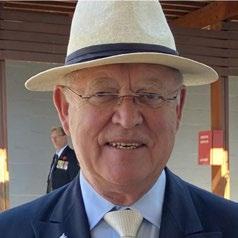
DR BRIAN PATRICK PEZZUTTI AM CSC FANZCA (NSW)
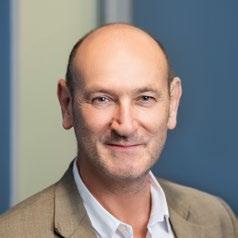
Professor Steven Faux, the Director of Rehabilitation and Pain Medicine at St Vincent’s Hospital, Sydney has been appointed as a Member of the Order of Australia (AM) in the General Division, “for significant service to rehabilitation medicine, and to medical research”.
He has been the co-lead of the hospital’s long COVID clinic since 2021 and is the current president-elect of the Rehabilitation Medicine Society of Australia and New Zealand.
Professor Faux has an extensive research record notably as chief/associate investigator for 18 research grants applications for the Australian Research Council and National Health and Medical Research Council. He has authored more than 100 journal articles and established the first telehealth pain management clinic in Australia (with Reboot Online).
His academic appointments at the University of NSW include: Conjoint Professor in Clinical Medicine, School of Medicine and School of Public Health and Community Medicine, since 2020 and Foundation Member, National Facility for Human Robot Interaction Research.
He has been a peer reviewer for several publications including the Medical Journal of Australia, Archives of Physical Medicine and Rehabilitation, Journal of Rehabilitation Medicine; Journal of Rehabilitation Nursing, Clinical Rehabilitation and Neurotherapeutics
Dr Brian Pezzutti has been appointed a Member of the Order of Australia (AM) in the General Division “for significant service to the Parliament of New South Wales, and to community health.”
A member of the NSW Legislative Council from 1989-2003 where he served as Parliamentary Secretary for Health from 1993-1995, Dr Pezzutti is a former chair and board member of the Northern NSW Local Health District. While serving in the NSW Parliament Dr Pezzutti sat on various parliamentary committees including as chair of the Mental Health Select Committee and as a member of the Health Care Complaints Commission.
He worked as a specialist anaesthetist between 1976 and 2017 and was appointed assistant Surgeon- General in the Australian Defence Force (ADF) from 2000-2004.
He deployed to Rwanda as part of the Australian contingent under the banner of the United Nations in July-August 1995 and in July 1998 in Bougainville. He also served in East Timor and Iraq and was a civilian member of the combined Australian surgical team sent to Aceh to assist victims of the Boxing Day tsunami in 2004/ 2005.
He was awarded the Conspicuous Service Cross in 2009.

When Dr Graham Grant started practising as an anaesthetist in the UK in the 1960s he had already established himself in his first career as an engineer of medical equipment.
After completing an engineering degree at the University of Sydney he travelled to the UK where he graduated in medicine after attending St Mary’s Hospital Medical School in London.
Now aged 90, he has been appointed an Officer of the Order of Australia (AO) in the 2024 Australia Day Honours list for “distinguished service to biomedical engineering as a pioneer of innovative equipment development, and to medicine.”
Dr Grant is responsible for the development of anaesthesia equipment over many years, including the Grant Humidifier and the Grant Respiration Assistor, as well as other healthcare devices and resources.
Many of his inventions were developed while he continued practising as an anaesthetist in private and public practice in Sydney. He retired from the specialty in 2006 having established a reputation as a prolific inventor of anaesthesia and other specialty devices.
Dr Grant’s first invention in 1959 was a “weighing bed” for Sydney Hospital and his last in 2002 was a low-cost respiration airway monitor. One of the earliest of his many inventions was a portable incubator for premature babies, which saved them from dying in freezing winter temperatures during transportation to hospitals in the UK.
Some of his other inventions include a safety drug administration needle (1991), a portable electric anaesthesia ventilator (1982) and a laryngoscope (1977).
Dr Grant says while he has formally stepped back from inventing devices “the mind never stops.”
He has been a jazz pianist since the 1950s and only stopped performing at a local restaurant a few years ago.
“When I look back on some of my inventions they almost seem a bit passé now because everything is done with computer chips and increasingly, artificial intelligence.”
Asked to nominate a “Grant” invention that he believes has had the most impact he highlighted the portable incubator.
“I suppose in its day the portable incubator I invented did save a lot of lives of premature babies in the 10 years between 1960 and 1970. That really did make a difference to how premature babies were treated.”

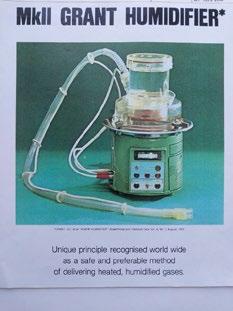
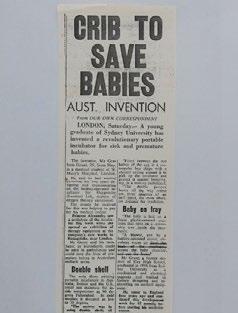
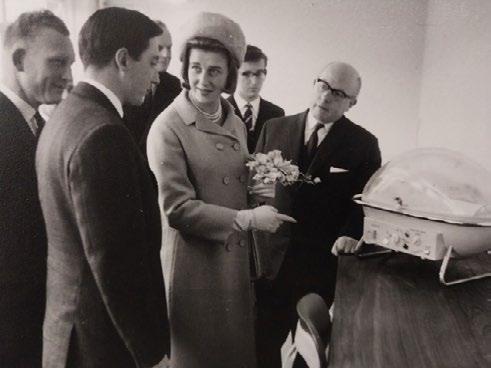
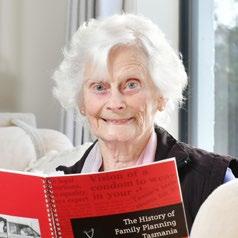
Australia Day honours recipient Dr Mary Kille recalls how she was among the last cohort of anaesthetists who were trained in open ether.
Born in Wolverhampton in the UK she completed her medical degree in the Midlands and recalls being “thrown into anaesthetics” in 1958.
Dr Kille, now 91 and living in north-west Tasmania, has been appointed a Member of the Order of Australia (AM) for “significant service to public health and to the community.” While her award is in recognition of her decades of commitment to Family Planning Tasmania she has fond memories of her anaesthesia career in the state.
She worked as a consultant anaesthetist from 1974-1986 at Northwest Regional Hospital in Burnie.
She and her husband John, a urologist, moved to Tasmania from the UK in 1973. She had worked as an anaesthetist and in family planning settings at hospitals in the UK including in Birmingham, Stoke-on-Trent and Hull before she and John settled in Burnie.
“Occasionally we would find ourselves in the same operating theatre – me at the head and he at the other end so I have some fond memories of my time in theatre.”
It was while she was working as an anaesthetist in Burnie that she set up the hospital’s’ first family planning clinic. She also played a leading role in guiding and teaching police and doctors about the treatment of sexual assault cases.
Dr Kille told the Burnie Advocate there was no protection or support for victims who faced intrusive examinations from police.
“We were able to develop a protocol and work with the forensic people, then after that we started recruiting doctors. It was a matter of teaching these doctors to have self-respect and to trust the fact that they could contribute by tying up the evidence, by describing injuries and by taking the specimens to a protocol.”
ABOVE
Dr Kille now enjoys writing poetry – she has published three books of her work – and continues to be a keen enthusiast of medical history.
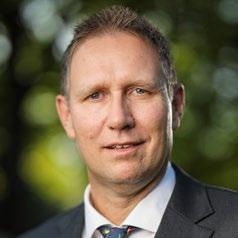
DR RICHARD HARRIS SC OAM FANZCA
Anaesthetist and former Australian of the Year Dr Richard Harris has been appointed the next Lieutenant Governor of South Australia.
Dr Harris will serve as deputy to South Australia’s Governor, Frances Adamson. The Lieutenant Governor acts as the state’s Vice Regal representative in the absence of the Governor.
Dr Harris is best known for being part of the Thai cave rescue team mission in 2018 for which he and fellow diver Dr Craig Challen were named joint Australian of the Year in 2019. Both received the Star of Courage, Australia’s second highest bravery award, in 2018.
In a recent interview on ABC Radio Adelaide Dr Harris said he retired from practising anaesthesia in 2022 after more than 30 years. He is now writing children’s books (Alfie the Brave and Alfie the Kind) and has continued with his public speaking roles. Film making is another passion. He revealed that he been carrying a camera underwater on his cave dives since he was 15 years old.
South Australian Premier Peter Malinauskas described Dr Harris as a “hero in every sense of the word”.
“Dr Harris has dedicated his life to helping others and I have every confidence he will serve our state with distinction as the new Lieutenant Governor of South Australia.”
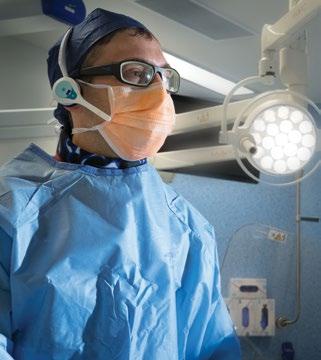
avant.org.au/practitionersareissuedbyAvantInsuranceLimited,ABN82003707471,AFSL238765.Pleasereadthe availableatavant.org.aubeforedecidingwhethertoacquire,orcontinuetoholdtheproduct.
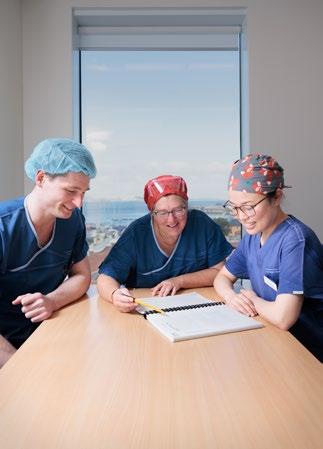
I can help Professor MacPherson (ANZCA Bulletin Spring 2023) in his quest to find the contribution of medical nitrous oxide (N20) to the climate crisis and the reasons for reducing its use in our daily practice.
In 2002 I completed a research project for my Master of Environmental Management at UNSW. The project “Nitrous Oxide, Anaesthesia and the Enhanced Greenhouse Effect”, doubled as my FANZCA fellowship formal project. Sadly, I never sought to have the research published but it passed with high distinction.
I had contacted all the providers of medical N20 used in Australia and determined that the total volume of N20 supplied for medical use in the year to May 2002 was 0.325 x 109 litres (0.000594 million tonnes), a figure which encompassed all medical uses including labour wards and veterinary clinics.
Total anthropogenic N20 emissions in Australia were about 0.1 million tonnes in 20001. Professor MacPherson is correct in that 80 per cent of those emissions came from agriculture. So medical N20 was only responsible for 0.5 per cent of Australia’s N20 emissions way back then. Using the global budget of N202, I determined that this contributed to a maximum of 0.0001% of radiative warming due to worldwide N20 emissions.
So, if the effect is so small, why bother?
First, “why not?” I haven’t used N20 in adults since 2002 and there have been no adverse implications for my patients or my practice.
Second, in order to achieve the deep emissions cuts urgently required, UN Secretary General António Guterres has called
on “every country, city, financial institution and company around the world” to adopt the objective of carbon neutrality.3 This call includes the healthcare sector. Removing N20, and desflurane from our daily practice takes us one step closer to net zero in the healthcare sector.
If we clinicians can show leadership in society’s quest to reduce greenhouse gas emissions then others will follow.
I agree with Professor MacPherson that there is only a very small immediate climate reward from eliminating N20 use from adult anaesthetic practice. But I don’t agree that it requires a lot of effort and I believe it will lead to bigger rewards in time.
Next time you reach for the N20 dial, stop yourself and leave it set to zero.
Dr Stephen Lightfoot, FANZCA
St George Private Hospital, Sydney
References
1. Australian Greenhouse Office. Australia’s Third National Communication on Climate Change: A Report Under the United Nations Framework Convention on Climate Change. Australian Greenhouse Office, 2002 https://play.google.com/store/books/ details?id=AhDJAQAACAAJ.
2. Kroeze C, Mosier A, Bouwman L. Closing the global N2O budget: A retrospective analysis 1500–1994. Global Biogeochem Cycles 1999; 13: 1–8.
3. Baste IA, Watson RT, Brauman KI, Samper C, Walzer C. Making peace with nature: a scientific blueprint to tackle the climate, biodiversity and pollution emergencies. UNEP, 2021 https://www. unep.org/resources/making-peace-nature.
I am corresponding as a concerned fellow. The purpose of the college is, according to its own strategy plan, “to serve our communities by leading high-quality care in anaesthesia, perioperative and pain medicine, optimising health and reducing the burden of pain”.
Unfortunately, I believe our college is failing to do this for the 30 per cent of the population that live in Modified Monash Model 3 and beyond. We are producing specialists that predominantly live (84 per cent) in metropolitan settings.
If ANZCA is to meet its new strategic plan there need to be changes in training to enable trainees to live, work and train regionally. A flipped model like the Victorian Regional Training Network needs to be embraced. The accreditation of regional hospitals needs to be changed to meet this change. For too long we have relied on the outdated hub and spoke model based on the centre of training being a tertiary metropolitan hospital. There is great evidence that rural origin of trainees, attending a rural medical school and rural prevocational training leads to greater rural retention. This should be extended to vocational training.
The current rural generalist program is a beacon of light in this landscape of regional, rural and remote health education and ultimately service provision. It meets most of the eight foundational principles outlined by Ostini et al1 for building a sustainable rural medical workforce.
1. Grow your own “connected to” place.
2. Select trainees invested in rural practice.
3. Ground training in community need.
4. Rural immersion – not exposure.
5. Optimise and invest in generalist training.
6. Include service and academic learning.
7. Join up the steps in rural training.
8. Plan sustainable specialist roles.
The fourth principle is not met as a lot of rural generalist training occurs in a metropolitan setting.
Could the ANZCA executive please consider changes to accreditation and training pathways for training to become a fellow to occur in a specifically rural context to meet an unmet need?
Associate Professor Rob Dawson, FANZCA
Anaesthesia, perioperative medicine and acute pain specialist Latrobe Regional Hospital, Traralgon Vic
Reference
1. Ostini et al. MJA 2021 dio:10.5694/mja2.51122
I read with interest the article in the Summer 2023 edition of the ANZCA Bulletin by Dr Markman1 and his efforts to set up the SipTilSend Network Australia and New Zealand. In response I would like to suggest to the Bulletin readership that it is surely now time to call for an ANZCA National Anaesthesia Day campaign to be dedicated to best practice in preoperative fasting.
It is almost 10 years since my article in the Bulletin2 calling for the “Nil by Mouth from Midnight” dogma to be run out of hospitals. My then request for a National Anaesthesia Day campaign was politely declined however the publication of an ANZCA fasting guideline in the appendix to PS7 in 2017 and its update to PG07(A) 20233 shows enormous progress by the college on this topic.
An editorial by Hewson and Moppett4 in the British Journal of Anaesthesia in 2020 lamented the failure to translate 30 years of preoperative fasting research into meaningful change in clinical practice, an article that resonated with me as I have spent a decade trying to change fasting rituals in a 100 bed hospital in rural NSW. The early days were undermined by
surgical juniors rotating from larger metropolitan hospitals who still preached “nil by mouth” from midnight. However, these attitudes have slowly changed as more hospitals move to encouraging liquids on the day of surgery to closer to the two hour mark.
One of the last groups to try and convince are the patients, many of whom have had several anaesthetics in their lifetime and have always been told to starve themselves. Some patients take a lot of convincing and still don’t really follow the advice to keep drinking on the day.
Clear liquids on the day of surgery isn’t just a nice thing to do for our patients, it’s the safer thing to do. ANZCA’s National Anaesthesia Day campaign is an ideal opportunity for us as a profession to speak directly to our patients and the general public to promote best practice and safe anaesthesia. Preoperative fasting, I believe, is an ideal topic.
Dr David Rowe, FANZCA Department of Anaesthesia, Armidale Rural Referral Hospital
*Editor’s note: Coincidentally, ANZCA’s Professional Affairs Executive Committee met in March and agreed on preoperative fasting as the theme for our 2024 National Anaesthesia Day.
References
1. Markman. SipTilSend: commentary from a national perspective. ANZCA Bulletin Summer 2023:31-33
2. Rowe. Fasting not starving before an anaesthetic. ANZCA Bulletin Sept 2015:24-25
3. PG07(A) Guideline on pre-anaesthesia consultation and patient preparation Appendix 1 2023. ANZCA website
4. Hewson & Moppett. Preoperative fasting and the prevention of pulmonary aspiration in adults: research feast, quality improvement famine. British Journal of Anaesthesia, 124(4):361-363(2020)
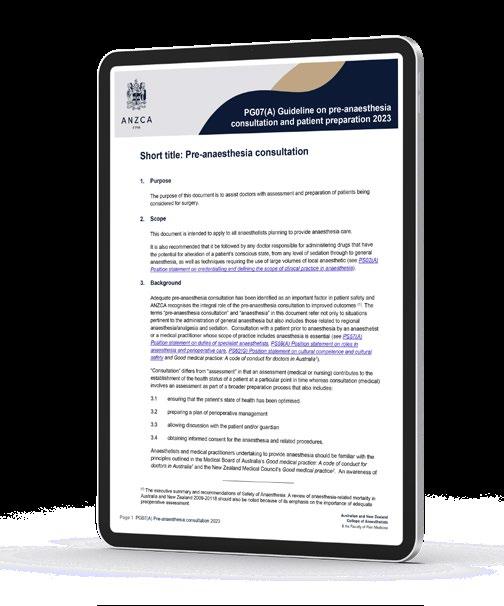
TRIPLE EXAM SUCCESS FOR NORTH QUEENSLAND ANAESTHETISTS
The Townsville Bulletin reported on the success of three Townsville-based anaesthesia trainees who passed their primary ANZCA exams after a long road of study. The 21 January article said Jackson Cowan, Zachary Lovelady and Laura White all passed the difficult exam on their first attempt with Dr Cowan the only Queensland doctor awarded a merit for the exam.

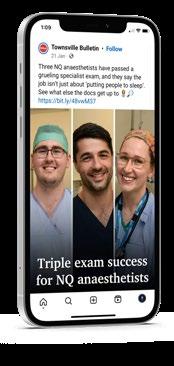
The article said the ANZCA primary exam is the second last test a doctor must pass before they’re named “specialist anaesthetist”.
FANZCA DR RICHARD HARRIS APPOINTED SOUTH AUSTRALIA’S LIEUTENANT GOVERNOR
Thai cave rescue hero and former Australian of the Year, anaesthetist Dr Richard Harris, was named as South Australia’s new Lieutenant Governor by South Australian Premier Peter Malinauskas on 25 January. Dr Harris will serve as deputy to South Australia’s Governor, Frances Adamson. The Lieutenant Governor acts as the state’s Vice Regal representative in the absence of the Governor.
The post received more than 1000 impressions, 61 engagements and 20 link clicks.
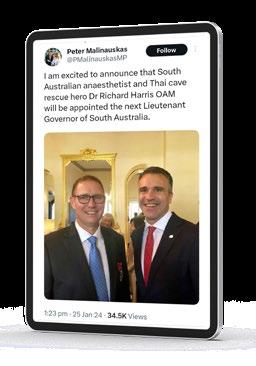
LOLIPOP TRIAL FUNDING WIN
The Australian-led LOLIPOP (Lidocaine and chronic post-surgical pain in breast cancer surgery) trial has received $A3.8 million from the UK’s National Institute for Health and Care Research. The trial aims to reduce post-surgical pain for breast cancer patients. The team is led by deputy chair of the ANZCA Clinical Trials Network, Professor Tomás Corcoran.

The success of the LOLIPOP UK grant led by Perthbased anaesthetist Associate Professor Andrew Toner is a result of a collaboration between the Australian study team and UK investigators with Associate Professor Mark Edwards at University Hospital Southampton NHS Foundation Trust and Bristol Trials Centre at the University of Bristol. An ANZCA 5 February media release announced the UK trial funding.
ANZCA’s Instagram post on 4 February reached more than 1100 accounts and had nearly 40 engagements.
IPSWICH HOSPITAL JOINS POM COURSE
The anaesthesia team at Ipswich Hospital in Queensland was featured in a page 3 article in Ipswich News Today on 14 December. The article highlighted the hospital’s involvement in ANZCA’s perioperative medicine course in 2024. Ipswich Hospital Deputy Director of Anaesthesia Dr Hannah Brown said involvement in the ANZCA course was recognition of the hospital’s proud track record of providing high-quality perioperative care.
“The clinical immersion sites have been selected for their dedication to perioperative medicine excellence, patient care and advanced medical techniques, so to be the only Queensland Health hospital chosen is testament to Ipswich Hospital’s first-class care and staff,” she explained.
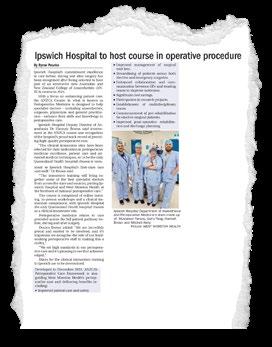

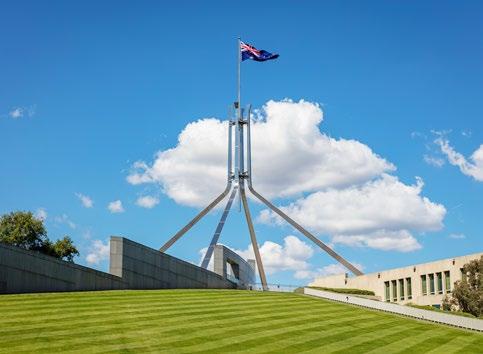

We work with national, state and territory governments and their agencies to ensure we're appropriately consulted on decisions affecting our members; the health systems they work within; and their ability to provide every patient with safe, high-quality, and culturally competent care.
Workforce continues to be a priority issue for governments in 2024 and a priority for the college.
As part of our role to continue to advocate for fellows, trainees and specialist international medical graduates, we recently attended a meeting with the National Health Practitioner Ombudsman, the Health Workforce Taskforce and Australian Medical Council to discuss the implementation of recommendation from two recent reports – the Independent review of overseas health practitioner regulatory settings and the Roadmap for greater transparency and accountability in specialist medical training site accreditation.
The college will continue to progress the relevant recommendations and monitor how these align with recommendations from our 2022 Australian Medical Council reaccreditation. Meetings were also held in late 2023 with representatives from the Health Workforce Division at the Department of Health and Aged Care to discuss progress and 2024 priorities for the National Medical Workforce Strategy 2021-2031.
The Health Workforce Taskforce comprises health workforce representatives from health departments from each state and territory and the Australian government. Chaired by Ms Susan Pearce AM, Secretary NSW Health, the taskforce provides health workforce advice to the Health Ministers’ Meeting (state and territory government ministers with health portfolios and the federal Minister for Health and Aged Care) and the Health Chief Executives Forum (health department CEOs from each state and territory and the Australian government).
The college’s federally funded Specialist Training Program continues to grow with a further successful Flexible Approaches to Training in Extended Settings (FATES) proposal in 2024 to develop flexible accreditation pathways for pain medicine training in rural settings. Valued at around $A425,000 over two years, the project will develop and pilot flexible models of pain medicine accreditation in regional and rural locations.
The college participated in a National Rural Surgeons Training and Retention Workshop with the Rural Health Commissioner, Adjunct Professor Ruth Stewart, on 9 February.
Facilitated by Professor Brendan Murphy AC, the priority recommendations developed in the workshop will inform work being led by the Royal Australasian College of Surgeons (RACS) as part of a FATES project to develop rural training models, looking at potential solutions such as hub and node training networks and remote supervision.
ANZCA, the Royal Australasian College of Physicians (RACP), the Royal Australasian College of Medical Administrators (RACMA) and the Royal Australian and New Zealand College of Ophthalmologists (RANZCO) are consortium partners with RACS on the project.
The chair of the ANZCA Environmental Sustainability Network, Dr Archana Shrivathsa, fellows and college staff attended a meeting on 9 February with the Department of Health and Aged Care to discuss reducing emissions from anaesthetic gases, as part of the implementation of the National Health and Climate Strategy. The meeting included 30 attendees from 10 medical colleges.
The college is in the process of providing associated written feedback on a range of questions requested by the department, to understand clinical perspectives and challenges in relation to the use of desflurane and nitrous oxide. A roundtable on desflurane with states and territories and other stakeholders is likely to occur in April 2024. NSW Health and WA Health have recently removed desflurane from public hospital formularies.
The recent election in New Zealand delivered a coalition government made up of the National Party, led by Christopher Luxon, and his ACT New Zealand and New Zealand First partners. While some health system changes (such as the abolition of Te Aka Whai Ora/Māori Health Authority) were well signalled pre-election, the repeal under urgency, and without health select committee scrutiny, of the smoke-free legislation was a surprise. ANZCA, as a member of the Council of Medical Colleges (CMC) has advocated strongly against this move.
Further health services restructuring, new health targets, and a reduced emphasis on health equity or on the social determinants of health are all expected. Associate health minister David Seymour has indicated that lowering

barriers to the immigration and employment of international medical graduates, a review of health workforce regulation, institution of new cadres of health professionals and widening of scopes of practice are all under consideration as solutions to medical health workforce shortages. ANZCA is keeping a close watching brief on these developments and will advocate as required.
Work is progressing on many fronts on the strategy to give effect to Te Tiriti o Waitangi and to support staff, committees, fellows, trainees and specialist international medical graduates as the college implements initiatives to ensure we meet the requirements of the Medical Council of New Zealand and the Council of Medical Colleges/Te ORA Cultural Safety Training Framework.
The project is taking a co-design approach, building on the Australasian College for Emergency Medicine (ACEM) Rautaki Manaaki Mana, using consultation by survey and key informant interviews with Māori members and input from the Indigenous Health Committee to adapt that strategy for our college and prioritise elements of an action plan. A meeting with Māori Anaesthetists Network Aotearoa (MANA) to wananga (workshop) scenarios for educational simulations is being planned.
The college prepares submissions and makes representations to government and other stakeholders on a range of policy initiatives and inquiries, many of these in response to requests for college feedback and input. Our submissions to public inquiries are available on the college website following the inquiry closing date. Note that some inquiries and requests for college input are confidential. For a listing of recent submissions visit www.anzca.edu.au/safety-advocacy/advocacy
Australia
Australian Government Department of the Prime Minister and Cabinet: Commonwealth government COVID-19 response inquiry.
Department of Health and Aged Care: Medicare Benefits Schedule (MBS) 85% rebate project.
Department of Transport and Main Roads (Queensland): Cannabis and driving.
Senate Standing Committee on Community Affairs: Inquiry into issues relating to menopause and perimenopause.
New Zealand
Pharmac: Funding of 10ml lidocaine ampules for palliative care.


Our professional documents, statements and guidelines are crucial for promoting the safety and quality of patient care for those undergoing anaesthesia for surgical and other procedures and for those receiving pain medicine treatment.
A case of anaphylaxis recently confronted retiring anaesthetist and former “What would you do?” columnist, Dr Peter Roessler. This is “What Pete did”, thanks largely to the clinical application of ANZCA’s “prof docs”.

Professional Documents has been made very much more comforting with the baton having been passed on to two very capable and highly suited successors.
As the immediate past DPA, I have had cause to reflect on prof docs as a resource and their role in the standard and quality of care we provide for our patients.
When I started as a consultant staff anaesthetist in 1980, the only guidance documents available were those associated with the then focus of the faculty of anaesthetists, which was training. They were written as requirements to be met for training institutions to be accredited, and although I was aware of them, they did not play a major role in my professional practice.
My, how things have changed! With the transition from a faculty to a college ANZCA foresaw the potential value of promoting and supporting professional performance, thereby extending its remit beyond trainees to specialists.

To its credit, the college allocated resources and funding to appoint DPAs as well as providing the all-important staff support.
The governance by ANZCA Council and FPM Board ensures that applicable committees act as oversight committees for the development and review of these documents. The task of development/review is heavily reliant on the fellowship, community representatives and stakeholders, and is guided by the DPA.
Against this background, I would like to illustrate the enormous value and benefit of our prof docs in a recent clinical event in my personal practice.
The event was a grade four anaphylaxis in one of the private hospitals on the picturesque Victorian peninsula. The timing of this event in my career was somewhat ironic in that my first case of anaphylaxis was a grade two suxamethonium anaphylaxis at the start of my specialist career as a new consultant in a major teaching hospital in 1980 (last millennium).
The current event occurred in the final year of my career as I am about to retire from clinical practice this year. Although these events are separated by millennia, is there a message here?
On the first occasion there were no professional documents guiding anaphylaxis management, there was no continuing professional development (CPD), and there were no emergency response workshops. However, the value of experienced assistance was promoted even then, and consequently, I kidnapped one of my ATY4 trainees on that occasion.
Four decades later we have management guidelines, CPD, and CPD emergency response workshops to help keep our skills honed and knowledge updated. The key messages that I have gleaned from the guidelines and workshops include the following essential skills and behaviour:
• Early recognition of deteriorating patients.
• Early initiation of cardiopulmonary resuscitation.
• Early call for assistance and co-ordinated teamwork.
• Implementation of guideline recommendations. In this instance, after administration of pre-induction medications and commencement of induction there was a rapid deterioration in circulation and the appearance of significant ST-elevation on an electrocardiogram. First thoughts at this stage were either ischaemic cardiac event or anaphylaxis.
With the rapidity of the crisis chest compression was commenced and the emergency buzzer activated. The nursing staff and theatre technicians sprang into action while the airway was secured, and ventilation commenced. The first three critical actions in the dot points above were accomplished within 30 seconds.
My anaesthesia colleagues from the adjacent three theatres all appeared almost immediately and contributed to the sense of calm through their controlled participation and adopting individual resuscitative tasks as well as offering suggestions. They worked closely with the theatre staff and the teamwork could not have been better.
The presence of pulseless electrical activity was identified, and speedy discussion ensued to establish the most likely diagnosis as being anaphylaxis to ceftriaxone. At this point there was a call for the Anaphylaxis Management Cognitive Aid. I felt a great sense of satisfaction at the acknowledgement and acceptance of our prof docs as validation of the efforts in their production.
Although I had completed the anaphylaxis CPD emergency response activity and had been involved in the development/ review of the guideline, its ready availability facilitated the management and aided in maintaining an air of calm control.
The outcome in this case was in keeping with the reported Sixth National Audit Project of the Royal College of Anaesthetists (NAP6) outcomes with 70 per cent survival when the above dot points as described in the relevant prof docs are addressed.
One departure from the guidelines was my avoidance of the use of vasoconstrictors to manage hypotension, especially in the presence of ST-elevation. My rationale behind this thinking can be found in my article in the recent edition of Australasian Anaesthesia
However, it goes to the point that guidelines are advisory and as per the disclaimer accompanying each of the guidelines “…it is the responsibility of each practitioner to have express regard to the particular circumstances of each case …”. Although, it goes without saying that deviations from the guideline require solid reasoning and justification.
The patient, I am happy to say, recovered well and rang me after discharge from the intensive care unit to thank me. Being a somewhat facetious person, it made me wonder about the return of their cognitive function! They were intrigued to learn of the people that participated in his rescue and the teamwork that was required.
I would like to take this opportunity to thank my three colleagues and acknowledge them for their much appreciated and invaluable assistance. Dr Laurie Dwyer, Dr Daniel Stiglitz and Dr Robert Wengritzky acted in a united, collaborative and collegial manner and were instrumental in this outcome.
Thank you, prof docs, for being there when I needed you and for helping me to keep a clean slate during my career.
Dr Peter Roessler, FANZCA

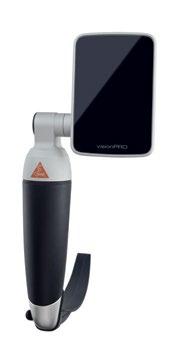
The HEINE visionPRO video laryngoscope.
For fast and reliable intubation, nothing is more important than the best view of the glottis. The HEINE visionPRO video laryngoscope provides just that with the one of a kind HEINE allBRIGHT display –even in very bright ambient light.
At the same time, the HEINE visionPRO is extremely robust, reliable and durable. To be as environmentally friendly as possible, we chose a rechargeable lithium battery and are the first to provide a blade made from upcycled material. More on heine.com
Scan here to request demonstration.

Our world-leading ANZCA and FPM Continuing Professional Development program ensures patients receive cutting edge care from their specialist anaesthetist and specialist pain medicine physicians.
Our thanks to fellows and continuing professional development (CPD) participants who have participated in our new CPD app workshops and provided valuable feedback on the CPD experience. Thank you to the 70 fellows and CPD participants for volunteering to be part of the user testing, which is expected to start on 10 April. If you’re interested in getting involved, check out our website news item.
The app is due to launch at this year's ASM in Brisbane. The CPD app will complement your online CPD portfolio and enhance the way you record, monitor, and provide evidence for your completed CPD activities.




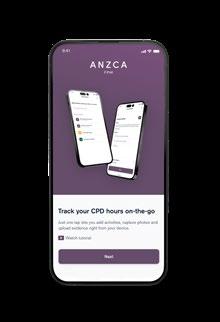

The college has a proud history of delivering a world-leading online CPD program, and we will continue to enhance the program as your trusted CPD home. More than 7000 participants, including ANZCA fellows, non-fellows, FPM fellows and overseas-based fellows, chose the ANZCA and FPM CPD Program as their CPD home in 2023.
The CPD team is always on hand to support your CPD queries.
Whether you’ve just started the annual program or are into your second cycle, we’ve put together a list of helpful resources to set you up for success in 2024.
CPD handbook and activity guide

The updated CPD handbook and new CPD activity guide summarise program requirements, CPD activities and accepted evidence. The handbook and activity guide also outline the 13 new CPD activities added to the program from 1 January 2024.
How can I meet CPD requirements for my type of practice? Dedicated webpages are available so you can find case studies, guidance, and support resources for different contexts to help you meet requirements. This includes the page “I work in anaesthesia practice in the private sector”.
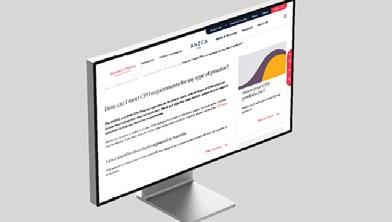
New Library guide – CPD for clinical support roles
This new library guide is designed to help fellows and other CPD participants match CPD activities with the nature of the work roles that they undertake.
The guide is also useful if you have clinical support roles alongside your work with patients and for those who practise without direct patient care.

New guidelines and forms webpage

Wanted to do a CPD activity but could not find the forms? Find all the forms, guidelines and other resources you need to complete your CPD in one central location.
The CPD Review Project Group was formed in 2021 to evaluate the triennial ANZCA and FPM CPD Program and implement a new annual CPD program that met the revised requirements of the Medical Board of Australia (MBA) revised registration standard and the Medical Council of New Zealand (MCNZ) updated recertification documents.
Thank you to all members of the ANZCA and FPM CPD Committee, CPD Review Project, Private Practice Reference Group, Practice Without Direct Patient Care Reference Group and all those who contributed to this significant college project over the past few years.
All fellows and CPD participants have now transitioned to the annual CPD program, which is more inclusive, supportive and innovated to meet your needs.
Work will continue this year to further improve the CPD program/processes, with two key project tasks:
• Further evaluate pathways to recognise CPD such as how to recognises externally. produced educational resources and other specialist medical college CPD programs.
• Create a framework for embedding cultural safety and a focus on health equity across the CPD program.












Health Volunteers International, a Tasmanian-based group of medical, nursing and midwifery volunteers have been going to Northern Namibia since 2017 to teach medical and nursing staff with a particular focus on anaesthesia and women’s health.
Most resources are centralised in the capital, Windhoek, but most of the population live in the north of the country with the 750-bed Oshakati Hospital serving as the tertiary referral centre. The practice comprises 700 theatre cases per month and 7500 obstetric deliveries per year.
Namibia’s anaesthesia training program is still in its infancy and junior doctors receive little in the way of hands-on practical training once they finish their medical degree.
We have noticed a definite improvement in patient safety in the operating theatres since the hospital has had anaesthetic registrars, the first group of whom are now in their fourth year of training.
As a paediatric anaesthetist, I was asked to run a PALS course by my Namibian counterpart, Dr Linea Nialo, in

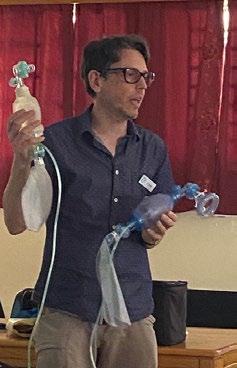
Professor Ambrose Rukuwe, University of Namibia and medical officers participating the Paediatric Advanced Life Support Course, in Windhoek (Dr Derek Rosen is in the background).
Dr Derek Rosen demonstrating different self-inflating bags.
Dr Linea Nanyalo-Nashima, head of Anaesthesia, Windhoek Central Hospital, demonstrates sizing and insertion of oropharyngeal airways.
both Windhoek and Oshakati. Although there are some differences in medication availability and critical care resources, most of our practices and management algorithms were transferable to a lower resource setting.
My Namibian colleagues were able to ensure the attendance of both paediatric and anaesthetic junior doctors as well as some nursing staff from anaesthesia, paediatrics, maternity and the neonatal unit. Paediatric medical officers in Namibia are expected to manage airways more frequently than they would be in Australia. Presenting content that was, at times, outside my specialty area to clinicians of varying knowledge levels was challenging. Writing simulation scenarios with little idea of what equipment was available required a fair degree of fluidity and, fortunately, the participants were quite forgiving.
The opportunity to practice airway management, rhythm recognition and cardiopulmonary resuscitation (CPR) was well received. Particularly, familiarisation of non-anaesthetic staff with supraglottic airways and good bag-mask ventilation technique generated several learning points and cross specialty discussion about management pathways.
The concepts of crisis resource management, such as role allocation and closed loop communication, were integrated into medium fidelity scenarios and the buy-in and enthusiasm of the participants was high. The formal feedback we received was overwhelmingly positive and several participants asked if these courses could be repeated every six months.
It was clear that running these workshops on a regular basis would be pivotal in the Namibian context. As the local specialty training programs mature and produce more graduates, there is still scope for visiting specialists and sub specialists to contribute to ongoing education.
Dr Derek Rosen, FANZCA
Dr Yvette D’Oliveiro, FANZCA
Emergency response (ER) activities have always been highly regarded by ANZCA and FPM fellows and other continuing professional development (CPD) participants since their inception and integration into the CPD framework from 2014. To date, the college has more than 1000 ER courses/workshops recognised as suitable, and in my role as ANZCA and FPM CPD Committee Chair, I have had the pleasure of reviewing many of these, with the support of the committee members and the CPD team.
Dr Derek Rosen (FANZCA) and his team’s Paediatric Advanced Life Support (PALS) ER application was one of the most innovative that I’ve seen and illustrates the global appeal of ANZCA-designed ERs. Having recently returned from Africa after trekking Mount Kilimanjaro, I also reflected that ascending to high places takes many guises. Dr Rosen and the team’s efforts to extend teaching to those in remote health settings, with resource constraints, like Namibia, is to be commended and applauded.
Dr Debra Devonshire, FANZCA Chair, ANZCA and FPM CPD Committee Chair
The college is actively seeking fellows and CPD participants to share their experiences with the CPD program in answering the question “How do you do your CPD?”. Please get in touch with our helpful CPD team at cpd@anzca.edu.au with your interest.

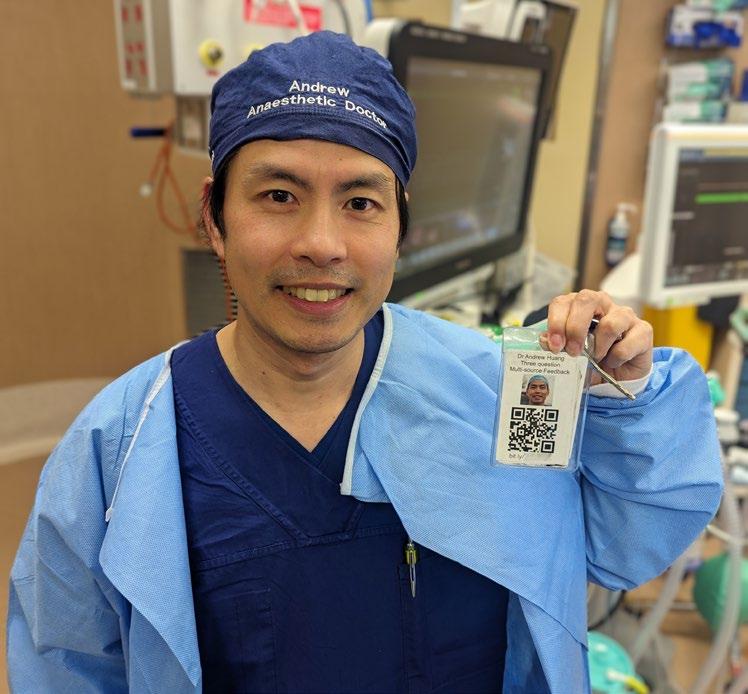
Can you remember a time when you were a trainee working with that consultant everyone dreaded working with? Have you heard those whispers in the tearoom about some of the things your colleagues have been doing?
I have, and I certainly didn’t want to become that consultant or the subject of those whispers.
On reflection, we work very independently in our profession of anaesthesia. Once we’ve finished our training the opportunity to observe and give feedback or to receive feedback from a colleague is often limited to the continuing professional development (CPD) “peer review of practice”. In my 10 plus years as a FANZCA FFPMANZCA I’ve found that surgeons don’t often give unsolicited feedback, nor do the anaesthetic assistants or nurses, nor the trainees.
So how do we know if we’ve become that consultant or the subject of those whispers? The simple and scary answer is, often we don’t.
I believe that most of us in this profession strive for excellence. As American surgeon and writer Atul Gawande
noted in a New Yorker article all elite tennis players have coaches. Gawande likewise invited a more senior surgeon to give him feedback to improve (Gawande 2011).
But we work in a system and culture that stymies feedback through hierarchy, power differentials, focus on efficiency, and perceived fear of defensiveness, and even worse – fear of retribution.
So I asked myself – “How can I get the feedback I need to keep improving?”
The answer was, “By asking for it.”
Consequently, I started asking the nurses and junior medical officers working directly with me for anonymous feedback. The feedback asks three short questions:
• What was one thing I did well? (Please provide example.)
• What was one thing I could do better? (Please provide example.)
• Do you have some other comments/feedback?
I decided to use web-based software to collect the data anonymously. (There is an array of free or paid software to use such as SurveyMonkey, Google forms, Microsoft forms and Qualtrics among others.) I then made a QR code which I printed on business cards.
I had initially planned to hand out the business cards but through experience I’ve found it’s simpler and easier to keep the QR code with my swipe card and get people to scan the code directly into their phone.
You are welcome to review and copy the sample survey here: forms.office.com/r/T4tnE8JTFv or by scanning the QR code opposite/here.

I only look at the data every three months to ensure anonymity – my memory is not good enough to remember who I worked with on a particular date and I’m not interested in finding out who gave the feedback. It’s the feedback itself which is important.
At that three-month interval, I download the feedback, reflect on it, and then formulate a plan on how I might change my practice. This is something the educator Donald Schon would call reflection-on-action (Schön 1987).
Importantly, this type of practice would seem to fit within the Medical Board of Australia’s criteria for individualfocused reviewing-performance-CPD activities under “selfevaluation and reflection” (Medical Board of Australia 2023).
I’ve called this system “micro multisource feedback” (micro MSF): Micro because it asks just three relevant questions; and multisource because I’m trying to get the feedback from everyone I’m working with. I purposely designed the form to avoid Likert scales which I find meaningless. I’ve also discovered that the Monash Health emergency department gathers similar information and we’ve been piloting a variation on micro MSF for the anaesthesia trainees at Austin Health.
Of course no system is perfect. Not everyone is open to receiving feedback, and not everyone is willing to give feedback – those power differentials and fears don’t simply disappear. There is also a small risk someone might write something particularly heinous about me but I think I’ve got the mental fortitude to see past any personal attacks and get to the heart of the feedback.
Ultimately, the important thing about this exercise is that I’m inviting feedback and hopefully creating a “challenge network” that will help me to improve (How to Love Criticism 2021) The invitation itself has been a pleasant surprise to many of my colleagues.
I’ve been collecting micro MSF data since December 2021 and over that time I’ve received more than 150 qualitative data points on my strengths and where I need to improve. To my thinking, 150 data points is better than zero and hopefully people have been courageous enough to give me honest feedback.
Most reassuringly, I haven’t seen any feedback that suggests that I have become that consultant or the subject of those whispers.
Dr Andrew Huang, FANZCA FFPMANZCA Specialist Anaesthetist, Austin Health
References
1. Gawande, Atul. 2011. ‘Personal Best - Top Athletes and Singers Have Coaches. Should You? (The Coach in the Operating Room)’. The New Yorker. 26 September 2011. https://www.newyorker.com/ magazine/2011/10/03/personal-best.
2. How to Love Criticism. 2021. WorkLife with Adam Grant. https:// www.youtube.com/watch?v=Wh1zhRck-Wg.
3. Medical Board of Australia. 2023. ‘Professional Development Plans & Types of CPD’. 27 November 2023. https://www.medicalboard. gov.au/Professional-Performance-Framework/CPD/ProfessionalDevelopment-Plans.aspx.
4. Schön, Donald A. 1987. Educating the Reflective Practitioner: Toward a New Design for Teaching and Learning in the Professions. First Edition. San Francisco, California: Jossey-Bass. https:// archive.org/details/educatingreflect00sch.
The Airway Special Interest Group (SIG) is looking to grow its Australian Airway Leads Network to more public and private hospitals.
New Zealand has maintained a robust network of airway leads since 2018. The SIG would like to strengthen the network in Australia with greater engagement and collaboration from nominated airway leads.
While the role is not a formal requirement in the ANZCA accreditation process or part of the curriculum, if your hospital is currently without an airway lead and you have a keen interest in the role, we encourage you to nominate.
For more information go to the college website.
Make sure you’re not missing out on important information!
Keep your details up to date on the MyANZCA portal. We use the information on your MyANZCA profile for all of our official communications, including:
Exam updates · Events and courses · Committee vacancies Safety alerts · Hospital rotations · Research opportunities
So please take a few minutes to check your personal details. It’s easy to do, and ensures you won’t miss out on important information.
1. Log into anzca.edu.au/portal
2. Click “Update my contact details”
3. Ensure your details are up-to-date and click “save”.
If you have multiple addresses you can select a preferred mailing address. You may also choose to let us know if you identify as Aboriginal Australian,
Torres Strait Islander, Māori or Pacific Islander; and alert us to any dietary requirements.
If you’re worried that you’re not receiving our emails, please check your junk and spam filters and, if necessary, add @anzca.edu.au or @anzca.org.nz to your address book.
And don’t forget to follow us on your favourite social media channels for all the latest news, events, and insights into college life.
We are the foremost authority on anaesthesia, pain medicine, and perioperative medicine in Australia and New Zealand, respected by governments and the healthcare sector to provide expert advice that ensures the safety of our patients.
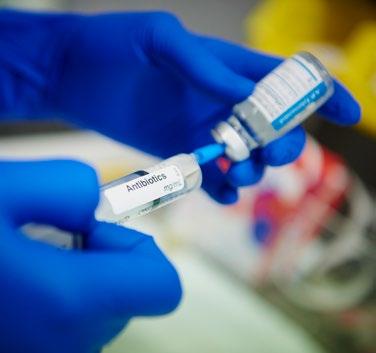
Tracheostomy is commonly performed to address upper airway compromise or facilitate ventilation weaning.
However, one in four hospitalised tracheostomy patients experience a tracheostomy related complication and these complications account for one in two airway related deaths in critical care units.1 The most common tracheostomy emergencies are tube displacement, tube obstruction, pneumothorax and haemorrhage.2
System level changes that redesign environments, force certain behaviours and change culture are more effective than traditional person-based changes such as guidelines or protocols.
Cognitive aids, while not as effective as system changes, outperform traditional approaches and could enhance the impact of system changes.3
Cognitive aids support preparation, education, post event reflection and real time crisis management. They are particularly valuable in rare events like tracheostomy emergencies.4
The Austin Tracheostomy Review and Management Service (TRAMS) was established in 2002 as a comprehensive multidisciplinary consultative service and has demonstrated improved patient outcomes and financial savings.5
The scope of services currently delivered by TRAMS is presented in table 1. Austin Health was a founding member of the Global Tracheostomy Collaborative (GTC) (2012), aimed at improving quality of tracheostomy care by implementing key drivers.1
McGrath and colleagues from the National Tracheostomy Safety Project (NTSP) have demonstrated that implementation of a package of care incorporating the GTC key drivers in a diverse range of hospitals has resulted in harm reduction in tracheostomy patients.6 The NTSP published multidisciplinary guidelines in 2012, emphasising emergency algorithms and staff education.7
Recently, the Austin Hospital formed a multidisciplinary team, including an academic communications designer to develop a cognitive aid, based upon the NTSP guideline and tracheostomy emergency algorithm, to support the code blue team in tracheostomy emergencies. The Austin Emergency Tracheostomy Management Cognitive Aid was published in 2021.8 It is an A3 poster that is two sided to enable real time decision support for primary and advanced responders.8
The cognitive aid is intended to be navigated by a cognitive aid reader who is separate to the team leader.4 The front side of the cognitive aid is for primary responders who are the bedside staff and is to be used before the code blue team arrives (figure 1). It includes tracheostomy and upper airway information.
"One in four hospitalised tracheostomy patients experience a tracheostomy related complication."
Table 1:
SERVICES PROVIDED BY THE TRACHEOSTOMY REVIEW AND MANAGEMENT SERVICE (TRAMS)
• Consultative interdisciplinary team providing twice weekly consultant ward rounds and patient consultation as required
• Tracheostomy care across the continuum including acute, subacute services and community
• Facilitate safe and timely decannulation
• Evidence-based support, education, teaching and training of staff, patients and carers
• Coordinate and implement centre wide multidisciplinary tracheostomy clinical standards and procedures
• Coordinate tracheostomy data collection, evaluation and reporting
• Critical incident review
• Discharge planning, case management, education, consumables and equipment for individuals living with long-term tracheostomy
• Convene Interdepartmental Tracheostomy Forum, communicating tracheostomy information and initiatives locally and globally
• Australasian lead site for the GTC
• Annual Tracheostomy Patient and Family forum and Fundamentals of Tracheostomy workshop
• Interdisciplinary educational resources (https://tracheostomyteam.org/resources-page/
The second side of the cognitive aid is for advanced responders, the code blue team and critical care environments including the operating room (figure 2). There was a determination to include only important and not excessive information in the design of the aid but this was challenging given the variable experience of the code blue responders. Use of a title for each step, next to the number with an accompanying description in the lighter background of the implications or further actions required in that step was used as a method to address this expertise gradient. For the more experienced user the title of each step can be used as a trigger and for a more inexperienced team the cognitive aid reader can provide more details.
The advanced responders’ side of the cognitive aid is intended to be used as follows:
• Check through the ‘in all cases section’ confirming that this is a tracheostomy not laryngectomy patient, the patency of the upper airway, use of capnography and oxygen and consideration of help required.
• Determine which of the three pathways to follow: the first pathway ‘Difficulty breathing or ventilating via tracheostomy tube' is the most common. The second pathway should only be chosen if the tracheostomy tube is completely out of the neck. The third pathway is for bleeding.
• It is important to note that at the top of the first two pathways are the words ‘Stop when patient is stable’ A key understanding for the code blue team is that the emergency need only be managed until stability is reached. Then it is important to wait and re-assess the need for a definitive solution with the now stable patient. All steps are intended to be completed in the bleeding pathway.
Tracheostomy complications can have significant impact.
Austin Health has developed a cognitive aid which we believe can assist teams managing tracheostomy emergencies.
However, it is important to emphasise that prevention and management of these complications requires a comprehensive multidisciplinary approach to tracheostomy care.
Dr Jon Graham, FANZCA – anaesthetist
Ms Prue Gregson, MHA, B.Sp.Path – speech pathologist, Manager TRAMS
Dr Caleb Fisher, FRACP, FCICM – intensivist
Austin Health, Victoria
References
1. Brenner MJ, Pandian V, Graham DA, Milliren CE, Zaga C, Morris LL, et al. Global Tracheostomy Collaborative: data-driven improvements in patient safety through multidisciplinary teamwork, standardisation, education, and patient partnership. British journal of anaesthesia. 2020;125(1):e104-e8.
2. McGrath BA, Wilkinson K. The NCEPOD study: on the right trach? lessons for the anaesthetist. British journal of anaesthesia. 2015;115(2):155-8.
3. Trbovich P, Shojania K. Root-cause analysis: swatting at mosquitoes versus draining the swamp. BMJ Qual Saf. 2017;26:350-3.
4. Goldhaber-Fiebert SN, Howard SK. Implementing emergency manuals: can cognitive aids help translate best practices for patient care during acute events? Anesthesia and analgesia. 2013;117(5):1149-61.
5. Cameron TS, McKinstry A, Burt SK, Howard ME, Bellomo R, Brown DJ, et al. Outcomes of patients with spinal cord injury before and after introduction of an interdisciplinary tracheostomy team. Critical care and resuscitation : journal of the Australasian Academy of Critical Care Medicine. 2009;11(1):14-9.
6. McGrath B, Wallace S, Lynch J, Bonvento B, Coe B, Owen A, et al. Improving tracheostomy care in the United Kingdom: results of a guided quality improvement programme in 20 diverse hospitals. British journal of anaesthesia. 2020;125(1):e119-e29.
7. McGrath BA, Bates L, Atkinson D, Moore JA. Multidisciplinary guidelines for the management of tracheostomy and laryngectomy airway emergencies. Anaesthesia. 2012;67(9):1025-41.
8. Graham JM, Fisher CM, Cameron TS, Streader TG, Warrillow SJ, Chao C, et al. Emergency tracheostomy management cognitive aid. Anaesthesia and intensive care. 2021;49(3):227-31.
The cognitive aid includes the disclaimer that it has been developed for the use of Austin Health and was specifically designed for Austin Health circumstances and that Austin Health shall not be liable for any claims or loss arising from its use elsewhere.
However, the purpose of publishing it is to share it and we warmly invite others to responsibly adopt it in their organisations. The Austin version can be downloaded directly at https://tracheostomyteam.org/wp-content/uploads/2023/02/ Emergency-Tracheostomy-Management-Poster-2022-Final.pdf






Malignant hyperthermia (MH) is an acute pharmacogenetic (autosomal dominant) disorder, that develops during or immediately after the application of general anaesthesia involving volatile agents and/or depolarising muscle relaxants.
The classic MH crisis is caused primarily by excess calcium availability in the skeletal muscle cytoplasm because of a defect in calcium channel regulation when exposed to triggering agents.
While the incidence of MH is rare, it is a significant cause of anaesthetic morbidity and mortality.
Clinical presentation
The spectrum of signs of an MH reaction are due to excess calcium released from the interaction between a structurally altered calcium channel and a triggering agent (volatile anaesthetic agents or suxamethonium).
These signs range from isolated masseter spasm unresponsive to non-depolarising muscle relaxants all the way to extreme hypermetabolic derangement. Onset may be on or shortly after induction or many hours into a case.
Onset may be more rapid in patients who have a higher temperature or hypermetabolic state preoperatively due to concurrent illness.
The decision to treat when you suspect MH can be a difficult one, but early treatment is the key to reducing morbidity and mortality. In rapidly developing situations where there is an absence of another plausible diagnosis (a blood gas is helpful here), there is little downside to “calling” MH and following the treatment recommended on the action cards in the MH resource kit.
There are of course complex situations where there may be more than one explanation for hypercarbia (laparoscopic surgery, ventilation issues), hyperthermia (sepsis, trauma) and tachycardia but suspicion for MH should be high when more than one of these parameters continues to worsen.
Mortality from MH without dantrolene has been reported to be more than 70 per cent[1] even in recent times and this needs to be considered when deciding when to declare an MH crisis.
Treatment
Dantrolene sodium, available in Australia and New Zealand as Dantrium™ powder for injection and removal of the trigger agent remain the immediate priorities for treatment of an MH episode.
Temperature management and managing the consequences of hypermetabolism are also crucial to the successful treatment of MH.
Many anaesthetists will not experience an MH crisis in their practicing career. There are many high-priority issues that must be attended to simultaneously and this is why it is important to have appropriate task allocation and practiced crisis management skills.
Simulated MH scenarios, regular education, a dedicated box or trolley with the necessary drugs and equipment available are all important to make sure you and the staff at your institution are prepared.
The MH resource kit developed by MHANZ and available from www.malignanthyperthermia.org.au is an important part of MH readiness for any institution where triggering agents are administered.
"The decision to treat when you suspect MH can be a difficult one, but early treatment is the key to reducing morbidity and mortality."
The in vitro contracture testing (IVCT) is a procedure that measures muscle contraction of dissected muscle fibres in response to increasing doses of caffeine and halothane. It can only be performed at one of four specialised units across Australia and New Zealand.
Patients must travel to one of these centres where they undergo a day case procedure. At the Royal Melbourne Hospital (RMH), the surgery is routinely performed under non-triggering general anaesthesia.
The IVCT requires a moderately large muscle specimen removed by a skilled operator and relies on a highly trained individual to perform the test and interpret the results. Patients must wait at least three months after a suspected episode for muscle strength to recover and it is not performed on children under 10 years old or whose weight is less than 30 kilograms. Clearly it is not an ideal test but for now, it is the only test that can rule out MH.
In cases where the clinical suspicion of MH is high, we will often commence the diagnostic process with genetic testing for any variants in RYR1 (the gene that codes for the skeletal muscle ryanodine receptor) and CACNA1S (the gene that codes for the alpha 1 subunit of the L type voltage dependent calcium channel in skeletal muscle) as these are two of the genes where genetic changes have been shown to be responsible for MH.
Genetic tests for any individual are always accompanied by expert genetic counselling to understand the limitations of this test in MH. Only 40 per cent of individuals with an IVCT proven diagnosis of MH will have a likely genetic variant identified, and the absence of a variant in an individual or a family member is not enough to rule out MH (only an IVCT can do this).
In cases where the suspicion is less but where MH needs to be ruled out, it is often beneficial to offer an IVCT as the first test.

MH experts around the world are focused on developing a less invasive more widely available test for MH. Genetic, metabolic and functional alternatives are all being pursued.
Managing the susceptible patient
Anaesthesia for the MH susceptible patient is safe using a non-triggering technique. There is no evidence that MHS patients are at greater risk of complications if triggering agents are avoided. MH patients can be recovered in standard post anaesthesia care units.
Institutions need to understand how to prepare their anaesthesia workstations for the MH patient.
Manufacturers will be able to provide appropriate flushing times to reduce volatile agent contamination to safe levels. Charcoal filters are a safe alternative to machine flushing and should be used as per the manufacturer instructions.
It is important that patients with an MH diagnosis or family history make their treating clinicians aware early in the planned surgery journey, so that appropriate preparation of anaesthesia staff and equipment can occur.
"Simulated MH scenarios, regular education, a dedicated box or trolley with the necessary drugs and equipment available are all important to make sure you and the staff at your institution are prepared."
Ideally, patients will have been in contact with an MH unit and have clarity about their risk, but this is not always the case. In some cases, it may be appropriate to delay planned surgery, but in others, delaying surgery to pursue an MH diagnosis may not always be in the best interest of the patient.
If in doubt, contact one of the specialist units and talk to an MH expert.
Identification of at-risk individuals
Patients with RYR1 or CACNAIS variants should be considered to be at risk for MH and are best discussed with your local MH unit. Symptomatic (myopathic) forms of these include the channelopathies referred to as central core disease and multiminicore disease.
Congenital myopathies, congenital muscular dystrophies, metabolic myopathies and mitochondrial myopathies are not at increased risk of malignant hyperthermia, however all of these conditions warrant careful consideration of the choice of anaesthetic agents and neuromuscular blockade.
A consensus statement from the European Neuromuscular Centre published in 2022[2] provides a comprehensive and accessible overview of risk assessment and anaesthetic management of patients with these conditions.
Referrals and advice
The MH specialist units in Australia and New Zealand accept referrals for patients with known or suspected MH and their family members through the MHANZ website (www.malignanthyperthermia.org.au).
Your patient will be contacted by the most appropriately located diagnostic centre. In Australia, units are located in Melbourne, Sydney and Perth. In New Zealand, the MH unit is in Palmerston North.
Dr Robyn Gillies and Associate Professor Andrew Bjorksten Malignant Hyperthermia Diagnostic Unit (MHDU), Royal Melbourne Hospital (RMH)
Established in 2001 to continue the pioneering work commenced by Professor Michael Denborough and Professor Rob Moulds, the Malignant Hyperthermia Diagnostic Unit at Royal Melbourne Hospital, identifies at least five additional MH families per year due to anaesthetic incidents, adding to the 350 families with laboratory-proven MH in our records.
All ethnicities are represented in this cohort. In addition to in vitro contracture testing (IVCT), which remains the mainstay of diagnosis, the MHDU clinicians (Dr Robyn Gillies, Associate Professor Andrew Bjorksten, Dr Brad Hockey, Dr Amit Surah
References
1. Tan, L., et al., Clinical Features of Suspected Malignant Hyperthermia in China from 2015 to 2020: A Retrospective Study from China Malignant Hyperthermia Emergency Assistance Group. J Multidiscip Healthc, 2022. 15: p. 3005-3013.
2. van den Bersselaar, L.R., et al., European Neuromuscular Centre consensus statement on anaesthesia in patients with neuromuscular disorders. Eur J Neurol, 2022. 29(12): p. 3486-3507.

and Dr Anthony Qureshi) provide advice to clinicians and patients, coordinate genetic testing and work with specialist neuromuscular clinicians to manage patients with chronic symptoms related to ryanodine receptor disorders.
The MHDU is strongly affiliated with Malignant Hyperthermia Australia and New Zealand (MHANZ), a group of experts who meet annually to review and update MH guidelines and advice.
The New South Wales Special Committee Investigating Deaths Under Anaesthesia (SCIDUA) has been reviewing deaths associated with anaesthesia and sedation since 1960. Example cases from the 2019 Special Report are being reproduced in the ANZCA Bulletin in an effort to enhance reporting back to the medical community.
A 64-year-old male for elective rectal surgery.
Background history
The patient had rectal adenocarcinoma and a 50-pack year history of smoking.
Anaesthetic details
The patient was preoxygenated and given midazolam (2 mg), oxycodone (3 mg), propofol (100 mg) and vecuronium (10 mg). Bag mask ventilation was easy, and the patient was intubated. Grade 1 view.
Post intubation ventilation was difficult and there was no capnography trace. The endotracheal tube was removed and then reinserted. Once again grade 1 view. This time some CO2 with a bronchospastic trace.
Non-invasive blood pressure was cycling without a reading accompanied by tachycardia and no pulse oximetry trace.
Anaphylaxis was suspected - adrenaline 100 µg IV given. No pulse able to be felt. CPR commenced. Initial rhythm was PEA then asystole then VF. During resuscitation the following drugs were administered:
• 9 mg adrenaline.
• 40 units vasopressin.
• 200 mg sugammadex.
• 300 mg amiodarone.
• 8 L of crystalloid.
He also received two units of blood.
The patient was shocked six times during the resuscitation. The cardiothoracic team were called in to institute extracorporeal membrane oxygenation (ECMO), which was achieved within 56 minutes of arrest. The patient was transferred to the intensive care unit but showed very poor neurological recovery. Post-arrest tryptase level was 142 µg/ml.
Treatment was withdrawn four days later after neurological assessment revealed profound irreversible hypoxic brain injury.
• Anaphylaxis can occur with any drug.
• Even with immediate recognition and treatment outcomes can still be very poor.
• Tryptases should be taken after every suspected reaction.
• Be aware of the signs (tachycardia, unexplained hypotension, bronchospasm, rash) and consider ECMO early if in an institution which can provide it.
• The use of sugammadex in the treatment of suspected anaphylaxis not supported by evidence. Adrenaline and fluid resuscitation remain the mainstay of treatment.
Source
1. Clinical Excellence Commission, 2021. Activities of the Special Committee Investigating Deaths Under Anaesthesia, 2019 Special Report. Sydney, Australia. SHPN: (CEC) 210176; ISBN: 978-176081-648-3.
Fellows are encouraged to read the SCIDUA report in its entirety. The detailed cases and data analysis presented are paving the way forward to a more informative and educational mortality analysis.
Safety alerts appear in the “Safety and quality news” section of the ANZCA E-newsletter each month.
A full list is available on the ANZCA website: www.anzca.edu.au/safety-advocacy/safety-alerts.
Recent alerts:
• IV paracetamol in short supply - 7 March 2024
We are delighted to share some updates from the Australian and New Zealand Tripartite Anaesthetic Data Committee (ANZTADC) and webAIRS.
We have a strong team within and supporting ANZTADC. Dedicated individuals across Australia and New Zealand are committed to improving patient safety and work tirelessly to analyse incidents, distribute important patient safety information, and help reduce adverse events in anaesthesia practice. We are proud of the work we have done so far, and we are excited about what the future holds.
Committee members and volunteer data analysers will provide webAIRS workshops and masterclasses at the upcoming ANZCA Annual Scientific Meeting in Brisbane in May and the ASA National Scientific Congress meeting in Darwin in September. Findings of recent and ongoing incident analyses will be presented with six presentations across both events covering a wide range of different incident types across adult and paediatric anaesthesia.
We are continuing our ongoing analyses and are making significant progress. As a recent example, a sub-committee focussing on paediatric incidents has been established, and we are excited to see the results of their work.
We invite anaesthetists interested in joining our analyser groups to contact their local committee members or email us at anztadc@anzca.edu.au
The numerous anaesthetists who are continuously reporting anaesthetic incidents for the benefit of our community receive our gratitude. We encourage all anaesthetists across Australia and New Zealand to register with webAIRS and report any events, ranging from near misses to major harm. All data collected is de-identified, protected by qualified privilege, and will be used to further improve patient safety.
With this my first ANZCA Bulletin article as medical director, it follows Dr Martin Culwick retiring as our inaugural medical director after 16 years of service. His contributions to the development of webAIRS, data and incident analyses and database IT support have been outstanding. The success of webAIRS, including the collection of more than 11,000 incidents, multiple publications, regular magazine articles, e-newsletters and updates, is a testament to his outstanding work and dedication.
The tenure of our long-lasting chair, Dr Pieter Peach, ends after six years, and we are grateful that he remains a strong part of the committee. His work has significantly contributed to improve patient safety in anaesthetic care across Australia and New Zealand.

Dr Yasmin Endlich is the new ANZTADC medical director. She is an anaesthesia consultant at the Royal Adelaide Hospital, a staff specialist with Adelaide Anaesthetic Services and a senior clinical lecturer at the University of Adelaide. She was chair of the ANZTADC webAIRS publication committee, chair of the ACECC Airway Management Special Interest Group and over the years has been involved in multiple diverse webAIRS projects.


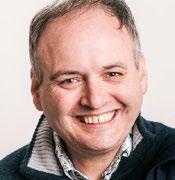



Dr Pieter Peach is an anaesthetist working at the Royal Children’s Hospital Melbourne and privately across hospitals in Victoria. He has an interest in digital innovation and has been chair of ANZTADC for six years having witnessed only a fraction of the work undertaken by Dr Martin Culwick since the inception of webAIRS. He has watched Martin work with determination and perseverance to build and leave behind a lasting legacy in webAIRS, a project that has grown to help facilitate adverse event reporting and valuable data analysis in anaesthesia across hospitals in New Zealand and Australia.
Dr Fergus Davidson has been an Australian Society of Anaesthetists’ representative on ANZTADC since 2018. He is a full-time clinical anaesthetist, working in public and private practice in Sydney. In addition to clinical governance and leadership, Fergus has particular interests in incident analysis, human factors, electronic medication management, and other aspects of clinical and corporate risk management. He hopes to see webAIRS become increasingly accessible and relevant, by facilitating anaesthetists to interactively engage with its large de-identified database.
Dr Ross Scott-Weekly is a paediatric anaesthetist in Ōtautahi Christchurch, New Zealand. He trained in the South Island, followed by a paediatric anaesthesia fellowship at Melbourne’s Royal Children’s Hospital. Subsequently, he worked as a specialist in Perth at St John of God Midland and Perth Children’s Hospital. Developing a keen interest in quality assurance and data analysis, he created a semi-automated departmental dashboard system. Ross is passionate about paediatric quality assurance, research, and leveraging healthcare data for positive outcomes.
Dr Anna Steer has a clinical interest in regional anaesthesia, paediatric anaesthesia, and pain medicine. She dedicates herself to ensuring safety and quality in these crucial facets of anaesthesia. Currently in Canada, she continues to participate actively in the Committee and is involved in a range of different incident analyses involving adverse events in adult and paediatric anaesthetic practice. She is also an EMAC instructor and a reviewer for the Low-risk Ethics Committee.
Dr Phil Quinn is an experienced general anaesthetist based at Wellington Hospital in New Zealand. With a passion for quality and safety initiatives spanning several years, Phil has recently taken on a role within ANZTADC as the new New Zealand Society of Anaesthetists’ member, replacing our longstanding valued committee member Dr Russell Rarity. Eager to make a difference and improve anaesthetic safety, he looks forward to actively participating in webAIRS efforts, analyses, reviews and contributing his expertise behind the scenes.
Dr Tim Basevi is an anaesthesia registrar based in Sydney. He has a keen interest in education, safety and environmental advocacy within the medical field. Joining ANZTADC in 2020, Tim actively contributed to analysing COVID incidents, reflecting his commitment to improving patient care during challenging circumstances. Looking ahead, Tim anticipates increasing his involvement in the committee post-exams, further dedicating himself to advancing medical standards and safety protocols.
The committee is supported by Dr Heather Reynolds, ANZTADC data analyst and Ms Susan Considine, ANZTADC Co-ordinator.
Dr Yasmin Endlich Medical Director, ANZTADC
This regular column highlights practical ways to support anaesthetists’ and pain specialists’ wellbeing. This edition focuses on the stressors of pain medicine practice and related supports.
There are shared stressors across our profession and then there are the particular challenges within each medical discipline. Specialist pain medicine physicians (SPMPs) bear witness on a daily basis to significant human suffering. While there are inherent rewards in assisting those with chronic pain, the emotional work of pain management can be high, as described in the following interview with Dr Dilip Kapur, the incoming Dean of the Faculty of Pain Medicine. Dilip openly and generously reflects on the wellbeing impacts of his pain medicine practice, highlighting how practitioners can and should be supported.
If you have a wellbeing story you’d like to share in a future Bulletin edition, please email me at bulletin@anzca.edu.au
Dr Lindy Roberts, AM FANZCA FFPMANZCA
Dr Kapur, I understand that you have a particular interest in the wellbeing of specialist pain medicine physicians. What has motivated that interest for you?
In 2010, I was the subject of multiple patient complaints. Intervention from senior officials in the South Australian government emphasised that the complaints had arisen in unusual circumstances and were the result of me fulfilling ethical and professional obligations.
It is hard to describe the significant distress that this experience caused me, during a long and stressful process which eventually resulted in none of the complaints being upheld.
I later reflected on the professional isolation that I endured. The only people with whom I could discuss the issue were my lawyer and the secretary from the state branch of the Australian Medical Association.
Sadly, I did not feel sufficiently supported by my then employer. I believe there should have been better systems in place to support me at a much earlier stage.
That sounds very difficult indeed. It is well known that those who suffer with chronic pain commonly experience significant distress. How does this impact the wellbeing of pain physicians?
Many patients presenting to chronic pain services have seen lots of primary and secondary care providers. While pain as a symptom of chronic disease is common, those with multiple, medically unexplained symptoms also regularly present.
In this group, there is a high prevalence of mental health difficulties, particularly affective disorders. This group is recognised as presenting management difficulties and emotional pressure that can cause frustration, distress and burnout in treating practitioners.1
The situation is further complicated as, regardless of the background, pain behaviour and accompanying distress in patients causes secondary distress in those around them.
This can place enormous stress on clinicians, particularly where treatment failure occurs. Consequently, we see more unorthodox treatments being recommended than in any other medical area. While many are harmless, what is more concerning are situations where, in my view, some medical professionals adopt a “messianic” promotion of hazardous pain treatments, notably with excessive opioid prescribing from the early 1990s.
Many afficionados of this approach were not pain medicine practitioners and some employed egregious techniques of “moral blackmail” against colleagues who did not support their style of practice.
From 2008, I found myself having to take on patients transferred to public hospital pain units, many of whom had never been diagnosed with a verifiable physical illness.

Moral blackmail is a situation where one party pressures another to perform a harmful act by convincing the other party that if they do not perform the harmful act, a situation of greater harm will arise, for which the pressured party will be responsible.
A large proportion of these patients were self-administering injectable opioids, in some cases via long term central lines.
Trying to hold a conversation with such patients focussing on opioid reduction and withdrawal runs a high risk of provoking hostile responses. This, of course, is what happened. It was also accompanied by hostile coverage in some local media outlets and multiple complaints about me to the regulatory authority.
I imagine there are also “lower level” stressors in contemporary pain medicine practice?
My own travails represent an extreme example of the difficult situations that can confront pain physicians. However, lesser challenges are constant within the specialty.
Demands for psychoactive chemicals remain prevalent. While the opioid disaster has stabilised and may be receding, demands for “medicinal” cannabis have opened another front where the evidence-based approach favoured by the faculty has been criticised by some. Identical patterns of moral blackmail have emerged that are familiar to those of us who tried to urge caution around opioids 20 years ago.
Given these potential stressors, it is unsurprising that many fellows of the faculty no longer practice in pain management and have returned to their primary specialist discipline. As an organisation, the college and the faculty is mindful of the need to maintain the welfare of fellows and to support their continuing practice within pain medicine.
Given these significant stressors, what motivates you to continue working in pain medicine?
Pain medicine, in many ways, is emblematic of the motivations within medicine. Having the skills needed to relieve pain in patients is not only a source of professional satisfaction, it can alleviate the internal distress clinicians will inevitably experience when dealing with poorly-controlled pain. Pain medicine offers great opportunities for effective involvement in complex medical conditions. I have never regretted my choice of career.
What supports are available for specialist pain medicine physicians?
There have been many positive developments, both globally and locally, of the need to recognise and reduce the professional burdens in medicine that can lead to distress, poor mental health and other adverse consequences.
The college has taken a proactive approach to assisting fellows, freely providing resources to all fellows of the faculty. The ANZCA Library has excellent resources on physician welfare – linked from the Wellbeing SIG library guide. An excellent place to start is The Essential Guide to Healthcare Professional Wellness 2
A significant development has been including wellbeing activities in the ANZCA and FPM Continuing Professional Development (CPD) program. These include peer support groups, mentoring and individual critical reflection to develop a personal wellbeing plan (see CPD program box on next page).
Regular peer group discussions would have been of great assistance to me in the circumstances I have described. CPD activities specific to pain medicine can be developed further, as has already happened in other areas (such as emergency responses). The enthusiasm of the ANZCA and FPM CPD Committee and staff means that such proposals will receive a supportive response. Fellows with ideas should contact me at FPMViceDean@anzca.edu.au
Thanks so much Dilip for sharing your experiences and insights. Do you have any concluding remarks?
Pain medicine is a small specialty that carries a heavy load. The work will never be easy. Physician wellbeing is foundational for great patient care. Our fellowship is an enduring asset. Preserving the skills and professionalism of our fellows must remain our highest priority. I am certain that the patients we serve would support us in this aim.
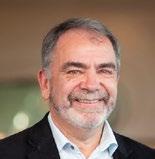
References
Dr Dilip Kapur, FANZCA, FFPMANZCA, Vice Dean FPM
1. Ashton-James. Prevalence and predictors of burnout symptoms in multidisciplinary pain clinics: a mixed-methods study. Pain 2021;162:503.
2. Schroeder. The essential guide to healthcare professional wellness. Proven lessons from leaders. Springer. 2023.
ANZCA AND FPM CPD PROGRAM ACTIVITIES THAT SUPPORT FPM FELLOW WELLBEING Category 1: Practice evaluation – reviewing performance
Peer support groups: three or more self-selected peers meet regularly to discuss and reflect upon professional matters related to their practice in a supportive setting.
Critical reflection: use a series of questions to reflect on your current health and wellbeing to develop a personal wellbeing plan. The guideline provides resources to support this activity.
Mentoring: two colleagues work collaboratively towards mutually defined goals to develop or strengthen the mentee’s professional skills, abilities, knowledge and thinking.
Category 2: Knowledge and skills
Wellbeing education sessions: face-to-face or virtual wellbeing related conferences, workshops, small group discussions or online learning modules.
For Aboriginal and/or Torres Strait Islander Peoples Australian Indigenous HealthInfoNet. Connection. Strength. Resilience. Social and Emotional Wellbeing Resources at https://healthinfonet.ecu.edu.au/learn/special-topics/voice-referendum-social-emotional-wellbeing-resources/ For Māori
Kaupapa Māori wellbeing services at https://www.wellbeingsupport.health.nz/available-wellbeing-support/kaupapa-maori-wellbeing-services/ Te Aka Whai Ora website at https://www.teakawhaiora.nz/our-work/advocating-for-change/rongoa/ Te Whare Tapa Whā at https://www.teakawhaiora.nz/nga-rauemi-resources/te-whare-tapa-wha/ HELP IS ALSO AVAILABLE VIA THE Doctors’ Health Advisory Services:
How to make an appointment:
To speak with a counsellor over the phone or make an appointment to see a consultant for a face-to-face session:
• Telephone 1300 687 327 in Australia or 0800 666 367 in New Zealand.
• Email eap@convergeintl.com.au.
• Identify yourself as an ANZCA/FPM fellow, trainee or SIMG (or a family member).
• Appointments are available from 8am to 6pm Monday-Friday (excluding public holidays).
• 24/7 emergency telephone counselling is available.
NSW and ACT 02 9437 6552 NT and SA 08 8366 0250 Queensland 07 3833 4352 Tasmania and Victoria 03 9280 8712 WA 08 9321 3098 Aotearoa New Zealand 0800 471 2654
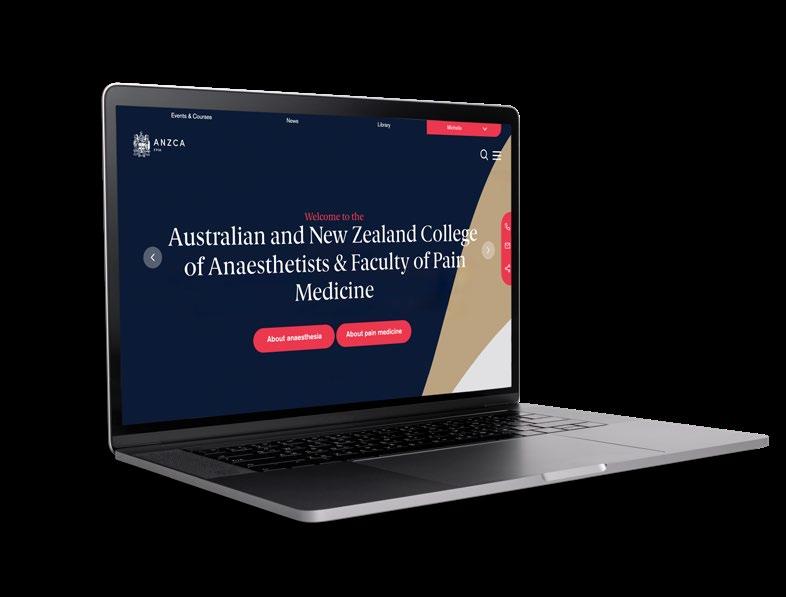
Register your interest in joining a user testing group and help to improve your online experience.
Wherever you go to for information, events, news, and networking, we’ve got you covered! Follow us…
@ANZCA | @ANZCA_FPM | @GKMuseum @the_anzca | @gkmuseum @ANZCA1992 Australian and New Zealand College of Anaesthetists
Australian and New Zealand College of Anaesthetists Faculty of Pain Medicine

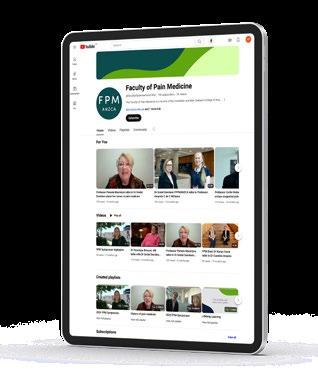
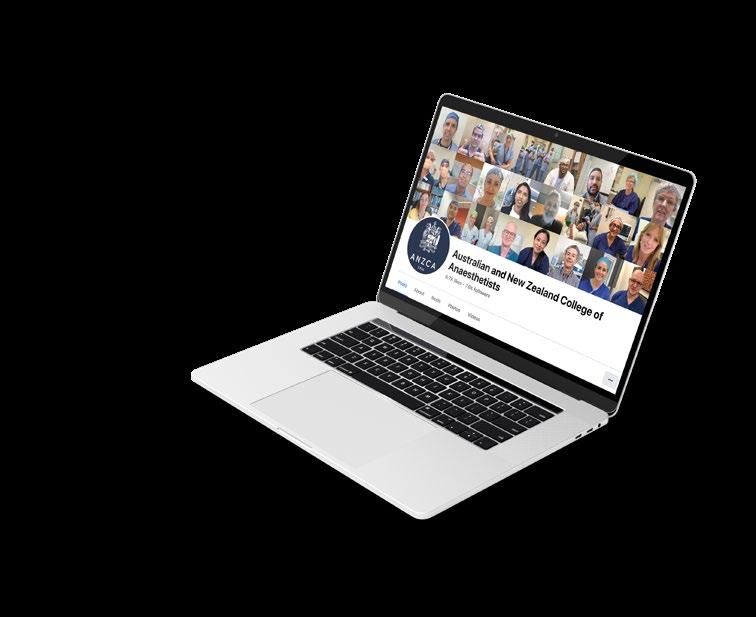

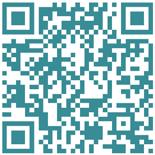








Rotorua is one of New Zealand’s top tourist destinations, and it’s not hard to see why. Nestled between glistening lakes and rugged forest, surrounded by geothermal activity that sees steam burst into the sky and mud bubble from the ground, the city is a mecca for nature lovers and adrenaline junkies alike.
When the Bulletin meets senior medical officer Dr Nick Harrison at Rotorua Hospital, he’s fresh off a 90-minute trailbike ride through the nearby Whakarewarewa Forest, known locally as “the Redwoods".
As work commutes go, it’s tough to beat.
The forest is dominated by towering Californian Redwoods, alongside a smattering of native plants, flora and fauna.
And just as the forest has evolved over the years into a mix of locals and imports, so too has Rotorua’s hospital and its anaesthesia team.
Dr Harrison is one of the imports, but in his words, after beginning his training in Rotorua before having to move away, an eventual return “was always on the cards.”
Rotorua is one of New Zealand’s top tourist destinations, and it’s not hard to see why. Nestled between glistening lakes and rugged forest, surrounded by geothermal activity that sees steam burst into the sky and mud bubble from the ground, the city is a mecca for nature lovers and adrenaline junkies alike.
Situated in the heart of the city is Rotorua Hospital, with 158 beds including 12 in the intensive care unit (ICU), serving a population of just over 110,000, and covering a region of 9570 square kilometres. There are about 20 anaesthetists on staff.
Now happily settled with his wife and two boys, aged eight and five, Dr Harrison says Rotorua offers the perfect work-life balance.
“The perfect day is a summer’s day, you head to work, do your list, then you hop on the bike, ride through the forest to the lake for a picnic and a swim with the family, then you’re home by eight o’clock.”
The variety of working in a smaller centre appeals to Dr Harrison.
“I thought about whether I could work in a bigger centre, and I probably could, but I think you’d specialise quite a lot and miss out on all the generalised stuff you spend so long learning. We cover ICU as well, so in a way we have to become specialised in wraparound care of incredibly sick people, anaesthesia and ICU through any number of specialties, and that’s its own kind of attraction.
“Many people have this idea that they have to do something in bigger places to ‘keep up with the Joneses’, but there’s quite a lot of cool stuff you can do in a place like this. We do some funky things out here.”

One of Dr Harrison’s ongoing projects is revamping Rotorua Hospital’s paediatric anaesthesia scope.
“I think New Zealand is just spread out enough that there’s a lot of things you’re compelled to do at a local level. We’ve got a young population, and we try to service them as well as we can.
“We take it upon ourselves to upskill and keep our volume of practice high, so we can continue to look after them here, which is better for the whole community. And it keeps our hand in because those kids can come through the door anytime, and they’re acutely unwell and needing our assistance.”
While out on his mountain bike, there’s every chance Dr Harrison will run into colleague and fellow senior medical officer, Dr Cambell Bennett.
Dr Bennett is the clinical lead for Rotorua Hospital’s perioperative assessment clinic. He helped set up the clinic several years ago and stepped back from the clinical lead role after taking over as head of the anaesthesia department but has recently returned to the position.
Dr Bennett arrived in Rotorua about 14 years ago, moving as part of a group of anaesthetist friends who were all looking for a change of lifestyle.
“We’re not into flash cars and houses and private schools and all that kind of stuff, so we thought we’d just come and try and live a great life really.”
The ability to make change in a provincial centre is a positive for Dr Bennett.
ABOVE
Working in a smaller centre means it's sometimes easier to make change, according to Dr Cambell Bennett.
“We don’t have a strong hierarchy culture and we actively work against hierarchy. The environment at the hospital is really supportive and ultimately that’s better for patients too…”

“We look after lots of children here, we do lots of regional anaesthesia. It’s relatively easy to affect change in a small place. If you want to do something and you’ve got the motivation and it doesn’t cost a fortune, you can make it happen.
“We’ve got great pathways here for enhanced recovery after surgery, pathways for arthroplasty and bowel resection, and that’s just come about because the anaesthetists all meet on a Wednesday evening and talk about what we’re going to do."
Rotorua has a large Māori population, and the accompanying deprivation issues present challenges for Dr Bennett and his colleagues.
“We have some really challenging clinical situations that keep us on our toes. We have some bad trauma that comes in, we get some very challenging obstetrics, late presenters, we get lots of illness and pathology associated with deprivation, but that’s part of the job.”
Anaesthetist Dr Arihia Waaka is one of the Rotorua locals. In fact, she’s about as local as it gets.
Dr Waaka can trace her genealogy all the way back to Tamate-kapua, the captain of the Te Arawa canoe which in Māori tradition arrived in New Zealand from Polynesia around 1350.
Her iwi (tribe) include Ngāti Tūwharetoa, Ngāti Pikiao, Ngāti Māhanga, and Ngāti Whakaue – whose traditional lands include the middle of Rotorua, where the hospital sits today.
She was even born in Rotorua Hospital, and although she moved away as a child because of her parents’ jobs, she says it was inevitable she would return.
“It’s a physical pull that I can feel, you always want to be back here, it defines me as a person. I’m committed to the land, I’m committed to the people. I feel like I belong here, but I also feel a duty to this area.” RIGHT
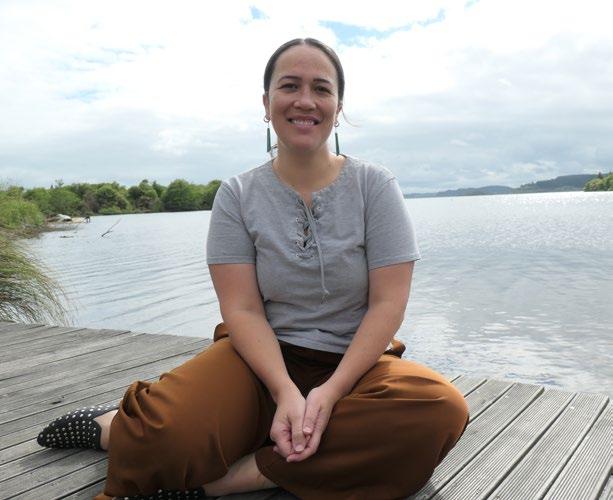
Dr Waaka says Rotorua Hospital works to empower patients and put them at the heart of the healing process.
“We don’t have a strong hierarchy culture and we actively work against hierarchy. The environment at the hospital is really supportive and ultimately that’s better for patients too – if there’s no hierarchy between staff, there’s less likely to be hierarchy between a health worker and a patient.
“I’m a Māori doctor and that has its own nuances. I don’t just work in anaesthetics, I try and do a lot of equity work and Māori health work.”
Spend any amount of time in Rotorua and it’s impossible to ignore the influence of Māori culture. The region’s population is 37 per cent Māori, compared to 17 per cent nationally.
“I check my privilege every day that Rotorua has managed to keep Māoridom in the mainstream, it’s everywhere when you go around in the city. Locals who grew up here embrace it as part of their cultural identity too, and because of that it’s just flourished and grown in a way that’s benefitted everyone.
“We have a high Māori population and Māori people, because of our colonial system, are more likely to have higher deprivation scores. That poses its own challenges, but you would be naïve to come to Rotorua and not anticipate that,” Dr Waaka says.
However, as Rotorua is a smaller city, the logistics of deprivation are easier to manage – if a patient doesn’t have a car and can’t get to their hospital appointment, staff will sometimes go and pick them up.
For anaesthetist Dr Shane McQuoid, it’s the people that make the difference in Rotorua – those he works with, and the wider community.
“People don’t come to a place like Rotorua if they’re big and bolshy and want to be a headliner and stroke their ego.
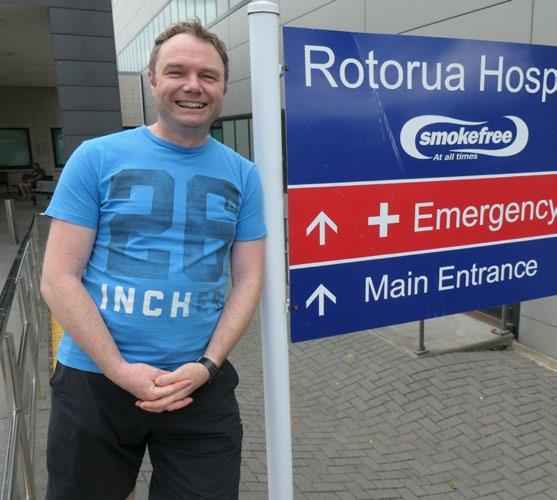
People come here because they either feel very connected to the community or they love the lifestyle of the region, or they want a better upbringing for their family.”
Dr McQuoid has a specific interest in regional anaesthesia as well as advanced haemodynamic monitoring and colorectal surgery, and has taken over as lead of colorectal enhanced recovery after surgery (ERAS) pathways following a retirement.
That focus on people extends to Dr McQuoid helping to bring through the next generation of doctors.
After having his own share of challenging experiences while training, Dr McQuoid signed up nine years ago as the hospital’s supervisor of training (SOT). He’s just renewed his time in the role for another three years.
“I love looking after and nurturing the next generation – it’s incredibly rewarding to see them progress.”
The people-first ethos at Rotorua Hospital is reinforced every morning when staff, patients and guests gather in the hospital foyer to begin their day with traditional Māori waiata and karakia (song and prayer).
It’s a unique and fitting example of the culture at a hospital which Dr McQuoid describes as perfectly sized for the community it serves.
“I’ve always said about Rotorua, the hospital is large enough to do some good stuff, but small enough to be nice. It’s the goldilocks size, it’s just right.”
Reon Suddaby
ANZCA Senior Communications Advisor
New Zealand
ABOVE LEFT
Dr Arihia Waaka was born in Rotorua Hospital and is proud of the city and its strong Māori culture.
ABOVE RIGHT
Dr Shane McQuoid has been Rotorua Hospital’s supervisor of training for nine years.
Dr Ulrike Buehner’s journey to Rotorua has been a circuitous one – and in the end, it was a horse that helped get her there.
Having now lived in Rotorua for 14 years and headed Rotorua Hospital’s intensive care unit for a decade, Dr Buehner made her home in the central North Island city after beginning her medical training at the University of Lübeck in her native Germany, and taking in stints in Scotland, England, the US, and Australia.
Her travels also included a three-week tour of New Zealand, and the country – and Rotorua – made an impression.
Dr Buehner says Rotorua strikes the perfect balance for her. Away from work she lives 20 minutes from the hospital on a lifestyle block and can indulge her other passions – painting, gardening, and horse-riding in the Redwoods on her east coast-bred mare Pipi.
“It’s been a really good balance between intensity at work and a wonderful time outside of work.
“I came from Leeds in the UK, there were traffic jams, it was a struggle to get to work but here it’s so different.”
Renowned within the Rotorua Hospital community for her passion for quality improvement, and currently the chair of the hospital’s medication safety committee, Dr Buehner says one of the benefits of working at a smaller centre is the flexibility to make positive change.
“I realised, within a small dynamic department, what you can actually achieve. To make a unanimous decision, to come to an agreement on how to run something or engage in quality improvement, it’s so much easier.”
Dr Buehner says Rotorua Hospital was one of the first in New Zealand to standardise a pathway for enhanced recovery after orthopaedic hip and knee arthroplasty.
“There were several ways of doing things but to audit it and to know we made a difference is so much easier if you all pull at the same rate.”
ABOVE
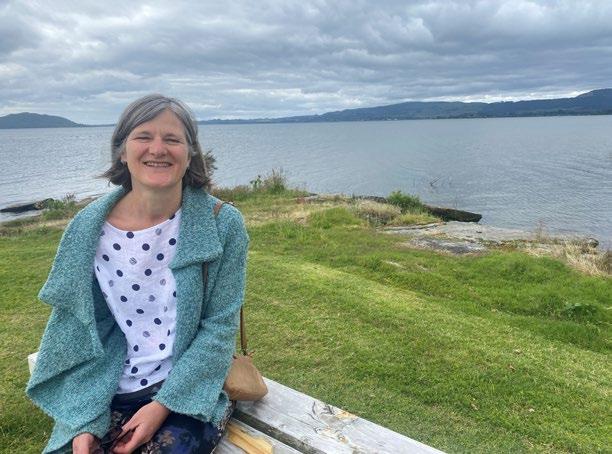
Another area of improvement has been around greater flexibility in visiting hours, particularly for Māori families.
“I think we may be leading the way in the space of open visiting hours. There’s a big contingent of Māori patients coming through…for their recovery, being supported by whanau (family) is really important. To restrict visiting to two people at the bedside can be quite disheartening for them, so as much as possible we’ve allowed more family members in and also children, as they’re a big part of their social network.”
Rotorua is rich in Māori culture, and the opportunity to immerse herself in that culture and learn from Māori has been one of the highlights of Dr Buehner’s time in the city so far.
And as Māori have given to Dr Buehner, Dr Buehner has herself given back.
Alongside fellow anaesthetist Dr Arihia Waaka, Dr Buehner has been working on ways to break down some of the cultural and spiritual barriers surrounding organ donation, by holding hui (meetings) aimed at demystifying the sensitive subject.
In the city she now calls home, thousands of kilometres from Germany, Dr Buehner relishes the chance to help cultures come together.
“I think what has humbled me most is how accommodating and forgiving Māori are if you don’t get the pronunciation (of te reo Māori words) 100 per cent right, and how interested they are in our background, where we come from, and what’s important to us. I remember the first ward rounds I would do on the intensive care unit and Māori patients in particular were always really curious about me and whether I was well – it was just amazing.”
Reon Suddaby
ANZCA Senior Communications Advisor New Zealand

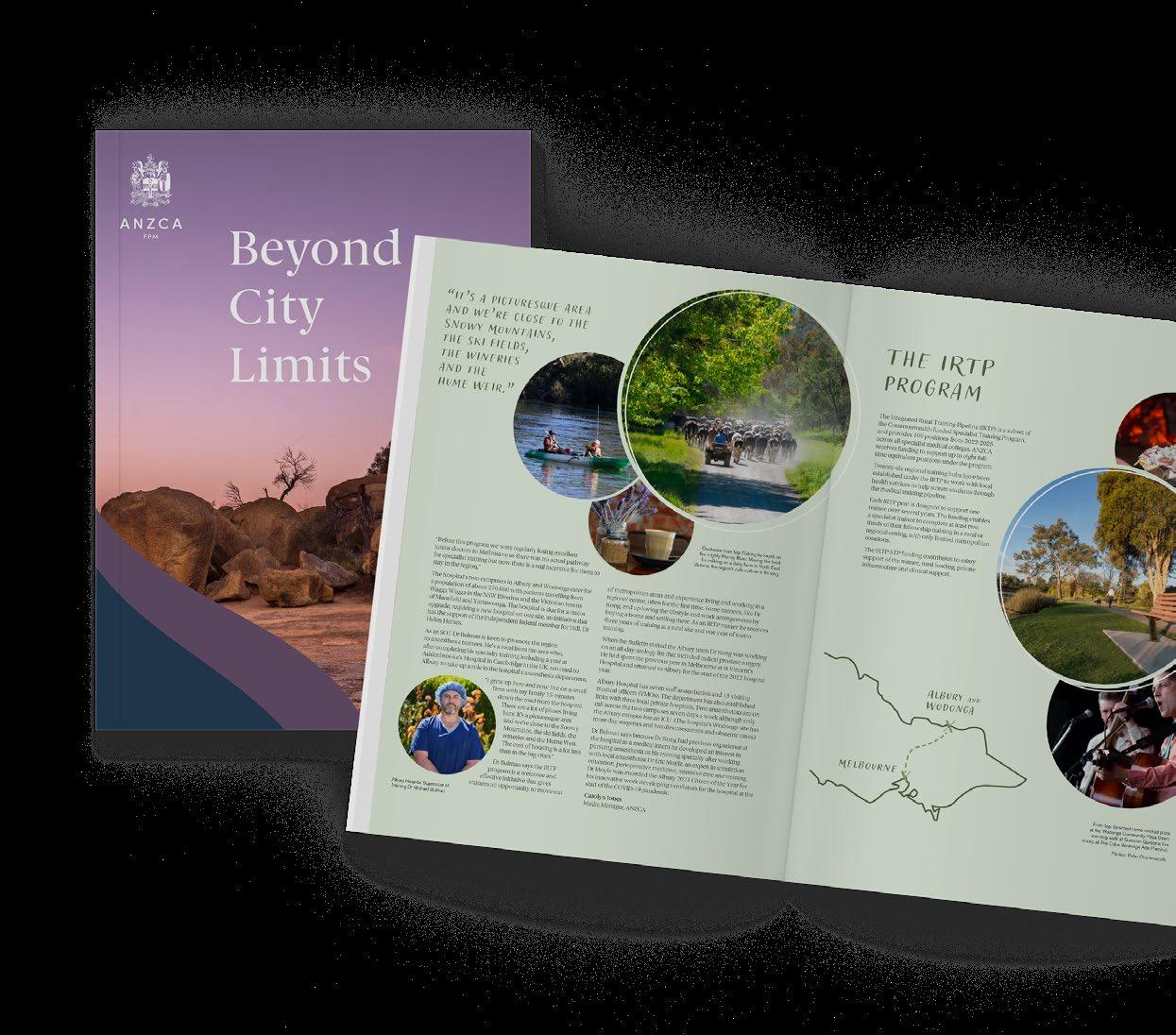
Scan the QR code or visit anzca.edu.au/news/beyond-city-limits-ebook
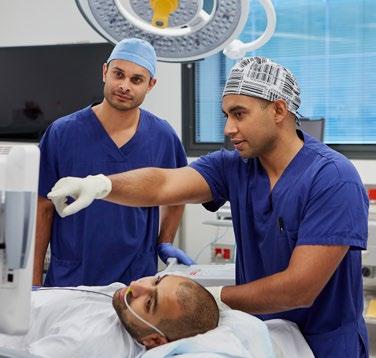
We're responsible for training, assessing and the continuing education of anaesthetists and specialist pain medicine physicians in Australia and New Zealand.
Improving how ANZCA selects trainees, including in regional and rural areas and increasing Aboriginal, Torres Strait Islander and Māori numbers, is the focus of a project being led by the Education Development and Evaluation Committee (EDEC).
The Trainee Selection Project, which is reviewing the trainee selection process for the anaesthesia and pain medicine training programs, was first proposed in 2019 and paused in early 2020 due to the COVID-19 pandemic. The project resumed in 2022 and a working group, chaired by Associate Professor Kara Allen, EDEC Deputy Chair was established.
The college provides guidance for the selection of trainees that is executed by fellows acting for their employers.
There is variability in the processes, timelines and support from the college across jurisdictions. Many fellows volunteer to support selection, including review of resumes and performing interviews. Our scoping process found that there was significant duplication of processes with frustration from both fellows and potential trainees experiencing inefficiencies in the current system.
There is significant underrepresentation of Aboriginal, Torres Strait Islander and Māori trainees, despite some regions developing and implementing strategies to recruit and retain trainees.
A recent Australian Medical Council (AMC) re-accreditation visit applied the following conditions on the college:
• Develop policy and mechanisms to ensure selection processes are consistently and fairly implemented in training sites, under direct and centralised oversight of the college. Weightings used for selection by training sites should be consistent and made publicly available (by 2025).
• Develop and implement mechanisms to increase recruitment, selection, and retention of Aboriginal, Torres Strait Islander and Māori trainees in both training programs, with related evaluation strategies and consultation (by 2024).
These issues led the college to engage an external education consultancy group to explore the merits of a more standardised selection system that responds to the AMC’s conditions, and which enhances the trainee selection process for both candidates and fellows.
The education consultants sought input from a variety of stakeholders, drawing in perspectives from trainees, fellows, employers and staff; as well as other specialist colleges and global literature. Current practices were explored, areas for improvement identified and recommendations made for trainee selection that is fair, efficient, and robust in selecting the best candidates.
Recommendations
• Co-design an attractive Aboriginal, Torres Strait Islander, and Māori pathway.
• Create resources and facilitate networks to grow and promote rural and remote training.
• Agree selection criteria across regions, introduce more alignment on timelines and communication.
• Centralise the initial stage(s) of the selection process.
• Continue to explore the issue of independent trainees in the anaesthesia training program through an analysis of demand and supply.
Consultation outcomes
The recommendations identified the following findings:
Increase representation of Aboriginal, Torres Strait Island, Pasifika, and Māori specialists through a training pathway program
There was broad recognition of the need for the college to increase representation of Aboriginal, Torres Strait Island, Pasifika and Māori trainees.
The Australian Indigenous Doctors Association (AIDA) encourages speciality colleges to aim for population parity of 3 per cent. Population parity for Māori trainees in New Zealand would be approximately 17 per cent, which is significantly higher than the cohort of trainees in 2022 as identified in table 1 below.
There was significant support among fellows and trainees for diversity, equity and inclusion initiatives to achieve increase representation of underrepresented groups, and to consider attraction and retention initiatives as well.
Explore the college’s current initiatives and resources on the Aboriginal, Torres Strait Islander & Māori health webpage.
Increase exposure to regional and remote training opportunities
The consultation process sought to understand the perceptions of trainees regarding training in regional and rural locations.
Tertiary and urban locations were viewed as offering better access to teaching, specialised cases, and exam topics than regional and rural centres.
However, regional and rural locations were seen as more rewarding in terms of patient outcomes and regions with larger numbers of remote trainees tended to have a more favourable view of rural training. This suggests that exposure to rural training may reveal its true merits.
Explore the college’s current initiatives and resources on the supporting a sustainable workforce webpage.
Create clear requirements and guidance for a transparent and fair selection process
Candidates report applying for multiple programs and undertaking unnecessary qualifications.
Some schemes are experiencing reneging of offers due to variable timelines, as well as significant time reviewing applications and chasing references which do not result in appointments. This lack of transparency disadvantages both candidates and employers.
The lack of clear information on what different training schemes look for is frustrating for prospective trainees. Some jurisdictions offer information via the college website, while for others, candidates must contact fellows directly to request information.
While most candidates apply to only one training scheme there can be multiple schemes within one region, and so some candidates submit up to 10 applications.
It is recognised that several jurisdictions have taken steps to increase efficiency of processes in recent years. Yet, various requirements, platforms and processes exist, requiring candidates to engage in multiple variable application processes.
Introducing agreed selection criteria, including alignment on timelines and communication to increase transparency will create a more efficient selection process for both fellows and candidates.
Centralise initial applications for an efficient selection process
There are strong selection practices in many jurisdictions, and technological developments present both challenges and opportunities.
Introducing a single process for making applications means candidates need only engage with one resource to understand how to apply, submit an application and determine what they will be assessed on during selection.
Opportunities have been identified for the college to work with employers and fellows to agree central selection criteria, and for the college to provide leadership by enabling futurefit selection processes, supporting communication and administrative processes.
While support and streamlining were perceived as beneficial, fellows expressed enthusiasm for maintaining local influence on selection, including shortlisting and selection of candidates.
Increase support for independent anaesthesia trainees
A significant by-product of the current imbalance between workload and volumes of practice (especially in cardiac and paediatrics) is the high number of independent anaesthesia trainees.
This requires further exploration, and despite some good regional initiatives, the consultants noted that there is an opportunity for the college to provide greater support to independent trainees to ensure they have sufficient support to progress through training, particularly the primary exam.
The college is committed to progressing these recommendations and is seeking:
• Feedback on implementation of the recommendations.
• Expressions of interest from those who want to be involved in the implementation working groups.
To provide your feedback, please complete a short survey by scanning this QR code:

To get involved, register your expression of interest by scanning this QR code:


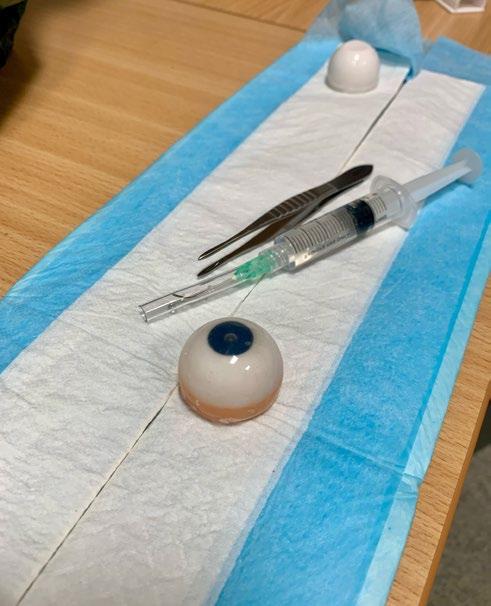
Anaesthetists at Lismore Base Hospital in NSW have embraced the use of “phantom” objects for simulation teaching and practice in more ways than one.
They have created their own custom-made phantom body parts to help anaesthesia trainees prepare for regional anaesthesia procedures.
Lismore anaesthetist, FANZCA Dr Rustin Quin, says the hospital’s anaesthesia department wanted to ensure the younger generation of anaesthesia trainees had access to the best training opportunities.
“Many of us in the department are passionate about passing on regional anaesthesia skills to the next generation of anaesthetists who rotate through our department on a regular basis. While there is never a substitute for learning on the job it is often prudent to start learning on a regional phantom,” he explains.
Phantom objects are often used as aids in simulation training for trainees and medical specialists. At Lismore, phantom eyeballs are used for simulation training in regional anaesthesia.
Dr Quin says there are many commercially available phantoms from a host of companies that provide good teaching substitutes to enable registrars to practise their skills.
“However, cost and limited life means that these are not always available to every department. With this in mind the department have set out on the journey of making our own high quality regional anaesthesia phantoms and have been pleased with the result.”
Dr Quin and his colleagues have developed a model using 3D printing and modelling techniques that can be used to teach registrars about subtenon eye blocks before their first eye procedure lists.
“We believe our model has most of the necessary elements to create the feel of performing an actual block,” he explains.
“The model allows you to lift up the epiretinal membrane and place a needle into the subtenon space. The best part about the model is that once it has been used a few times the membrane can be easily replaced and the eyeball used again for the next teaching session.”
The department is now hoping to further develop the phantom model for a skull model with artificial eyelids.
Dr Quin says a forum where other anaesthesia departments could share their own experiences of developing phantom models would be useful for collaboration and knowledge sharing.
*Dr Quin can be contacted at: Rustin.Quin@health.nsw.gov.au

If it can be estimated that 70-80 per cent of all aviation accidents and incidents can be attributed to deficiencies in non-technical skills1, then can we draw a parallel with healthcare?
In 2016, the British Medical Journal published eight years worth of data showing "medical error" as the third leading cause of death in the US2. The researchers from John Hopkins University cautioned that the causes were not due to "bad doctors" but represented systemic problems and poorly coordinated care. "To Err is Human" by Institute of Medicine (US) Committee on Quality of Health Care in America, in the late 1990s also recognised the prevalence of these medical errors and patient related deaths were brought to the forefront of healthcare safety3
Military and civilian aviation industries are well renowned for the delivery of human factors education, assessment, and application to maximise safe and efficient operations4 This is due to a legislative requirement but over time, these safety critical industries have grown to view it as a strategic mainstay for continuing success.
In medicine, however, the term "human factors" has many meanings. Perhaps at times, this has caused more confusion than clarity among the wider healthcare team. Associate Professor Stuart Marshall, in his recent 2023 editorial article5, calls for a ‘deeper understanding of human factors in anaesthesia’. He articulates and defines more accurately the contemporary and complete meaning of the term ‘human factors’. Associate Professor Marshall urges us to go beyond ‘the human’ in clinical incidents, ‘non-technical skills’, ‘soft skills’, and ‘teamwork competencies’.
These terms are just a small part of human factors as a scientific discipline. As its own field of study, human factors/ ergonomics (HF/E) recognises that we work in complex sociotechnical systems, where humans interact with each other executing complex procedures while using specialised equipment. Ergonomics, as a profession, applies theory, principles, data, and methods to design and optimise human well-being and overall system performance.
In Perth, Western Australia, three anaesthetists from three separate health service providers are unified in tackling the challenge of integrating human factors beyond anaesthesia and into their wider organisations.
Clinical lead Dr Thy Do works alongside the Royal Perth Bentley Group (RPBG) Hospital executive to assist in their knowledge and application of human factors in healthcare.
In 2024 Dr Do will establish a ‘Centre of Excellence for Healthcare Human Factors’ (CEHHF) which includes collaborative research and the development of HF competencies for staff using behavioural markers, by HF academics from the School of Psychological Sciences at the University of Western Australia.
The centre aims to shift the organisation into a world of high-reliability system6 by providing the hospital’s safety and quality team with a contemporary skillset in systems thinking and human factors approaches. These skills may include frameworks7 such as root cause analysis and action8, SEIPS9, FRAM10, ACCIMAP11, STAMP12, FMEA13, and SHERPA14 to better understand, not only the cause/s of incidents, but to determine system changes for improved care. A recently established human factors fellowship for ANZCA trainees now runs out of the Department of Anaesthesia and Pain Medicine where fellows help deliver HF education and conduct quality improvement projects for the hospital.
RPBG, via the CEHHF, will continue to deliver their pioneering foundational HF training course for healthcare – NEXUS, which to date, over 4000 staff have participated. Devised in 2018 in collaboration with a military aviation HF specialist, NEXUS delivers standardised training and brings together lessons learned from other safety-critical industries (for example: aerospace, nuclear, military and emergency services).
Dr Emelyn Lee (Consultant Anaesthetist and Director of Clinical Training with the medical education unit) in conjunction with the Centre for Nursing Education has developed a simulation-based education program with a focus on human factors in healthcare.
Practising for patient safety is a small-group stream running throughout the year based around key human factor topics for junior doctors and nurses. This aims to provide skill practice in a simulated environment with interprofessional groups. This is consolidated further by simulation scenarios in clinical areas for the teams to participate in.
Funding for the program is limited and the program runs on the enthusiasm of a small cohort of professional staff who are generous with their time and are committed to the cause.
SOUTH METROPOLITAN HEALTH SERVICE (SMHS) SMHS HAS BEEN PART OF THE HUMAN FACTOR MOVEMENT SINCE 2022 WHEN THE INITIATIVE WAS ALIGNED WITH THE SERVICE OPERATIONAL PLAN AND STRATEGIC PRIORITIES.
With the invaluable help of the project management team (Funded by the executive team) and Clinical Lead Dr Barbara Biki (consultant anaesthetist) the program was developed and launched in March this year.
Human factor ambassadors will lead training modules that will be delivered over nine sessions of one hour each with the aim of developing a strong safety culture and building organisation-wide knowledge of human factors.
The human factors team see their efforts as a first step towards a cultural change within the organisation.
Human factor enthusiasts are identified within the organisation and will review clinical incidents with a focus on human factors, adding valuable insights and understanding of the real crux of adverse events.
Sourcing resources and funding for initiatives such as those described above are often limited and contentious. Metaanalytic studies15,16 have previously demonstrated a return on investment (ROI) and reduction in patient harm when there is investment in similar training.
For instance, Moffat-Bruce et al from 2010-2013 demonstrated via early crew resource management (CRM) training that a 25.7 per cent reduction in adverse events relative to expected was achieved with a $US3.6 million investment in training. The estimated overall savings ranged from $US12.6- $28 million showing an ROI of $US9.1-24.4 million relative, in a healthcare setting.
Anaesthesia as a speciality holds the deeper understanding and needs to lead the integration of human factors into their wider organisation17. Are similar initiatives happening right across the ANZCA community? If so we would like to hear from you at RPBG.Nexus@health.wa.gov.au for opportunities to collaborate.
Dr Thy Bao Thuy Do, FANZCA
Director of Operations, Foundational Human Factors Program for Royal Perth Bentley Group; associate research fellow, School of Psychological Sciences, University of Western Australia; executive member for Professional Practice Research Network, ANZCA
Dr Barbara Biki, FANZCA
Deputy Director of Clinical Services for Armadale Kalamunda Group; Deputy Head of Department, Anaesthesia and Perioperative Medicine at Fiona Stanley and Fremantle Hospital Group
Dr Emelyn Lee, FANZCA
Director Clinical Training (Simulation) Sir Charles Gairdner Osborne Park Health Care Group; King Edward Memorial Hospital, Women & Newborn Health Service
References
1. Wiegmann DA & Shappell SA. A Human Error Approach to Aviation Accident Analysis: The Human Factors Analysis and Classification System (1st ed.). London: Routledge. 2003. https://doi.org/10.4324/9781315263878
2. Makary AM, Daniel M. Medical error - the third leading cause of death in the US British Medical Journal 2016;353:i2139
3. Institute of Medicine. To Err Is Human: Building a Safer Health System. Washington, DC: The National Academies Press. 2000. https://doi.org/10.17226/9728.
4. International Civil Aviation Organisation (ICAO). Working Paper Assembly – 40th Session Inspector Competencies for Effective Safety Management (Presented by Australia, New Zealand, Singapore, and the United Kingdom, and co-sponsored by Italy and North Macedonia). Montreal: ICAO. 2019.; International Air Transport Association (IATA). Competency Assessment and Evaluation for Pilots, Instructors and Evaluators - Guidance Material, (2nd Edition). Montreal: IATA. 2023.
5. Marshall SD Human error doesn’t exist in isolation: it’s now time for a deeper understanding of human factors in anaesthesia Anaesthesia. 2023, 78, 407-410
6. World Health Organisation (WHO). Global Patient Safety Action Plan 2021-2030: Towards eliminating avoidable harm in health care. Geneva: WHO. 2021.
7. Department of Health, Queensland Best practice guide to clinical incident management (2nd ed.). Fortitude Valley: Patient Safety and Quality, Clinical Excellence Queensland; 2023
8. Institute for Healthcare Improvement (IHI). RCA2: Improving Root Cause Analyses and Actions to Prevent Harm. Boston, MA: IHI. 2015.
9. Carayon P, Schoofs Hundt A, Karsh BT, et al. Work system design for patient safety: the SEIPS model. BMJ Quality and Safety in Health Care. 2006;15 Suppl 1(Suppl 1):i50-i58. doi:10.1136/qshc.2005.015842
10. Hollnagel E. Barriers and accident prevention. Aldershot: Ashgate. 2004.
11. Rasmussen J. Risk management in a dynamic society: a modelling problem. Safety Science. 1997 Nov 1;27(2-3):183213.
12. Leveson N. A new accident model for engineering safer systems. Safety Science. 2004 Apr 1;42(4):237-70.
13. DeRosier J, Stalhandske E, Bagian JP, Nudell T. Using health care failure mode and effect analysis™: the VA National Center for Patient Safety’s prospective risk analysis system. The Joint Commission journal on quality improvement. 2002 May 1;28(5):248-67.
14. Embrey DE. SHERPA: A systematic human error reduction and prediction approach. In Proceedings of the international topical meeting on advances in human factors in nuclear power systems. 1986.
15. Buljac-Samardžić M, Dekker-van Doorn CM, Maynard MT. What Do We Really Know About Crew Resource Management in Healthcare?: An Umbrella Review on Crew Resource Management and Its Effectiveness. Journal of Patient Safety. 2021;17(8):e929-e958. doi:10.1097/PTS.0000000000000816
16. O’Dea A, O’Connor P, Keogh I. A meta-analysis of the effectiveness of crew resource management training in acute care domains. Post Graduate Medical Journal, 2014; 90:699708.
17. Kelly, F.E., Frerk, C., Bailey, C.R., Cook, T.M., Ferguson, K., Flin, R., Fong, K., Groom, P., John, C., Lang, A.R., Meek, T., Miller, K.L., Richmond, L., Sevdalis, N. and Stacey, M.R. (2023), Implementing human factors in anaesthesia: guidance for clinicians, departments and hospitals. Anaesthesia, 78: 458478. https://doi.org/10.1111/anae.15941

The final weeks of the first trimester of our Course in Perioperative Medicine are approaching and it is pleasing that our first cohort of 28 has two physicians and a surgeon, as well as anaesthetists, including two who are fellows of the Royal College of Physicians and Surgeons of Canada.
They are doing unit of study 1 (preoperative assessment) and unit of study 2 (preoperative planning) that includes online course work, a workshop (held in the first week of March) and clinical immersion at one of the 18 affiliated hospitals across Australia and New Zealand. Trimester 1 concludes on 28 April.
The clinical component is the point of difference that makes our course unique among other perioperative medicine qualifications around the world.
Enrolments are open until 28 April for clinicians in these hospitals from our stakeholder colleges to do unit of study 3 (optimisation) and unit of study 4 (intraoperative impacts on patient outcomes) and later in the year, participants will be able to do unit of study 5 (postoperative assessment and management) and unit of study 6 (discharge planning and rehabilitation).
Each unit of study requires participants to complete 40 hours of online learning, 40 hours of clinical immersion and a oneday weekend workshop.
We are grateful to the supervisors at the 18 hospitals who became graduates of the Chapter of Perioperative Medicine (GChPOM) via the recognition pathway process. Just over 800 leaders in perioperative medicine applied for the GChPOM by the 1 December 2023 cut-off (GPs have until September to apply) and so far, 514 of these have been assessed and approved by the Recognition Pathways Working Group.
Throughout 2024 we’ll continue discussions with additional hospitals interested in providing a clinical learning environment for the course and will update the list of participating hospitals on our website so that fellows interested in doing the course are aware whether their hospital is participating. Enrolment in the course will be possible for future trimesters.
We will continue to explore how clinicians who aren’t employed at participating hospitals can enrol in the course.
ANZCA (including FPM) will also be engaging with our stakeholder colleges and societies to encourage enrolments – the College of Intensive Care Medicine, the Royal Australasian College of Physicians (geriatricians, and internal and rehabilitation medicine specialists), the Royal Australasian College of Surgeons, the Australian College of Rural and Remote Medicine, Royal Australian College of General Practitioners (RACGP) and the Royal New Zealand College of General Practitioners (RNZCGP).
Work is under way on developing an advocacy strategy that will involve building relationships with governments in all Australian and New Zealand jurisdictions.
Meanwhile, work is well under way to establish our Chapter of Perioperative Medicine by the end of the year. This aligns with ANZCA’s long-term strategic goal of embedding perioperative medicine as a discipline that improves clinical care and patient outcomes.
A lot of work will need to be done in order to have the chapter in place by the end of this year. Functions of the chapter will include advocacy and engagement activities, delivery, quality and standards of the qualification in perioperative medicine and overseeing the process for awarding the chapter qualifications. We are also exploring the establishment of fellowship of the Chapter of Perioperative Medicine.
As a major project of the college, ANZCA’s Executive Leadership Team will have oversight of operational aspects of chapter development.
There are exciting times ahead and we thank all the staff and involved fellows (in particular Associate Professor Joel Symons who has led the work on content development) for making this important course a reality.
For more information about the Course in Perioperative Medicine please visit www.anzca.edu.au/education-training/ perioperative-medicine-qualification
Dr Vanessa Beavis and Dr Sean McManus Co-Chairs, Perioperative Medicine Steering Committee
ABOVE
Participants at a perioperative medicine workshop.
It is pleasing to see anaesthesia featuring strongly in the acknowledgement of excellence and innovation in healthcare, with Advanced Recovery Room Care (ARRC) announced recently as the winner of the 2023 SA Health Award “Enhancing Hospital Care”.
A perioperative bundle of care
ARRC is an anaesthesia-led bundle of care which interacts with clinicians and patients before, during, and after surgery.
Preoperatively, patients are screened for risk using the American College of Surgeons NSQIP Risk Calculator. This is a tool validated through data from millions of patients, and which can be consistently, rapidly and reliably applied by a range of practitioners ahead of surgery. Those with a predicted 30-day mortality of 0.5-5 per cent are considered “medium risk” and referred to ARRC.
Intraoperatively, ARRC staff attend the operating room and discuss the plans for the case with the surgeons and anaesthetist prior to commencement of the list, and stay in close touch during the surgery.
Postoperatively, ARRC staff meet the anaesthetist on arrival in recovery and manage care until the morning of day one in a space with continuous monitoring, high nurse to staff ratios, very ready access to anaesthesia-skilled medical staff, and underpinned by highly structured processes and procedures.
Strong evidence of benefit
Published data now clearly show it has a very large positive impact on patient outcomes, and on hospital capacity and costs.1,2 Further, it is welcomed by all specialties, and administrators, as a model to improve patient care in a costeffective manner.
Feasible for most hospitals
ARRC at the Royal Adelaide Hospital (RAH) started as three beds in a section of the recovery room. Whilst it has grown to 10 beds in a large hospital with complex elective and emergency casemix, is practically and financially viable in its original form for many hospitals. It sits comfortably alongside our intensivist-led high-dependency unit and intensive care unit.
Opportunities arising from specialist perioperative care and training
It is a strong example of the benefits of a focus on perioperative medicine. Further, as a model with interaction with and input from all peri-operative specialties, it is an example of the benefits of specialist peri-operative education and training, such as that being rolled out with the Chapter of Perioperative Medicine
National collaborative
ARRC staff at RAH continue to talk to hospitals in Australia, New Zealand and other countries about the model and regularly host visitors.

ABOVE
We see substantial merit in an Australia and New Zealand network to share progress and innovations, and ultimately to grow a database (registry) to look at outcomes and test new ideas.
We will hold seminars on “Building an ARRC” and network opportunities as part of the combined meeting of the Perioperative Medicine Special Interest Group and Summit III on the Hidden Pandemic of Postoperative Complications at the Sofitel in Melbourne from 22-24 November 2024. https://www.youtube.com/watch?v=CWhxxvgPQMw
Professor Guy Ludbrook, FANZCA
Professor of Anaesthesia, University of Adelaide and Royal Adelaide Hospital
Medical Lead, Advanced Recovery Room Care (ARRC)
References
1. Ludbrook G, Grocott MPW, Heyman K, Clarke-Errey S, Royse C, Sleigh J, Solomon LB. Outcomes of Postoperative Overnight High-Acuity Care in Medium-Risk Patients Undergoing Elective and Unplanned Noncardiac Surgery. JAMA Surg. 2023 Jul 1;158(7):701-708.
2. Leaman EE, Ludbrook GL. The Cost-Effectiveness of Early High-Acuity Postoperative Care for Medium-Risk Surgical Patients. Anesth Analg. 2023 Nov 22. doi: 10.1213/ ANE.0000000000006743. Epub ahead of print. PMID: 38009844.
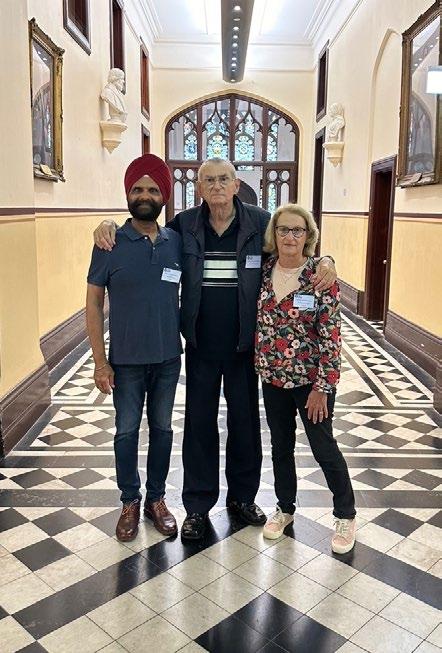
Dr John “Joe” McGuinness and Dr Elizabeth O’Hare have clocked up nearly 70 years between them running the annual NSW Anaesthesia Continuing Education (ACE) Anatomy Workshop, the popular day-long course that has attracted hundreds of fellows and anaesthesia registrars since 1988.
The pair held their final workshop at the University of Sydney late last year and have fond recollections of their years running the flagship course with the support of the anatomy team at the university’s School of Anatomy.
“Joe really is the hero of the workshop and its history,” Dr O’Hare, who will soon retire from clinical practice, told the ANZCA Bulletin.
“I don’t think the consultants and registrars who enrol in the workshop expect to get as much out of it as they do. They get to experience a different way of looking at the body as anaesthetists.
”Each workshop has between 40 -50 participants and eight demonstrators, all practising anaesthetists. Specimen cadavers that are prepared and maintained under strict conditions by the university’s anatomy team are used exclusively for anaesthetists.
“Joe is incredibly good at what he does and his knowledge of head and neck anatomy is incredible,” Dr O’Hare explains.
“He has been a mentor of mine since we met at St Vincent’s Hospital in Sydney when I was a registrar. He was a superb anaesthetist and he has also made something like 40 trips with Interplast over the years to the Philippines and the Solomon Islands supporting anaesthesia in Pacific countries.”
Dr McGuinness retired from clinical practice at St Vincent’s Hospital and St Vincent’s Private several years ago and is a keen fly fisher. His involvement with the workshop began in the late 1980s when he collected a group of anaesthetists, all experts and enthusiasts in various regional anaesthetic techniques to develop the workshop with the support of the University of Sydney’s anatomy team.
The workshop was the first in Australia, and perhaps the world to use specially dissected cadavers for the sole purpose of demonstrating local anaesthetic blocks and other procedural techniques with a fully "hands on" approach.
Dr McGuinness was awarded a Medal of the Order of Australia (OAM) in the 2008 Queen’s Birthday Honours list for “service to medicine in the field of anaesthesia, to medical education, and through the provision of humanitarian assistance to communities in the Asia-Pacific region.”
He says while there is less emphasis on anatomy in today’s medical degree courses, advances in ultrasound techniques have helped anaesthetists with regional anaesthesia practice.
Carolyn Jones Media Manager, ANZCA
The Gender Equity Sub-committee (GESC) is pleased to publish the gender metrics report for 2023.
Our college strongly endorses gender equity because of its ethical, social, and economic benefits to our fellows, trainees, specialist international medical graduates (SIMGs) and the broader community and will continue to progress work in support of the goals within the Gender Equity Action Plan (2023-2025).
We’re committed to regularly reporting on gender metrics, to understand how gender equity affects fellows, trainees and SIMGs, tracking trends and patterns as they emerge over the years.
Historical gender imbalances in the specialties of anaesthesia and pain medicine continue to incrementally shift as more women enter the training program annually. However, this evolution remains slow, with data indicating fewer fellows are retiring at 65.
With leadership as a central focus of the action plan, there has been another substantial increase in the representation of women in leadership roles in recent years. This progress not only contributes to closing the gender gap but also empowers women to wield a more influential voice in the fields of anaesthesia and pain medicine.
Eight of the ten directors of professional affairs in the college are women, along with the executive director of professional affairs.
Women hold 26 per cent of the heads of department positions for anaesthesia and 24 per cent are pain unit directors. This figure has remained relatively consistent over the past few years. Women in leadership roles in hospitals are lower than the general fellowship population. The GESC recognises that inequity in the workplace is often a systemic issue which sits outside the remit of the college.
ANZCA continues to make substantial inroads with increased representation of women on committees. Women now hold 58 per cent of all committee chair roles compared to 25 per cent in 2019.
In terms of new fellows, a similar percentage of women commencing the ANZCA training program are completing the program, indicating that there is very little attrition throughout the training period. This indicates that women are not exiting the program to pursue an alternative specialty or departing for family or other commitments throughout the training period.
Now, more than ever, it is essential that data is captured and reported to ensure continued progress can be monitored. In 2022 the GESC undertook a survey which was sent to fellows of ANZCA aimed to document issues affecting gender equity
36% of ANZCA fellows are women, 64% are men
32% of FPM fellows are women, 68% are men
33%
percentage point increase in women committee chairs at ANZCA since 2019
References
in the anaesthesia workplace. A response rate of 38 per cent was achieved, with women representing a greater proportion of respondents (64.2 per cent).1 On average, women worked fewer hours than men and spent a larger percentage of time in public practice; however, satisfaction rates were similar between genders.
There was a gender pay gap which could not be explained by the number of hours worked or years since achieving fellowship. The rates of bullying and harassment were high among all genders and have not changed in 20 years since the first gender equity survey by Strange Khursandi in 1998.2 Diversity, equity and inclusion as it applies broadly to the specialities of anaesthesia and pain medicine is a particular area of focus for us in 2024, with a series of actions and initiatives planned to enhance work in this space.
A toolkit designed by the GESC is due for release later this year which will also enable hospital departments to run their own independent survey to measure metrics and compare these to the reported national average results.
Please visit the webpage to view the full ANZCA gender metrics report and GESC upcoming activities: anzca.edu.au/ about-us/our-culture/inclusion-and-diversity/gender-equity
Women make up 43% of ANZCA trainees 43%
The number of women SoTs
2 women convened the 2023
1. Stewart CH, Carter J, Purcell N, Balkin M, Birch J, Pearce G, et al. Does gender still matter in the pursuit of a career in anaesthesia? Anaesth Intensive Care. Published online November 25, 2023. doi:10.1177/0310057X231212210
2. Strange Khursandi DC. Unpacking the burden: gender issues in anaesthesia. Anaesth Intensive Care 1998; 26: 78–85.
22%
percentage- point increase in women on ANZCA Council since 2019
6%
decrease in women as lead investigator in research projects
26% of head of department roles in anaesthesia are occupied by women

The announcement of the Australian of the Year is a time for our society to come together and celebrate people trying to make significant contributions to life in Australia. Since Rosie Batty received the award in 2014 as a family and domestic violence (FDV) campaigner, the reported rates in Australia have not changed. In this article, FANZCAs Associate Professor Dr Ken Harrison and Dr Claire Stewart explain how the reporting of FDV is fraught with errors since most instances go unreported.
They have used terms according to the scholarly accepted definitions by the Australian Institute of Health and Welfare (AIHW) that encompass behaviours that may not have been legally enforced and acknowledge the significant barriers victims/survivors face in attaining justice.
The Australian Bureau of Statistics Personal Safety Survey 2021-22 (ABS PSS) reported that one in six women and one in 18 men have experienced physical and/or sexual violence by a current or previous cohabiting partner since the age of 15.
One in four women and one in seven men have experienced emotional abuse by a current or previous cohabiting partner since the age of 15. Perpetrators are male in at least 75 per cent of cases. Women’s violence is more often committed in self-defence (Capaldi, 2012).
There are highly visible ways in which we will be involved in caring for those who are victims of violence in our clinical roles on trauma teams and in theatre. In 2021-22, three in 10 (32 per cent or 6500) assault hospitalisations were due to family and domestic violence (ABS PSS), where in 63 per cent the perpetrator was a spouse or domestic partner and 37 per cent reported the perpetrator as a parent or other family member.
We are well prepared for the clinical aspects of such roles through our rigorous trauma training. Prior treatment for physical assault in hospital is associated with a 10-times risk of death by assault (AIHW 2010-2019) and thus we should always strive to get further help for our patients who are victims. FDV victims also need higher level input from the established systems in pain management, psychological supports and social work.
There are resources available for access in the event that we need support managing the potentially “second victim” effect we may experience from being involved in such cases, for which we can use local resources (Employee Assistance

Program) or broader supports (for example, having our own GP, hot debriefing per ANZCA’s toolkit, and utilising psychological services such as ANZCA’s CONVERGE).
There is also a less visible and more confronting way in which anaesthetists may be affected by DV. Based on the numbers presented, from a body of 6000 FANZCAs and trainees, we can assume that both victims and perpetrators of DV work alongside us every day.
One of the major goals expressed in The State of Knowledge Report on Violence Perpetration (Flood, 2022) is to “reorient prevention efforts to have a greater focus on preventing initial and ongoing perpetration”. Neither perpetrator nor victim educational and/or socio-economic status affect FDV rates (Flood; Garth; Mackey; Stith). There is therefore no reason to think members of the college have protective factors.
Domestic and family violence is linked to gender inequitable power balance and rigid traditional gender roles – the recent ANZCA Gender Equity Survey did find that male anaesthetists were more likely to have a non-working or part-time working partner, which may reflect the presence of these risk factors.
The Flood report highlights that people who become defensive about the reality of domestic violence actively impair progress towards prevention. If we allow the creep of conversations excusing behaviour because “not all men” and “women use violence too”, we can become part of the ecology in which FDV behaviours may continue to thrive.
Abusive behaviours across personal, relationship and situational domains can escalate with loss of employment, use of drugs and alcohol, pregnancy, separation, natural disasters or events such as football finals.
Anaesthetists’ long working hours, high stress working environment and high renumeration may all contribute to a worsening of these factors and drive potential perpetrators to harm. In most cases of physical violence there has been a period of coercive control beforehand, this is where prevention is most possible.
We must start talking about preventing perpetration. The Flood report highlights that perpetration should be seen as a social-ecological model – they do not see much progress by asking individual perpetrators to examine and make changes, but that we must work together to identify the ecological norms that have allowed such high prevalence of FDV to exist.
While we do not have the data for anaesthetists, we can commit to all being part of a strategy by refusing to support violence and hostile masculine attitudes. It is also possible to reduce the likelihood that individuals at risk of or already perpetrating violence will start using, persist in or intensify their use of violence.
The risk factors for perpetration include both factors that are relatively static (such as childhood trauma histories and personality traits) and others that are relatively malleable (such as peer influences) (Scott, AIHW). Changing the more malleable risk factors, mitigating the negative influence of more static risk factors, and boosting protective factors can discourage individuals’ use of violence or steer them away from the ongoing use of violence.
Maintaining our own wellbeing and encouraging a culture of wellbeing may be a large part of these mitigating factors. Getting adequate rest and relaxation and avoiding poor coping strategies like alcohol and substance abuse may reduce perpetration.
At an organisational level, the First Action Plan 2023-2027 was unveiled by Australia’s state and federal governments outlining strategies to end violence against women and children. ANZCA will contribute, notably to:
Action 1: “advancing gender equality” through the Gender Equity Subcommittee (GESC).
Action 6: “to prevent and address sexual violence and harassment in all settings” after the finding in the 2022 GESC survey that 48 per cent of female anaesthetists have experience harassment in the workplace.
Action 5: “strengthen systems and services to better hold people who choose to use violence to account and provide opportunities to support people who have used violence, or are at risk of using violence, to change their behaviours, with the aim of protecting the safety and wellbeing of current and potential victim-survivors.”.
By having open conversations with colleagues in our workplaces outlining acceptable and unacceptable behaviours, we can all drive a social-ecological model of safety for all our community.
If you are affected by this article, or need more support – please contact these family and domestic violence support services:
1800 RESPECT national helpline: 1800 737 732
Men’s Referral Service: 1300 766 491
Lifeline (24-hour crisis line): 131 114
Relationships Australia: 1300 364 277
Associate Professor Ken Harrison, FANZCA
An anaesthetist and trauma consultant, he co-led a Royal Australasian College of Surgeons’ family violence symposium in November 2022 during which he spent significant amounts of time listening to victims/survivors.
Dr Claire Stewart, FANZCA Chair ANZCA Gender Equity Sub-committee
Dr Stewart recognises the importance of promoting safety for all members of society.
References
Australian Institute of Health and Welfare 2021. Examination of hospital stays due to family and domestic violence 2010-11 to 201819. Cat. no. FDV 9. Canberra: AIHW.
Duval, A., B.A. Lanning, and M.S. Patterson, A Systematic Review of Dating Violence Risk Factors Among Undergraduate College Students. Trauma, Violence, & Abuse, 2020. 21(3): p. 567-585.
Capaldi, D.M., et al., A Systematic Review of Risk Factors for Intimate Partner Violence. Partner Abuse, 2012. 3(2): p. 231-280. 133.
Clare, C.A., et al., Risk Factors for Male Perpetration of Intimate Partner Violence: A review. Aggression and Violent Behavior, 2021. 56: p. 101532. 134.
Costa, B.M., et al., Longitudinal Predictors of Domestic Violence Perpetration and Victimization: A systematic review. Aggression and Violent Behavior, 2015. 24: p. 261-272. 135.
First Action Plan 2023-2027, A joint Australian, state and territory government initiative, ISBN: 978-1-920851-67-5.
Flood, M., Brown, C., Dembele, L., and Mills, K. (2022) Who uses domestic, family, and sexual violence, how, and why? The State of Knowledge Report on Violence Perpetration. Brisbane: Queensland University of Technology.
Garthe, R.C., T.N. Sullivan, and M.A. McDaniel, A Meta-analytic Review of Peer Risk Factors and Adolescent Dating Violence. Psychology of Violence, 2017. 7(1): p. 45-57. 136.
Mackay, J., et al., Risk Factors for Female Perpetrators of Intimate Partner Violence Within Criminal Justice Settings: A systematic review. Aggression and Violent Behavior, 2018. 41: p. 128-146. 137.
Mannell, J., et al., Risk Factors for Violence Against Women in Highprevalence Settings: A mixed-methods systematic review and metasynthesis. BMJ Global Health, 2022. 7(3): p. e007704. 138.
Scott, K., 30/3/23, Who perpetrates domestic violence and who are their vitimcs? ABC Everyday website <https://www.abc.net. au/everyday/who-perpetrates-domestic-violence/102034306> accessed 5/3/24.
Stith, S.M., et al., Intimate Partner Physical Abuse Perpetration and Victimization Risk Factors: A meta-analytic review. Aggression and Violent Behavior, 2004. 10(1): p. 65-98.
.

The Lancet Commission on Global Surgery and the World Federation of Societies of Anaesthesiologists (WFSA) have shown that unless heavy investment is made into training larger workforces, unsafe surgery and anaesthesia will continue on a global scale.
A minimum safe anaesthesia workforce of five physician anaesthesia providers (PAP) per 100,000 population is currently recommended.1 Australia has 23 PAP per 100,000 population and Aotearoa New Zealand 21. This is in stark contrast to Pacific countries such as Fiji with three PAP per 100,000, and Samoa and Vanuatu with 1.5.2
At the current level of funding many countries across the Pacific will not meet this minimum target.
The New Zealand Society of Anaesthetists’ Global Health Committee (GHC) works collaboratively with Pacific, Australian, and global organisations towards the development of anaesthesia services and regional training for a safe anaesthesia workforce across the Pacific.
In 2021, the GHC launched the Pacific Anaesthesia Collaborative Training (PACT) Program to support the costs of training anaesthetists within the Pacific region, helping with the development of a safe, sustainable anaesthesia workforce.
LEFT
Dr Indu Kapoor, Dr Cecilia Vaai-Bartley, Dr Esjae Sesega and Dr James Dalby-Ball at the 2023 Pacific Society of Anaesthetists’ Meeting.
Funding a Pacific Island anaesthesia trainee through the Fiji National University (FNU) four-year MMed Anaesthesia program costs about $NZ20,000 a year ($A18,500).
Dr Indu Kapoor, ANZCA fellow, member of the Global Health Committee, and founder and co-ordinator of the PACT Program says: “Due to limited health funding, many of the Pacific Islands struggle to fund specialist training and that’s where we can help. Eighty people donating the ‘cost of one coffee ($5) a week’ for four years to PACT can fund Masters Anaesthesia training for one Pacific doctor.”
“The GHC is grateful to our community of more than 80 anaesthetists and their friends who support the program and have started us on the journey to sustainably support the costs for in-region training of Pacific anaesthetists. It’s a long road ahead though.”
This year PACT will support five fellows from Samoa, Fiji and Vanuatu enrolled in FNU’s anaesthesia program.
As well as funding training, PACT advocates for building a sustainable Pacific anaesthesia workforce. This has led to successful collaborations with the Ralph and Eve Seelye Education Trust, Interplast, and the Pacific community.”
In December last year, the GHC and PACT Program celebrated a milestone with the graduation of inaugural PACT fellow Dr Cecilia Vaai-Bartley.
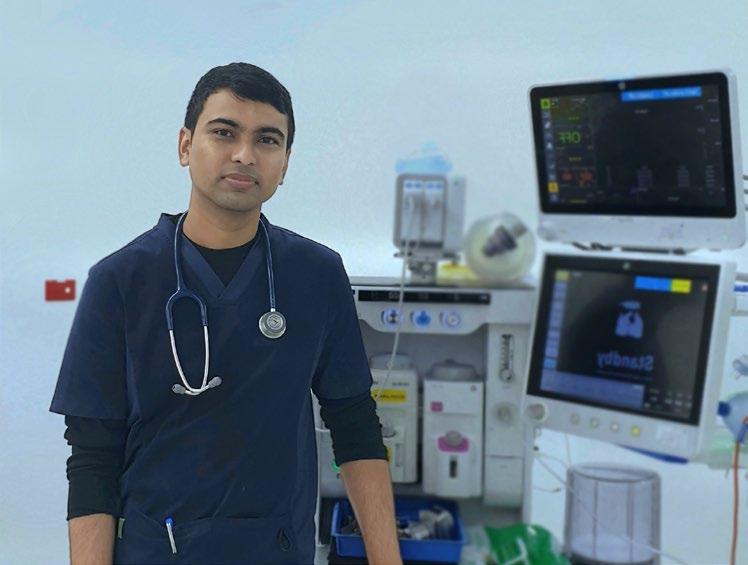
Receiving her MMed Anaesthesia Dr Vaai-Bartley has returned home to start working as a consultant in the anaesthesia and ICU department at Tupua Tamasese Meaole Hospital, Samoa. At her graduation, Dr Vaai-Bartley was also awarded the highest academic achievement in Masters Anaesthesia.
“Words are not enough to express my gratitude and appreciation for every contributor to PACT. Your contribution is helping Samoa’s health sector and most especially the people of Samoa,” she says.
Also from Samoa, PACT fellow Dr Esjae Sesega completed his diploma in 2023 and entered the Masters program at FNU this year.
“Last year was a remarkable journey”, Dr Sesega recalls. “Working in a completely different environment with diverse people and patient populations pushed me out of my comfort zone, exposed me to complex cases, and provided invaluable experiences. I’m determined to gain as much knowledge as possible with the goal of contributing to my dedicated team when I return home to Samoa. The support from PACT has been exceptional. They’ve been supportive and genuinely concerned about my well-being.”
The support provided by the PACT Program enabled Fijian fellow, Dr Nikish Narayan, to recommence his first year in the MMed Anaesthesia program after taking a break due to financial constraints.
“The academic year has been very fruitful and gaining practical experience has helped me consolidate my learning” Dr Narayan says. “Due to the geographical spread and patients presenting late, I have had to administer anaesthetics outside of Lautoka to provide life-saving surgery. Without
access to the usual equipment and drugs, I’ve had to rely heavily on foundational principles and apply a level of dexterity to ensure successful outcomes. Every challenge is a learning opportunity and I strive to continue learning and improving.”
Dr Indu Kapoor, FRCA, FANZCA PACT founder and co-ordinator, NZSA Global Health Committee
Dr Matt Jenks, FANZCA PACT co-ordinator, NZSA Global Health Committee
References
1. *Kempthorne, P., Morriss, W.W., Mellin-Olsen, J., & Gore-Booth, J. (2017). The WFSA Global Anesthesia Workforce Survey. Anesthesia and analgesia, 125(3), 981-990
2. https://wfsahq.org/resources/workforce-map/ (accessed 9.1.24)
Scan the QR code to visit the PACT page on the New Zealand Society of Anaesthetists’ website (www.anaesthesia.nz/ global-health-committee/ pact-donations) if you’d like to know more about PACT or to donate to support anaesthesia training in the Pacific.


The World Congress of Anaesthesiologists 2024, held in March in Singapore, welcomed a notable presence of anaesthetists from the Pacific region.
Organised in collaboration with the World Federation of Societies of Anaesthesiologists (WFSA) and the Singapore Society of Anaesthesiologists, this event marked the return of face-to-face interaction after a hiatus since 2016. Drawing over 5000 participants from 142 countries to the physical venue, the congress also saw an additional 560 delegates engage remotely.
The college’s Global Development Committee (GDC) supported four anaesthetists from Papua New Guinea (PNG) to attend the congress - Dr Pauline Wake, Dr Michelle Masta, Dr Gertrude Marun and Dr Melany Werror. These consultants were joined by a number of their colleagues from PNG, as well as the wider Asia-Pacific region ranging from the Cook Islands, over Samoa and Fiji all the way to Timor-Leste.
Dr Werror, a consultant working at Port Moresby General Hospital (PMGH), delivered a poster presentation on an obstetric anaesthesia case study, describing successful maternal cardiopulmonary resuscitation utilising basic clinical essentials in a resource limited setting. Dr Joyce Lawrence, also from PMGH, gave a poster presentation on her research project evaluating pain management and the benefits of the Essential Pain Management (EPM) education program in PNG.
This multicentre research project was jointly supported by the GDC and the Australian Society of Anaesthetists’ (ASA) Overseas Development and Education Committee (ODEC).
Delegates from Australia, New Zealand and Pacific nations including Papua New Guinea and the Cook Islands take time out for a ‘global health’ dinner during WCA 2024.
A highlight of the meeting was seeing Dr Gertrude Marun, working at Madang Provincial General Hospital, honoured with the WFSA’s Distinguished Service Award. Dr Marun received this award in recognition of her trail-blazing role as Papua New Guinea’s first female anaesthetist and only the third physician to attain the Masters of Medicine in Anaesthesiology from the University of Papua New Guinea.
Dr Marun was also a former Chief Anaesthetist for the country, advising government on policy and national requirements for safe surgery and anaesthesia, while also being a co-founder of the EPM course and a role model and mentor to many young anaesthetists. A feature article on Dr Marun and her outstanding career will appear in the Winter edition of the ANZCA Bulletin.
The World Congress brought together so many of our colleagues in the Asia-Pacific region and highlights the collaborative work of ANZCA’s Global Development Committee, the ASA’s Overseas Development and Education Committee and the New Zealand Society of Anaesthetists’ Global Health Committee to support training and professional development in our region.
Dr Yasmin Endlich Chair, Global Development Committee
Established in 1998, the Faculty of Pain Medicine (FPM) is the first multidisciplinary medical academy in the world devoted to education and training in pain medicine.
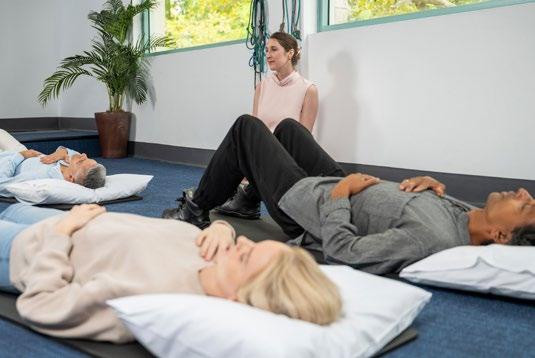
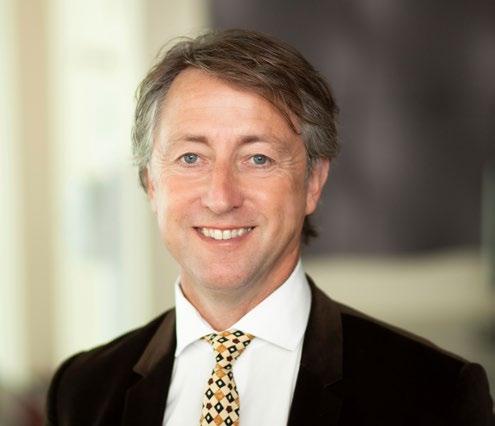
At the recent FPM Board meeting a few decisions were made that I would like to communicate to the fellowship.
We have simplified the practice assessment pathway for the Procedures Endorsement Program to make it faster and easier for fellows with an established procedural practice to gain endorsement. This change is in response to feedback from fellows that the paperwork required to submit an application was overly onerous. A strategic workshop was held in December 2023 with members of the Procedures Pain Medicine Committee and interested fellows to identify opportunities to grow the pool of endorsed fellows significantly over the next year.
In addition to streamlining the application process it was also agreed that many applications could be approved via a paper review. The options for a virtual interview or in-person assessment remain for when further information is required.
The requirement for fellows to certify that their practice is and will remain consistent with the PS11 (PM): Procedures in Pain Medicine Clinical Care Standard remains an important component of the process.
Contact Penny McMorran at pmcmorran@anzca.edu.au for more information.
The Professional Standards Committee has been retired with regional committees now reporting directly to the board and the key functions of document development and liaison with the ANZCA and FPM Continuing Professional Development (CPD) Committee and ANZCA Safety and Quality Committee moving to the FPM Professional Affairs Executive Committee
(PAEC). Mentoring will move to the training side of the ledger. This will hopefully streamline processes and I am sure one less committee will be seen as a positive.
The regional and national committee forum held at the FPM Spring Meeting in Adelaide last year informed the decision. The hope is that this will give the board greater insight into issues that are important locally and enable the local committees to understand the strategic direction of the faculty and their role in it.
The plan is for the faculty to follow what ANZCA does. This would involve inviting the chairs of the national and regional committees to present and discuss at board meetings on a rotational basis. This has been happening on an ad hoc basis for a couple of years but the plan is to formalise it on an annual basis. We plan to also formalise the role of board members on the local committees. Currently all board members are ex-officio on their local committee; now there will be one board member on each local committee whose role is to be a liaison between the board and the local committee.
In other developments, the faculty progressed all the requirements for the Australian Medical Council/Medical Council of New Zealand accreditation for 2023. We were actually ahead of the expected timeframe and have already planned and initiated the 2024 workplan. This remains a significant piece of work and occupies a lot of resources from our dedicated staff.
I would like to thank Melissa Viney, Juliette Whittington and Dilip Kapur for ensuring that we remain on track. We also remain on track with our assessment review with components planned to be implemented in the 2025 training year. A big thankyou to Tipu Aamir for all the effort and drive in steering this through.
Finally, two goodbyes. After three and a half years Leone English has decided to leave the faculty and retire from full time work. I would like to personally thank her for all the effort and drive she has provided in her time as executive director, in particular the significant leadership shown to progress the research priorities for the faculty and delivering the National Strategy for Health Practitioner Pain Management Education government grant and doing the work of representing the faculty within the college executive team. Thank you, Leone and all the best for the future.
The other goodbye is from me; this is my last Bulletin article. One of the first emails you receive as dean is being asked for a 600-word article on a topic of my choice and another 700 words honouring my predecessor. As someone with no literary skills this was a challenge.
Hopefully I have bluffed my way through it.
Dr Kieran Davis FPM Dean
We congratulate the following doctors on their admission to FPM fellowship through completion of the training program:
• Dr Chantelle Berenger, FRACGP, FFPMANZCA (NSW)
• Dr Michael Carpenter, FANZCA, FFPMANZCA (Vic)
• Dr Thomas Chalk, FANZCA, FFPMANZCA (Qld)
• Dr Karen Chan, FRANZCOG, FFPMANZCA (NSW)
• Dr Ashika George, FAFRM(RACP), FFPMANZCA (Qld)
• Dr Kamran Malick, FRACGP, FFPMANZCA (WA)
• Dr Sophie McGilvray, FRACP, FFPMANZCA (Vic)
• Dr Eric Ng, FHKCA (Anaesthesiology), FFPMANZCA (Hong Kong)
The faculty is seeking expressions of interest from FPM fellows and trainees to join the FPM Research Committee.
Be part of a group of enthusiastic committee members who are driving the FPM research annual plan to develop a research culture and promote translational and collaborative research in pain medicine.
Appointment criteria includes:
• Interest and experience in pain research.
• Peer esteem as a researcher.
• Willingness to contribute to the activities of the FPM Research Committee.
Please address the above criteria in your application, including a cover letter and CV, and indicate any particular areas of academic, clinical or research expertise. Include a cover letter and a CV. Other factors which will be considered include diversity, gender and regional representation.
Contact for information and expressions of interest: Nikki Frescos, FPM Research Development Lead at nfrescos@anzca.edu.au. Expression of interest close 19 April 2024.

FPM Research Network webinar series 2024
Hear from experts in the field and learn how the ANZCA Library can assist in your research endeavour.
The FPM Research Network Group is back with its highly anticipated research educational webinar series. We initiated the series with a dynamic session designed to sharpen your research skills, refine your research question and enhancing your search strategies. But that’s just the beginning. We have an exciting line-up of three additional webinars each designed to further your knowledge and skills.
Join us to gain valuable insights from experts in the field who will discuss practical tips and tools to give you confidence to develop a focused and well-defined research question to undertake your literature review.
Mark your calendars for future webinars: Thursday 18 April, (6-7pm AEST) –Types of literature reviews.
Thursday 27 June (6--7pm AEST) – Writing an article for publication.
FPM Spring Meeting 2024 (Auckland) (18 to 20 October, webinar date to be confirmed) – Are you being noticed – how to improve your research profile (how to use Pubmetrics, AIRR, ORCID and on social media with X and Linkedin).
To participate in these sessions, please email Nikki Frescos FPM Research Develop Lead nfrescos@anzca.edu.au for further information. Once confirmed the zoom link will be sent to you.
We look forward to seeing you.
3 MAY 2024 | BCEC BRISBANE | #FPM24BRIS
2024 FPM SPRING MEETING
18-20 October 2024, Pullman Auckland, New Zealand
Australian medical research is among the best in the world. Despite being ranked 55th for population, we are ranked fourth in the world for contributions to anaesthesia research.

Australian medical research is among the best in the world. Despite being ranked 55th for population, we are ranked fourth in the world for contributions to anaesthesia research.1
Innovative ANZCA-funded research, piloted by the Anaesthetic trainees and fellows, has played a pivotal role in these contemporary advances.2 The ANZCA Foundation dedicates $1.5million per annum to anaesthesia and pain research, with additional large grants from the Australian government’s National Health and Medical Research Council (NHMRC), and the Health Research Council in New Zealand.3,4
Metropolitan hospitals consistently embrace research as part of their standard business, producing over 1000 peer-reviewed papers per year.5 In contrast, rural hospitals are often overlooked as hubs for research generation, thus contributing to the scarcity of rural health service research in Australia. According to the Australian Bureau of Statistics Australian Standard Geographical Classification, the term ‘rural and remote’ refers to all areas outside major cities. About 30 per cent of Australians live in rural and remote areas,6 but only 1-5 per cent of research activities are taking place here.6
Clinical trials are linked to better health outcomes, quality of life, and patient engagement in their health care. Unfortunately, people in rural and regional areas don’t have equitable access, as introducing clinical trials in rural areas is fraught with challenges. A lack of funding, poor support arrangements, inadequate equipment or infrastructure, workforce size and retention versus demand are but a few of these limitations. This may be exacerbated if time consuming research reduces a clinician’s clinical time, relegating research to a low priority.
Despite these limitations, the Mackay Base Hospital (MBH) anaesthesia department has developed a process to effectively incorporate clinical trials into their daily practice, and the contributions they have made to the body of research are substantial.
According to the Australian Department of Human Services and Health, MBH is categorised as a large rural centre.7 As an individual hospital under the classification of rural health services, one would expect it to only contribute to a very small proportion of the 1-5 per cent of the nation’s/ state’s research. In defiance of these predictions, MBH has contributed 2.1 per cent of the total internationally recruited patients to the multicentre ANZCA Clinical Trials – PADDI, ROCKet, CHEWY, LOLIPOP, VAPOR-C, TRIGS and ECHONOF III.
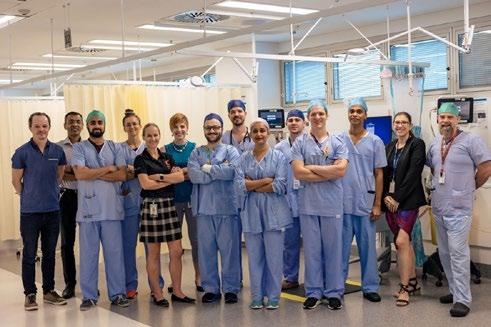
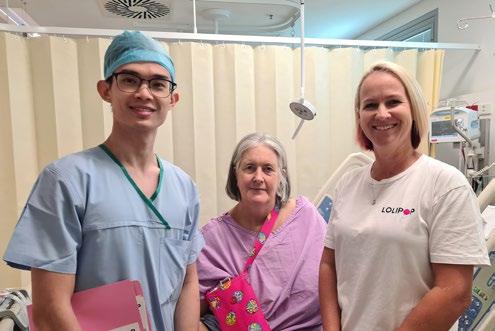

For example, the ROCKet trial, as of October 2023, recruitment had reached 4276 participants of a total of 4884.8 Of the 36 active sites in Australia, Hong Kong and New Zealand, Queensland has contributed 520 patients. Of this, MBH has contributed 172 patients, or 4.1 per cent of total recruitment, and an impressive 34.5 per cent of Queensland’s recruitment. This places MBH within the top ten recruiting sites worldwide.
Number of active hospitals
Total
sites in Australia, New Zealand, Hong Kong and South Africa
in Australia, Hong Kong and New Zealand
The Clinical Director of Anaesthesia, the Mackay Institute of Research and Innovation Clinical Trials nurse, and other members of the Mackay anaesthesia department, collaborated and recognised strategies to improve recruitment in clinical trials. These included:
• Enlisting resident medical officers on their anaesthesia rotation to aid in this process to fulfil their research requirements and help them gain insight into the intricacies of clinical research.
• A rotating roster with a dedicated recruiter to allow for consistent daily recruitment.
• Dedicated education about trial inclusion/exclusion criteria to ensure consistent recruitment processes.
• A systematic means of finding potential trial candidates.
• A dependable support network to help answer any questions or queries.
In 2018, after much brainstorming, the “Clinical Trials Tribe” was established. One junior doctor is allocated as the “trial tribe doctor” each day, and with the support from the clinical trials nurse, they are tasked with:
• Screening patients for the clinical trials by reviewing theatre and clinic lists.
• Recruiting patients.
• Following the patient through theatre, the postanaesthesia care unit, and their admission, ensuring that protocols are adhered to.
• Following up long-term study patients.
Behind the scenes, the clinical trials nurse is responsible for the imperative duties of patient randomisation, provision of the trial drug, arranging ongoing patient follow-up, and maintaining confidentiality standards.

Prior to being able to recruit patients, the medical staff are put through Good Clinical Practice (GCP) training. This ensures that the rights, safety, and confidentiality of participants in clinical trials are protected, and that the data collected in these trials, are accurate and credible.9
With research being a vital requirement for anaesthesia training, this innovative program has allowed many junior doctors to kickstart their careers in a protected, supportive environment. To most, the prospect of participating in research is daunting. This program allows one to gain valuable insight into a snapshot of multiple large multicentre trials, take leadership in the recruitment of appropriate patients, and gain a wealth of skills and knowledge to set them up for future research.
The concept of the “trial tribe” was presented at the 2023 ANZCA CTN Strategic Workshop, and the 2023 Australian Clinical Trials Alliance International Clinical Trials Symposium. Here, it was very well received, evidenced by the fact that other hospitals have since implemented their own hybrid version of this model.
Furthermore, the money these trials have earned has been able to fund six resident medical officer positions in Mackay at any one time. But, most importantly, it has also afforded the department a “state of the art” coffee machine, enabling us to live out our stereotypes, and enjoy 10 coffee breaks a day, at an affordable cost!
Dr Elle Dignan, Anaesthesia registrar
Dr Suresh Singaravelu, FANZCA, Senior Staff Specialist Anaesthetist, Mackay Hospital and Health Service
Ms Tracy Hess, BNSc, MACN Clinical Trials Co-ordinator
Dr Elayne Anderson, FANZCA
Dr Danny Bartlett, FANZCA, Clinical Director of Anaesthesia, Mackay Hospital and Health Service
References:
1. Gao, M., Liu, W., Chen, Z., Wei, W., Bao, Y., & Cai, Q. (2022). Global trends in anesthetic research over the past decade: A Bibliometric analysis. Annals of Translational Medicine, 10(10), 607–607. https://doi.org/10.21037/atm-22-1599
2. ANZCA FPM. (n.d.). Our clinical trials. ANZCA. Retrieved February 8, 2023, from https://www.anzca.edu.au/research/anzca-clinicaltrials-network/clinical-trials
3. ANZCA FPM. (n.d.). ANZCA Foundation. ANZCA. Retrieved February 8, 2023, from https://www.anzca.edu.au/research/anzcafoundation
4. Dyke, T., & Anderson, W. P. (2014). A history of health and medical research in Australia. Medical Journal of Australia, 201(S1). https:// doi.org/10.5694/mja14.00347
5. Alston, L., & Versace, V. L. (2023). Place-based research in small rural hospitals: An overlooked opportunity for action to reduce health inequities in Australia? The Lancet Regional Health - Western Pacific, 30, 100682. https://doi.org/10.1016/j. lanwpc.2022.100682
6. Barclay, L., Phillips, A., & Lyle, D. (2018). Rural and Remote Health Research: Does the investment match the need? Australian Journal of Rural Health, 26(2), 74–79. https://doi.org/10.1111/ajr.12429
7. Department of Primary Industries and Energy, & Department of Human Services and Health. (1994, November). Rural, Remote and Metropolitan Areas Classification 1991 Census Edition November 1994. Retrieved February 10, 2023, from https://www.pc.gov. au/inquiries/completed/nursing-home-subsidies/submissions/ subdr096/subdr096.pdf
8. The University of Melbourne. (n.d.). Rocket trial. Melbourne Medical School. Retrieved February 10, 2023, from https://medicine. unimelb.edu.au/research-groups/critical-care-research/critcare/ about-us/the-rocket-study
9. National Drug Abuse Treatment Clinical Trials Network. (n.d.). Good clinical practice. Good Clinical Practice. Retrieved February 11, 2023, from https://gcp.nidatraining.org/
ABOVE
Support and funding boost to sites to enhance clinical trial accessibility to regional, rural and remote patients into clinical trials: our collaboration with the Australian Teletrials Program
Clinical trials serve as the backbone of medical advancement, driving innovation and improving patient outcomes. However, for those residing in rural and regional populations, accessing these trials remains a challenge. One of the strategic goals of the ANZCA Clinical Trials Network is to expand its activities to rural and regional areas. With 30 per cent of the population residing in regional, rural and remote locations and 10 per cent undergoing surgery, the potential for impactful research is substantial, making trial results more generalisable to underrepresented populations.
Bridging gaps with the Australian Teletrials Program
The Australian Teletrials Program, funded through the Medical Research Future Fund (MRFF), emerges as a pioneering solution for increasing the involvement of regional and rural patients in clinical trials, presenting numerous advantages for patients and researchers alike. The ANZCA Clinical Trials Network is seizing this opportunity to enhance accessibility and inclusivity to rural and regional patients in clinical trials.
This initiative provides a unique chance for new and existing sites from both metropolitan and regional areas to receive additional resources and financial support specifically aimed at recruiting patients from regional, rural and remote areas. The Australian Teletrials Program is being rolled out in all states and territories except NSW and the ACT. The exclusion of these areas is addressed through an alternative program funded under the same MRFF scheme, the NSW regional, rural, and remote enabling program, which we aim to leverage soon.
Benefits to patients, hospitals, clinicians, and the healthcare system
The benefits of involving rural and regional patients in clinical trials are far-reaching. Patients experience better follow-up, earlier detection and treatment of complications, greater engagement with healthcare, and increased awareness of the healthcare system, resulting in higher satisfaction. Hospitals benefit from a culture of excellence and academic inquiry, improved engagement with healthcare

ABOVE
Research co-ordinators: Ms Tiki Baker-Pearson (Townsville Hospital), Ms Natasha Pearson (Goulburn Valley Health) and Ms Tracy Hess (MacKay Base Hospital).
teams, and the generation of valuable statistics and caseload data. Clinicians are invigorated in their workplace, stay abreast of global healthcare trends, and contribute to accurate workload quantification and healthcare delivery assessment. This expansion of trials into rural and regional populations presents opportunities for the network to benchmark clinical outcomes by comparing surgical patients from rural and regional areas with those in urban centres. The network’s research is designed to be embedded in daily practice, maximising its potential for translation into realworld improvements in patient care. Studies have shown that implementing findings from high-impact clinical trials could yield significant financial returns through better health outcomes and reduced healthcare costs.
Support and how to get involved
We encourage sites to connect with the ANZCA Clinical Trials Network office, explore potential trials, and learn about the benefits this initiative can bring to their rural and regional patients. The network office also helps in drafting business cases to employ a research co-ordinator and leverages the expertise of the ANZCA Research Co-ordinators Network (ARCN) to get research co-ordinators started.
Contact Karen Goulding on +61 3 9903 0942 or at ctn@anzca.edu.au.

Your membership gives you access to a wide range of resources, opportunities, and services specially designed to support you professionally and personally throughout your career and into retirement.
Exclusive use of our world-recognised post-nominals
Fellowship of ANZCA and FPM are internationally recognised hallmarks that indicate specialists of the highest professional standing. Only members can use the post-nominals FANZCA or FFPMANZCA. Access print and electronic versions of the FANZCA and FFPMANZCA logos for use on your professional communications and marketing collateral via our website.
Supporting your lifelong learning
Unlimited 24/7 access to our world-leading online continuing professional development (CPD) program is included in your membership. It has been specially designed to make sure you meet your mandatory requirements for clinical practice and fellowship. CPD opportunities are available online and in person through a broad series of curated events, courses and meetings.
Helping you to connect and collaborate
No one can understand the passion you have for your profession better than your peers, which is why we’re constantly creating new opportunities for you to connect and collaborate with colleagues across our countries and around the world. As a member, you get priority access to our program of events, courses, and workshops.
Advocating for you and your specialty
We're your voice in the community. We work closely with governments, peak health agencies, and the community to provide advice on clinical practice and advocate for the issues that matter to you, including patient care, clinical standards and doctors’ welfare.
Setting standards
We’re proud to be a leader in patient safety. Our professional documents, guidelines and safety alerts support you in your clinical practice, ensuring the safest and most advanced care in the world.
a safe, healthy, inclusive college culture
Training and practising as a specialist doctor can be tough. We’ve developed a range of resources and services to support you throughout your career, and made inclusion and diversity and doctors' health and wellbeing core components of our training curriculums, CPD, events, governance, and advocacy work.
A world-class medical library at your fingertips
ANZCA library provides access to a wide range of print and online resources, including books, journals, guides and databases, as well as specialist services to suit the clinical information needs of ANZCA and FPM fellows and trainees.
Expert research support
Our Research Consultation Service provides support through literature searching, publishing advice, and the research lifecycle to facilitate the translation of research-based evidence about anaesthesia, pain medicine and perioperative medicine into policy and practice.
Access to research funding
Every year, we make grant funding available to fellows who are novice, emerging or established researchers, for studies in anaesthesia, intensive care, pain or perioperative medicine.
College publications
Your membership entitles you to copies of popular inhouse publications including Australasian Anaesthesia (the Blue Book), Acute Pain Management: Scientific Evidence, the quarterly ANZCA Bulletin.
Recognising excellence
Our awards, prizes and medals recognise achievements in areas such as the advancement and promotion of specialist medicine; exam performance; clinical research; education; and pastoral care.
Find out more on our website: anzca.edu.au/fellowship/member-benefits
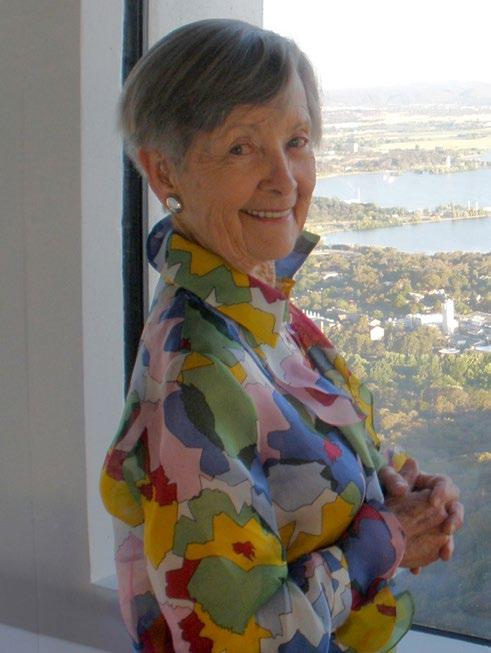
The foundation was very saddened to learn of the passing of its close friend, Governor Patron, and leading supporter, Mrs Ann “Tuppy” Cole, on 3 January.
Mrs Cole, loving wife of the late Dr Russell Cole, was the ANZCA Foundation’s largest individual private donor, donating a cumulative total of $A680,000 for medical research from 2014 to September 2023. Her giving has annually funded the $70,000 Russell Cole Memorial ANZCA Research Award, which the foundation, Mrs Cole and her two daughters worked together to establish in 2015 to support studies in pain medicine research, particularly those with relevance for the treatment of cancer pain, led by ANZCA and/or FPM fellows.
Since its inception, the award has funded 10 studies investigating a diversity of questions important for advancing scientific understandings around pain medicine and the management of acute and chronic pain. Thanks to Mrs Cole’s vision, the award has becoming increasingly prestigious and sought after as a vehicle for advancing both the body of evidence and teams of experienced clinician researchers in pain medicine.
Studies and principal investigators funded by the award since 2015 have included, in chronological order:
• The role of toll-like receptors and androgen activity in dysmenorrhoea-related pelvic pain (Dr Susan Evans, University of Adelaide).
• Central sensitisation and auditory disturbances in complex regional pain syndrome (Adjunct Professor Philip Finch, Professor Peter Drummond, Murdoch University),
• The long-term effects of spinal cord stimulation on neural function in chronic low back pain – a pilot study (Associate Professor Paul Wrigley, University of Sydney).
• The influence of genomic and neurophysiological factors on persistent pain after breast cancer surgery (Dr Daniel Chiang, North Shore Hospital, Auckland).
• Virtual reality as a treatment for pain in people with spinal cord injury (Professor Philip Siddall, University of Sydney).
• Butyrate for the prevention and treatment of chemotherapy-induced neuropathic pain (Professor Matthew Chan, Chinese University of Hong Kong).
• Personalising pain relief for people with cancer – the right opioid for the right person at the right time (Professor Andrew Somogyi, University of Adelaide).
• Brain regions responsible for analgesic responses to spinal cord stimulation (Dr Alister Ramachandran, University of Sydney).
• PAIN in Survivors of Intensive Care Units (PAIN-ICU) Study: A Multicentre, Prospective, Observational Cohort Study (Dr Ben Moran, George Institute of Global Health).
• Is complex regional pain syndrome associated with structural or functional changes in the locus coeruleus? (Dr Philip Finch, Murdoch University).
Ann’s husband Dr Russell Cole (FFARACS, FANZCA), who died on 2 November 2008, was also a fellow of the Faculty of Anaesthetists of the Royal College of Surgeons in the UK. During his career he held numerous positions including senior anaesthetic specialist and surgeon lieutenant in the Royal Australian Navy, anaesthetist at
Vung Tau Hospital during the Vietnam war, acting director of anaesthetics at the Royal Women’s Hospital, director of the department of anaesthetics, Royal Melbourne Hospital from 1965-1980, and executive medical assistant at Peter MacCallum Cancer Hospital, Western Hospital.
Dr Cole was a leader in cancer and chronic pain management with a long interest in the anatomical basis of nerve blocks, publishing several informative articles on the relief of intractable pain by nerve block.
Ann is survived by her two daughters, Rowena and Victoria, who have indicated their intention to honour Ann’s wishes and her generous philanthropy by continuing to donate annually to support the award in their father’s name.
Mrs Cole’s life was honoured in a memorial service held on 23 January at Kooyong Lawn Tennis Club in Melbourne.
The foundation would like to thank all those friends of the foundation who have recently made donations along with their annual subscription payments. Your regular ongoing contributions are critical for the ongoing viability of the ANZCA Foundation and its ability to support leading-edge research, essential to maintain continuous improvement in the scientific knowledge that underpins everyday clinical practice, and to continue to improve outcomes for patients.
This support also allows us to support the vital contributions ANZCA fellows are making to the education of anaesthetists and pain medicine physicians in nearby developing countries and regions. These include Papua New Guinea, where 12 million people are served by just 33 anaesthetists and 90 per cent of all anaesthetics are provided by anaesthesia scientific officers with one year’s training, across the Pacific region, and beyond (See the ANZCA Bulletin Summer 2023 edition, pp 94-97).
Donations in support of such global health development work of our dedicated fellows and trainees, or the ANZCA Indigenous health program, can be directed through the ANZCA Foundation.
To donate, please use the 2024 subscriptions form, search ‘GiftOptions –ANZCA’ in your browser, or scan the QR code.

For queries, contact: Rob Packer, General Manager – ANZCA Foundation, +61 (0)409 481 295, or at rpacker@anzca.edu.au
Rachel Kibblewhite, Fundraising Administration Officer, rkibblewhite@anzca.edu.au
Research grants program: Susan Collins, Research and Administration Co-ordinator, scollins@anzca.edu.au
ANZCA Clinical Trials Network: Karen Goulding, CTN Manager, karen.goulding@monash.edu

The ANZCA Library – in conjunction with the ANZCA and FPM Continuing Professional Development (CPD) Program – recently launched a new guide for CPD participants working in clinical support roles and/or without direct patient care. The guide provides information on key areas to consider, suggestions for compliant CPD activities and in-depth resource support for the newly-updated CPD curriculum. Several new titles have been purchased/subscribed to in order to supplement the new guide including BMJ Quality & Safety and Cultural Safety in Trauma-Informed Practice from a First Nations Perspective
We’ve also started redeveloping and expanding the current ANZCA & FPM CPD Program resources guide
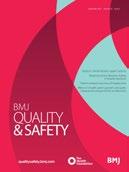
The ANZCA Library has picked up a new subscription to BMJ Quality & Safety BMJ Quality & Safety is a peer-reviewed healthcare journal dealing with improving patient safety and quality of care. Its sister publication – BMJ Open Quality – has also been added to the college library collection.
The library is also delighted to announce that following numerous requests, we’re trialling a new subscription to
For the latest updates and a complete list of new titles check out the library news page: libguides.anzca.edu.au/news


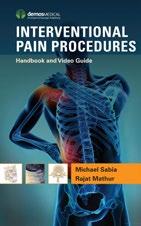
the journal Perfusion Perfusion is a peer-reviewed scholarly journal, providing current information on all aspects of perfusion, oxygenation and biocompatibility and their use in modern cardiac surgery.
In addition, following the trial of the journal Neuromodulation at the start of 2023, we’ve extended the trial subscription until the end of 2024. The library welcomes any feedback concerning this and the Perfusion trial.
You can access all our new journals via the Journals page (https://libguides.anzca.edu.au/journals) or via our BrowZine app (https://libguides.anzca.edu.au/apps/browzine). Learn more about our trials on our trials page: https://libguides. anzca.edu.au/trials
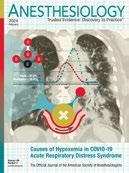
Following continuing access issues with articles-in-press for our Ovid/LWW journals – impacting popular journals such as Anesthesiology, Anesthesia & Analgesia, Critical Care Medicine, EJA and Pain – the library is changing the way we access these journals. The alternate/direct access links on the library journals page allows direct access the individual LWW journal sites along with all of its contents (including content only available from the individual sites). The article linking for BrowZine/LibKey has been updated to ensure access to LWW articles-in-press as soon as they are indexed.
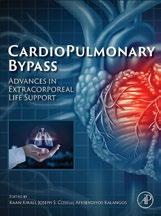
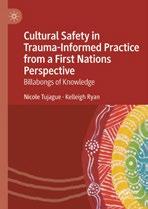

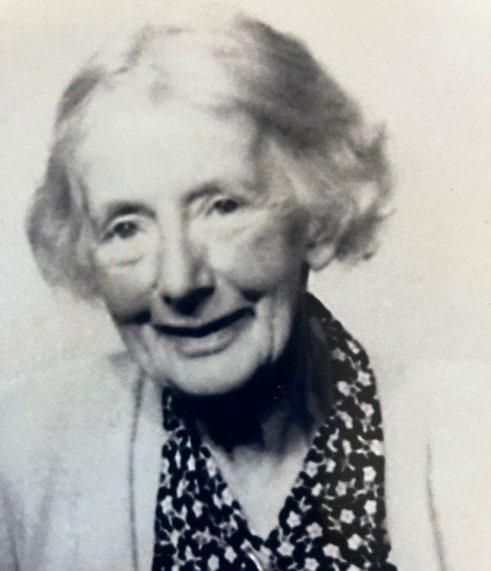

The History and Heritage Research Grant for 2023 was awarded to Zana Bell, a history fellow at the University of Auckland.
Dr Bell's project “Alice, Auckland and Anaesthesia” (working title) is a socio-medical biography of Auckland’s first woman doctor and anaesthetist. Alice Horsley (1871-1957) was one of the first six women to graduate from the Otago medical school. The text aims to provide an accessible account of the developments of anaesthesia in the first half of the twentieth century through Alice’s lived experience, depicting a visceral “insider” story as opposed to scholarly histories of the specialty.
Dr Bell has started conducting research using the Geoffrey Kaye Museum of Anaesthetic History’s archives and artefacts.
During this 90-minute introductory workshop, Suzanne Mulligan, an oral history expert will demonstrate how insights can be gained through oral history by interviewing a past or present colleague. This workshop will explain the basics of how to conduct an oral history interview to share knowledge and stories of medical history and inspire participants to learn more about oral history interviewing.
Register at asm.anzca.edu.au to attend the “Recording the past” workshop at the ANZCA Annual Scientific Meeting in Brisbane on Friday 3 May 2024.
Members of the History and Heritage Advisory Panel were saddened to hear about the passing of Dr John Williamson in October 2023. Dr Williamson was a leader and mentor to many in anaesthesia and hyperbaric medicine. After retiring from clinical practice he worked as a volunteer guide for the Geoffrey Kaye Museum of Anaesthetic History.
Read his obituary on page 84.
FROM TOP
Alice Horsley. With thanks to Anne Morris, Alice’s grand-daughter.
Zana Bell in the Geoffrey Kaye Museum storeroom looking through objects, March 2024.
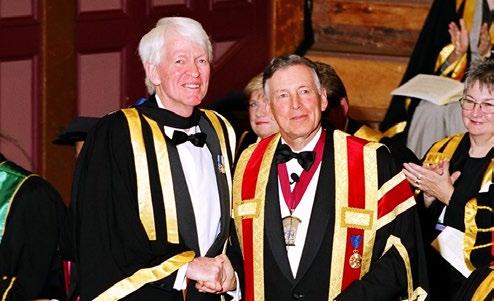
John Williamson was one of life’s special people. Many knew him in their shared specialty roles of anaesthesia and hyperbaric medicine. Some knew him as a polymath with a deep knowledge of marine toxicology, lifesaving, diving medicine, pre-hospital care, military medicine and of medical history. The profession mourns the passing of this humble and esteemed colleague.
John was born in Chinchilla, Queensland, on 28 June 1936. His early years were spent in the family bakery business in Caloundra where, as a school-age boy, his love of the sea saw its genesis. He well recalled the dramatic event when, in May 1943, whilst walking along Caloundra’s surfing beach, he found an army boot washed up with a foot in it — a tragic relic of the sinking of the Australian hospital ship, HMHS Centaur, offshore.
He studied at The Southport School and enrolled in the faculty of medicine at the University of Queensland. In 1959, he intermitted for an extra year of experimental biochemistry in the department of biochemistry. It was during that year that he met his wife, Noelene, a biochemist and tutor in the biochemistry department.
John graduated MBBS in December 1962, and under the terms of his undergraduate state scholarship worked for the next seven years in North Queensland. He completed his registration year at the Townsville General Hospital (1963) and was appointed as the medical superintendent in Muttaburra (1964-1966). He worked as a general medical practitioner in Innisfail in 1967 and 1968, before commencing his training as an anaesthetist, initially at the Royal Melbourne Hospital, The Alfred hospital (1969) and at the Royal Women’s Hospital and the Royal Children’s Hospital in Melbourne in 1970.
His distinguished career as an anaesthetist included a consultant’s role at the Townsville General Hospital, conjointly as the director of the hyperbaric unit at the Townsville Hospital. In Townsville he took a leading role in the discipline of marine toxicology and was an active lifesaver. For this service he was elected to honorary life membership of Surf Life Saving Australia.
He was an active member in the training branch of St John Ambulance Australia, serving for a period as its representative
on the Australian Resuscitation Council. For his lifelong service to prehospital care, he was decorated with the Order of St John. He was also a consultant to the Royal Life Saving Society and contributed much to the published doctrine of both these leading bodies.
John was appointed as the director of diving and hyperbaric medicine at the Royal Adelaide Hospital in 1990 and served in the Diving Emergency Service (DES). This emergency advisory hotline provided prompt and expert advice to callers concerning the management of diving-related injury throughout the Asia-Pacific region.
John was an enthusiastic supporter of the establishment of the Divers Alert Network (DAN) in Australia and was one of its senior medical advisers. At the Royal Adelaide Hospital he and Professor Bill Runciman began their advocacy for improved patient safety. Together, they were instrumental in establishing the Anaesthesia Incident Monitoring Study (AIMS). John’s publications, dating from 1978, in the domain of patient safety, were pioneering in Australia.
He had interests in the physiology and pathophysiology of aviation medicine and was an active member of the RAAF Specialist Reserve. In this role he recruited colleagues to take part in research which studied loading casualties from a “hostile environment” into Black Hawk helicopters; and subsequently, the management of patients in-flight during evasive manoeuvres, while at the same time resuscitating a monitored manikin. After his retirement, one of his proudest forms of volunteer service was as a uniformed guide at the Shrine of Remembrance in Melbourne.
John was a member of a bewildering number of aquaticrelated organisations including the Australian Society of Anaesthetists, the South Pacific Underwater Medicine Society, the Undersea and Hyperbaric Medical Society, the Anesthesia Patient Safety Foundation and ANZCA.
He was one of the best authorities on the pathophysiology resulting from both fatal and near-fatal drowning. His decoration, as a Member in the Order of Australia in 1998 encapsulated much of the life of service which he gave to the nation.
John was a passionate vexillologist and owned more than 300 different flags which he flew on appropriate days. Wherever he lived he had a flagpole erected in his garden. On leaving Townsville Hospital he was presented with a personal flag featuring a box jellyfish which he flew on his birthday. He was also an avid BMW motorbike rider — and evinced a hint of derision whenever he encountered loud Harley-Davidson machines with their strange seating and handlebars!
He was a man who enjoyed life and made the most from it. Esteem to his memory.
Emeritus Professor John Pearn AO FRACP
Senior paediatrician, Queensland Children’s Hospital
Dr Roger Capps AM FANZCA
Retired senior anaesthetist, Adelaide
Dr John Lippmann OAM
Chair and Chief Executive Officer, Australasian Diving Safety Foundation
ABOVE
Dr Williamson (left) receiving the ANZCA Medal in 2004.

On 19 February the anaesthesia fraternity of Malaysia mourned the loss of one of its pillars, Professor Emeritus Dr Alexius Ernald Delilkan, a distinguished and beloved member.
Professor Delilkan graduated as a doctor from the University of Malaya, Singapore in 1960. In June 1965, he joined the department of anaesthesiology, faculty of medicine, University of Malaya in Kuala Lumpur. He then rose to the position of Associate Professor in 1970 and succeeded to the chair in anaesthesiology in July 1978.
In a string of firsts for the country, Professor Delilkan was instrumental in establishing the accident and emergency facilities in July 1967, intensive care unit (1968/1969), chronic pain clinic (1988) and acute pain services (1992/93).
In 1978, inspired while being an external examiner for the Australian fellowship examination in anaesthesiology in Kuala Lumpur, he became instrumental in designing and writing the blueprint for postgraduate training and certification in anaesthesiology in Malaysia – the Master in Anaesthesiology program.
Always a leader in the medical field, Professor Delilkan was part of the team involved in the first successful separation of conjoint twins in 1981 and the first successful delivery of quintuplets in 1986 in Malaysia.
He introduced the concept of drain death in the intensive care unit setting in Malaysia in 1980 and undertook a revision of the Human Tissue Act 1974 with the law faculty, University of Malaya to establish the national transplantation program in 1998.
Professor Delilkan was the founding president of the Malaysian Association for the Study of Pain (MASP) and was also past president of the Medico-legal Society Malaysia and the Malaysian Association of Anaesthesiologists (MSA).
As an anaesthesiologist, Professor Delilkan was never lured away to the more lucrative private practice. A true and wellloved teacher who taught numerous doctors throughout the country, he achieved his wealth in the pride and joy of nurturing and seeing his students succeed and shine.
In addition to being one of the leaders in the fraternity of anaesthesiology, he was also the author of 17 books and 106 papers on anaesthesiology and critical care, published in both national and international medical journals. In 2004 he was conferred Professor Emeritus by University Malaya’s faculty of medicine.
Even at 84 he still taught anaesthesiology and critical care to medical undergraduates at four universities. And until two years ago at the age of 88, he was still providing consulting services for medico-legal cases in the country.
He was also a man of wit, and I always remember, as a medical student, the first teaching ward rounds with him, when he told us with a straight face: “There were two great contributions to anaesthesiology in the year 1934; the first one being the discovery of the anaesthetic drug sodium thiopentone; and the second one being the birth of Alex Delilkan!”
Professor Delilkan was not only an icon in the medical field but a legendary athlete. A national cricketer from 1955 to 1972, and the national cricket captain from 1959 to 1972, he became well known as a great all-rounder who excelled in every department of the game he played. He will always be remembered as the Malaysian player who bowled out the legendary Sir Garfield Sobers first ball, at Dataran Merdeka in 1962, in what Gary Sobers described as the perfect leg break ball he had ever faced. In 2010 he was inducted into the Olympic Council of Malaysia Hall of Fame, for his contributions to the country as a cricketer and national cricket captain.
As a frequent expert witness in court in medico-legal cases he always believed that his opinion in the court of law was not to take sides but to provide an unbiased medical opinion.
When called to the court his opening statement to the judge would always be: “My Lord, I have come to your court to present my unbiased expert opinion, hopefully to help you come to a just decision.”
As we mourn the loss of someone who has contributed so much to the field of anaesthesiology, let us also remember to celebrate his accomplishments and hope that all his achievements will not be forgotten by his students, peers and the community.
Dr Anselm Suresh Rao Consultant Anaesthesiologist, Gleneagles Kuala Lumpur, Malaysia
*Correction: In the Summer 2023 edition of the ANZCA Bulletin the headline date of birth for Patricia Coyle’s obituary should have read 1929 not 1927
Avant rewards member loyalty. And we’re there when it matters.
y Receive premium rebates through our Loyalty Reward Plan*
y Dividends paid out when you retire through our Retirement Reward Plan^
y Access medico-legal experts, 24/7 in emergencies
y Local support, from Avant Law’s 80+ medico-legal solicitors nationwide
y Expert advice to reduce your claims risk
